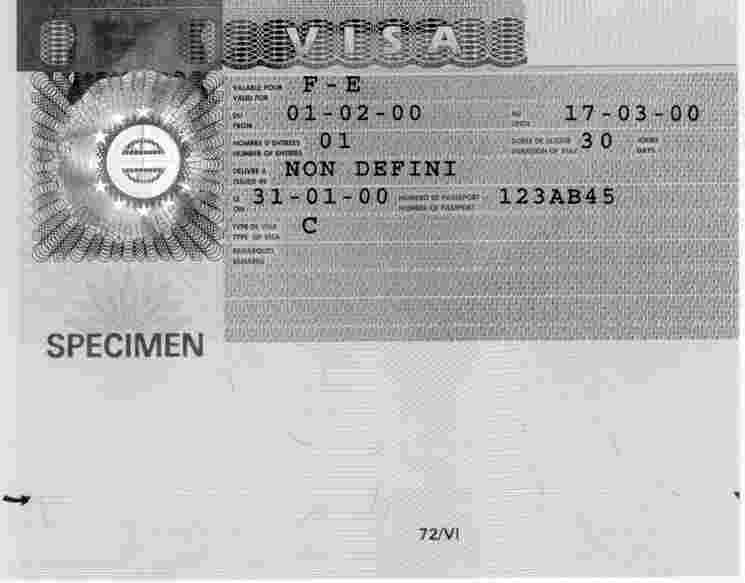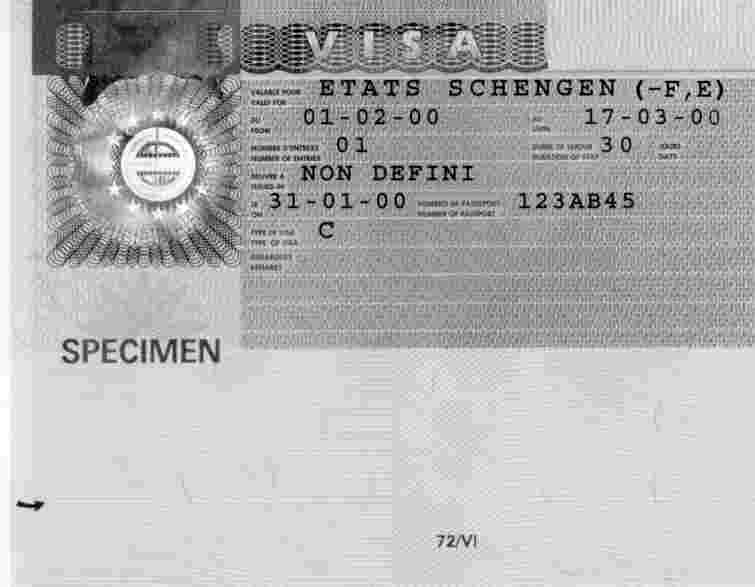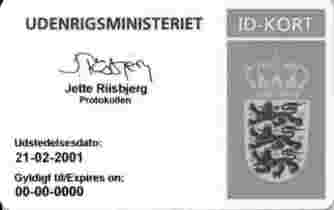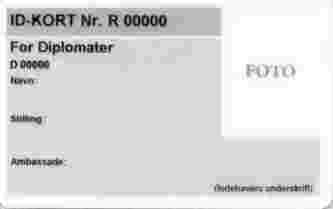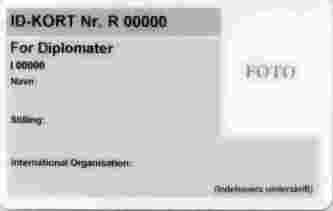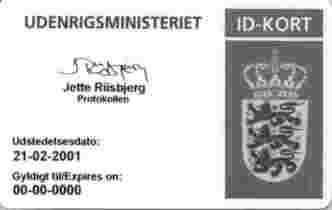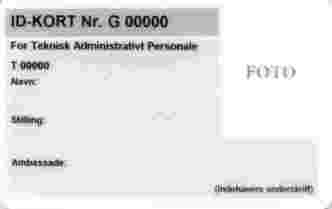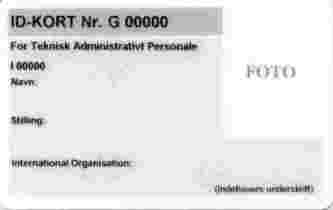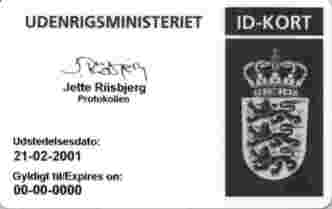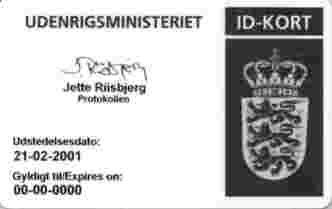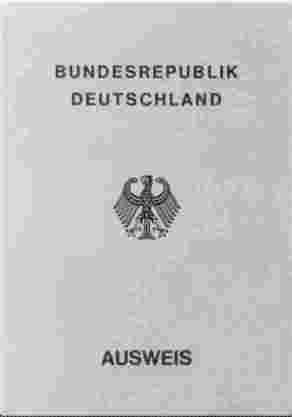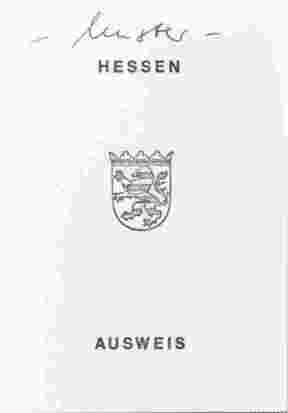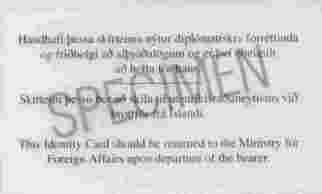

This document is an excerpt from the EUR-Lex website
Document 32002X1216(03)
Common Manual
Common Manual
Common Manual
OJ C 313, 16.12.2002, p. 97–335
(ES, DA, DE, EL, EN, FR, IT, NL, PT, FI, SV)
 No longer in force, Date of end of validity: 12/10/2006; Repealed by 32006R0562
No longer in force, Date of end of validity: 12/10/2006; Repealed by 32006R0562
|
16.12.2002 |
EN |
Official Journal of the European Communities |
C 313/97 |
COMMON MANUAL
(2002/C 313/02)
INTRODUCTORY NOTE
The Common Manual, as adopted by the Executive Commitee stablished by the Convention implementing the Schengen Agreement of 14 June 1985 (listed under reference SCH/Com-ex (99) 13 in annex A to Council Decision 1999/435/EC OJ L 176, 10.7.1999, p. 1), has since been amended on several occasions pursuant to the provisions of Council Regulation (EC) No 790/2001 of 24 April 2001 (OJ L 116, 26.4.2001, p. 5). The Common Manual, as amended to date, is published here following the adoption of two Council Decisions declassifying the text of the Common Manual itself and all but three of its Annexes (see Council Decision 2000/751/EC (OJ L 303, 2.12.2000, p. 29) and Council Decision 2002/535/EC (OJ L 123, 9.5.2002, p. 49)).
TABLE OF CONTENTS
PART I: CONDITIONS FOR ENTERING THE TERRITORY OF THE CONTRACTING PARTIES
|
1. |
Crossing external borders | 100 |
|
1.1. |
Consequences of authorisation to enter | 100 |
|
1.2. |
Crossing the border at authorised border crossing points | 100 |
|
1.3. |
Crossing the border at places other than authorised border crossing points | 100 |
|
2. |
Documents recognised as valid for the crossing of external borders | 100 |
|
3. |
Visas required of aliens entering the territory of the Contracting Parties | 101 |
|
3.1. |
Uniform visas for stays not exceeding three months, including transit visas | 102 |
|
3.2. |
Visas with limited territorial validity | 102 |
|
3.3. |
Visas for a stay of over three months | 102 |
|
4. |
Other conditions for entry | 102 |
|
4.1. |
Documentary evidence or information establishing the likelihood of the reason given for entry | 102 |
|
4.2. |
Conditions relating to security | 103 |
PART II: BORDER CHECKS
|
1. |
Principles governing checks | 104 |
|
1.1. |
Officers authorised to carry out checks and surveillance | 104 |
|
1.2. |
Purpose of checks | 105 |
|
1.3. |
Procedures for checks | 105 |
|
1.4. |
Procedures for refusing entry | 106 |
|
2. |
Practical procedures for checks | 107 |
|
2.1. |
Affixing stamps | 107 |
|
2.2. |
Surveillance of external borders at places other than crossing points and outside office opening hours | 107 |
|
2.3. |
The following information must be entered in a register | 108 |
|
3. |
Special rules on the various means of transport used for crossing external borders | 108 |
|
3.1. |
Checks on road traffic | 108 |
|
3.2. |
Checks on rail traffic | 108 |
|
3.3. |
Checks on international civil air traffic | 109 |
|
3.4. |
Checks on maritime traffic | 111 |
|
3.5. |
Checks on inland waterways shipping | 113 |
|
4. |
Cooperation | 113 |
|
4.1. |
Exchange of information | 113 |
|
4.2. |
Liaison officers | 113 |
|
5. |
Issuing visas at the border | 114 |
|
6. |
Special arrangements | 114 |
|
6.1. |
Nationals of the Member States of the European Community and members of their families from third countries | 114 |
|
6.2. |
Aliens holding a residence permit issued by another Contracting Party | 115 |
|
6.3. |
Statutory refugees and stateless persons | 115 |
|
6.4. |
Pilots of aircraft and other crew members | 115 |
|
6.5. |
Seamen | 115 |
|
6.6. |
Holders of diplomatic, official or service passports | 116 |
|
6.7. |
Cross-border workers | 116 |
|
6.8. |
Minors | 116 |
|
6.9. |
Group trips | 116 |
|
6.10. |
Aliens who submit an application for asylum at the border | 116 |
|
6.11. |
Members of international organisations | 117 |
ANNEXES TO THE COMMON MANUAL
|
1. |
Authorised border crossing points | 118 |
|
2. |
Penalties for unauthorised crossing of borders (1) | 151 |
|
3. |
Bilateral agreements on local border traffic (1) | 151 |
|
4. |
Criteria for determining whether a travel document may bear a visa | 151 |
|
5. |
I. Common list of third countries the nationals of which are subject to the vise requirement imposed by Regulation (EC) No 539/2001, as amended by Regulation (EC) No 2414/2001 | 152 |
| II. Common list of third countries the nationals of which exempt from the visa requirement imposed by Regulation (EC) No 539/2001, as amended by Regulation (EC) No 2414/2001 | 152 |
| III. Regulations governing the movement of holders of diplomatic, official duty and service passports, and holders of laissez-passers which certain International Intergovernmental Organisations issue to their officials | 152 |
|
5a. |
Common list of third countries whose nationals are subject to an airport transit visa requirement, where holders of travel documents issued by these third countries are also subject to this visa requirement | 159 |
|
6. |
Uniform format for visa stickers and information on their technical specifications and security features | 163 |
|
6a. |
How to fill in visa stickers | 169 |
|
6b. |
Entries which the Contracting Parties shall write, where necessary, in the ‘remarks’ section | 190 |
|
6c. |
Instructions on writing entries in the section to be electronically scanned | 190 |
|
7. |
Specimen visa stickers | 191 |
|
8. |
Specimen visas with limited territorial validity | 199 |
|
8a. |
Rules and procedures governing information to be sent by Contracting Parties when issuing visas with limited territorial validity, when cancelling, revoking and reducing the duration of validity of uniform visas and when issuing national residence permits | 203 |
|
9. |
Specimen long-stay visa | 206 |
|
10. |
Reference amounts required for crossing borders fixed annually by the national authorities | 207 |
|
11. |
List of documents giving entitlement to entry without a visa | 212 |
|
12. |
Specimen separate sheets | 230 |
|
13. |
Specimen cards issued by the Ministry of Foreign Affairs | 244 |
|
14. |
Issue of uniform visas at borders | 333 |
|
14a. |
Fees, in euro, to be charged when issuing uniform visas | 334 |
|
14b. |
List of visa applications requiring prior consultation with the central authorities, in accordance with Article 17(2) | 335 |
(1) Annexes 2 and 3 have been deleted by Council Decision 2002/352/EC (OJ L 123, 9.5.2002, p. 47). Applicable since 1 June 2002.
The entry into force of the Convention implementing the Schengen Agreement entails the abolition of checks at internal borders and moving them to external borders. As a result, the checks carried out at the external borders of the area covered by the Convention, benefit not only the States at whose external borders they are carried out but also all the Contracting Parties, whose interests must be taken into account by the officials carrying out such checks.
PART I: CONDITIONS FOR ENTERING THE TERRITORY OF THE CONTRACTING PARTIES
1. Crossing external borders
Article 3 of the Implementing Convention
|
‘1. |
External borders may in principle only be crossed at border crossing points and during the fixed opening hours. More detailed provisions, exceptions and arrangements for local border traffic, and rules governing special categories of maritime traffic such as pleasure boating and coastal fishing, shall be adopted by the Executive Committee. |
|
2. |
The Contracting Parties undertake to introduce penalties for the unauthorised crossing of external borders at places other than crossing points or at times other than the fixed opening hours’ |
1.1. Consequences of authorisation to enter
A person who has lawfully entered the territory of one of the Contracting Parties by its external border may normally move about freely within the territory of all the Contracting Parties during a period not exceeding three months.
1.2. Crossing the border at authorised border crossing points
External borders may be crossed at the authorised border crossing points provided for in Annex 1 during the stipulated opening hours. ‘The unauthorised crossing of external borders at places other than border crossing points or at times other than the fixed opening hours is punishable by the penalties provided for by national law’ (1). Opening hours must be indicated at border posts by a notice.
1.3. Crossing the border at places other than authorised border crossing points
(…)
|
— |
persons in respect of whom provision is made for the appropriate permits under bilateral agreements on local border traffic, — known in Italy as ‘local border traffic’ or ‘excursion traffic’ (1). |
|
— |
seamen who go ashore in accordance with point 6.5.2. |
|
1.3.1. (2) |
The competent authorities under national law may issue individuals or groups of persons with a special permit enabling them to cross the external border at places other than authorised crossing points or outside the stipulated times:
In all cases, such a permit may be issued only if the person requesting it produces the necessary documents when crossing the border. |
|
1.3.2. |
Nationals of the Kingdom of Belgium, the Kingdom of Denmark, the French Republic, the Grand Duchy of Luxembourg and the Kingdom of the Netherlands shall be authorised to cross, at any point, the borders of the State whose nationality they hold. |
|
1.3.3. |
Derogations from the provisions of point 1.2. in connection with local border traffic, known in Italy as ‘local border traffic’ or ‘excursion traffic’, are granted in accordance with the bilateral agreements concluded by the Member States with bordering third States (1). |
2. Documents recognised as valid for the crossing of external borders
Article 5 of the Implementing Convention:
|
‘1. |
For stays not exceeding three months, aliens fulfilling the following conditions may be granted entry into the territories of the Contracting Parties:
|
|
2. |
An alien who does not fulfil all the above conditions must be refused entry into the territories of the Contracting Parties unless a Contracting Party considers it necessary to derogate from that principle for humanitarian grounds, on grounds of national interest or because of international obligations. In such cases authorisation to enter will be restricted to the territory of the Contracting Party concerned, which must inform the other Contracting Parties accordingly. |
These rules shall not preclude the application of special provisions concerning the right to asylum or the provisions laid down in Article 18.
|
3. |
Aliens who hold residence permits or re-entry visas issued by one of the Contracting Parties or, where required, both documents, shall be authorised entry for transit purposes, unless their names are on the national list of alerts of the Contracting Party whose external borders they are seeking to cross’ |
|
2.1. |
A list, for each country, of the documents recognised as valid for the crossing of external borders and of those which may bear a visa, in the case of aliens subject to the visa requirement, is set out in Annex 4. A list of, and specimen residence permits and return visas, provided for under Article 5(3) of the Convention implementing the Schengen Agreement, are set out in Annex 11. |
3. Visas required of aliens entering the territory of the Contracting Parties
Article 10 of the Convention
|
‘1. |
A uniform visa valid for the entire territory of the Contracting Parties shall be introduced. This visa, the period of validity of which shall be determined by Article 11, may be issued for visits not exceeding three months. |
|
2. |
Pending the introduction of such a visa, the Contracting Parties shall recognise their respective national visas, provided that these are issued in accordance with common conditions and criteria determined in the context of the relevant provisions of this Chapter. |
|
3. |
By way of derogation from paragraphs 1 and 2, each Contracting Party shall reserve the right to restrict the territorial validity of the visa in accordance with common arrangements determined in the context of the relevant provisions of this Chapter’ |
Article 11 of the Convention
|
‘1. |
The visa provided for in Article 10 may be:
|
|
2. |
Paragraph 1 shall not preclude a Contracting Party from issuing a new visa, the validity of which is limited to its own territory, within the half-year in question if necessary’ |
Pending the introduction of a uniform visa, the Contracting Parties will recognise, for all types of visas, their respective national visas. The uniform stick-in visa will be used for:
|
— |
uniform visas for stays not exceeding three months, |
|
— |
transit visas, |
|
— |
visas of limited territorial validity for stays not exceeding three months, |
|
— |
visas for stays of over three months. |
3.1. Uniform visas for stays not exceeding three months, including transit visas
|
3.1.1. |
A list of States for whose nationals a visa is required by all the Contracting Parties is given in Annex 5. The uniform visa will be issued to the nationals of the States appearing on that list. Aliens subject to a visa requirement by only one Contracting Party must also obtain a uniform visa from that Contracting Party, having regard to the provisions of Article 5(1) of the Convention; this visa will state that the holder is required to hold a visa only by the Contracting Party concerned. Where an alien is required to hold a visa by several Contracting Parties, the uniform visa issued by one of these Contracting Parties in accordance with the provisions of this point (third sentence) will also be valid for the other Contracting Parties requiring the alien to hold a visa. |
|
3.1.2. |
A technical description of the stick-in visa is given in Annex 6. Details of how to complete the stick-in visa are set out in Annex 6a. The details to be completed by the Contracting Parties, where necessary, under ‘comments’ are set out in Annex 6b. The instructions on completing details in the optical reading area are given in Annex 6c. |
|
3.1.3. |
Specimen stick-in visas with examples of possible endorsements are given in Annex 7. |
|
3.1.4. |
The endorsements printed on the stick-in visa are to be in English, French and the respective national languages. |
3.2. Visas with limited territorial validity
|
3.2.1. |
Visas with limited territorial validity shall be issued by:
|
|
3.2.2. |
A visa with limited territorial validity is a national visa whose validity is limited to the territory of the State(s) which issued it. This visa does not enable its holder to invoke Article 19 of the Convention for the purposes of staying in the territory of the other Contracting Parties. |
|
3.2.3. |
A visa with limited territorial validity shall be identified in a specific manner. A specimen of this type of visa is shown in Annex 8. |
|
3.2.4. |
Rules and procedures governing information to be sent by Contracting Parties when issuing visas with limited territorial validity, when cancelling, revoking and reducing the duration of uniform visas and when issuing national residence permits are described in Annex 8a. |
3.3. Visas for a stay of over three months
|
3.3.1. |
Long-stay visas are national visas. They allow the holder to travel through the territory of the other Contracting Parties only in order to go to the territory of the Contracting Party which issued the visa, unless he fails to meet the conditions for entry laid down in Article 5(1)(a), (d) and (e) of the Convention or if he appears on the national alert list of the Contracting Party through whose territory transit is requested. |
|
3.3.2. |
A specimen long-stay visa is shown in Annex 9. |
4. Other conditions for entry
Article 6(1) of the Convention
|
‘1. |
Cross-border movement at external borders shall be subject to checks by the competent authorities. Checks shall be carried out for the Contracting Parties' territories, in accordance with uniform principles, within the scope of national powers and national law, and taking account of the interests of all Contracting Parties.’ |
4.1. Documentary evidence or information establishing the likelihood of the reasons given for entry
It is for the alien to provide on request the reason for his application to enter the territory. In the event of doubt, the checking officers may require him to produce supporting documents and papers as proof or to show good faith.
|
4.1.1. |
In order to provide proof or to establish the likelihood of the reasons given for entry, the following may in particular be required:
|
|
4.1.2. |
Aliens wishing to enter the territory of the Contracting Parties must have sufficient means of subsistence for the expected duration of the stay and for the return journey or transit to a third State. Means of subsistence shall be assessed in accordance with the purpose of the stay and by reference to average prices for board and lodging. The reference amounts set each year by each of the Contracting Parties are shown in Annex 10. The presumption of sufficient means of subsistence will be based, for example, on the cash, travellers' cheques, credit cards, and the appropriate number of Eurocheques supported by a Eurocheque card and statements in respect of guarantees in the alien's possession. |
4.2. Conditions relating to security
When an alien enters the territory, a check must be carried out to determine whether the alien, his vehicle or the objects in his possession represent a threat to the public policy, national security or international relations of any of the Contracting Parties. Such a threat may in particular exist where:
|
— |
the alien has been convicted of an offence carrying a custodial sentence of at least one year, |
|
— |
there are serious grounds for believing that the alien has committed serious offences, including those referred to in Article 71 of the Convention, or that he intends to commit such offences in the territory any of the Contracting Parties, |
|
— |
the alien has been the subject of a deportation, removal or expulsion measure and the measure is accompanied by an actual prohibition on entry or residence or entails such a prohibition. |
(Article 96(2) and (3) of the Convention).
The entry into force of the Convention implementing the Schengen Agreement entails the abolition of checks at internal borders and moving them to external borders. As a result, the checks carried out at the external borders of the area covered by the Convention benefit not only the States at whose external borders they are carried out but also all the Contracting Parties, whose interests must be taken into account by the officials carrying out such checks.
PART II: BORDER CHECKS
1. Principles governing checks
Article 6(2) of the Convention
|
‘2. |
The standard principles referred to in paragraph 1 shall be as follows:
|
1.1. Officers authorised to carry out checks and surveillance
|
1.1.1. |
Checks at external borders are to be carried out by officers of the border police forces or of the services of the Contracting Parties responsible in accordance with national law for border police duties. These services are:
|
|
1.1.2. |
When carrying out these duties, officers are vested with the powers of border police and the powers to instigate criminal proceedings conferred on them by national law. |
1.2. Purpose of checks
|
1.2.1. |
Checks on movements at external borders will cover:
|
|
1.2.2. |
The principle of proportionality must be complied with in the performance of border police duties. |
1.3. Procedures for checks
Checks on movements and surveillance are effective if they cope with the risks that result from the various situations encountered. This should be assessed by the competent national authorities cooperating with the authorities of the Contracting Parties.
The Contracting Parties shall carry out checks at external borders in accordance with the following uniform principles:
|
1.3.1. |
the minimum check referred to in Article 6(2)b of the Convention which is intended to establish a person's identity, consists of an identity check on the basis of the travelling documents produced or presented and in rapid and straightforward verification of the validity of the document authorising the holder to cross the border and of the presence of signs of falsification or counterfeiting. |
|
1.3.2. |
the thorough check referred to in Article 6(2)c involves, in addition to the basic check:
|
|
1.3.3. |
Without prejudice to the provisions of points 1.3.5.1, 1.3.5.2 and 1.3.5.3, all persons shall be subject to a minimum check upon entry and exit. As a general rule, aliens shall be subject to a thorough check on entry and exit. |
|
1.3.4. |
Nationals of the Member States of the European Community shall be subject to random thorough checks on entry and on exit in certain cases where there is reason to believe that the persons concerned might compromise public policy, national security or health. |
|
1.3.5. |
Checks at land borders may be relaxed as a result of special circumstances. This will be the case, in particular, where the intensity of traffic results in excessive delay in the time taken to reach checking posts, and all resources have been exhausted as regards staff, facilities and organisation.
|
1.4. Procedures for refusing entry
|
1.4.1. |
The decision to refuse entry is to be substantiated and will be effective immediately (or, where appropriate, on expiry of the time limit laid down by national law), whereby an alien who does not fulfil the conditions for entry laid down in Article 5 of the Convention is not allowed to enter the territory any of the Contracting Parties or to stay there. The alien must acknowledge receipt of the decision. The decision is taken by the authority empowered to do so by national law which shall state the procedures for appeal where these exist. |
|
1.4.1a |
When refusing entry, the checking officer will affix an entry stamp on the passport, cancelled by an indelible cross in black ink. |
|
1.4.2. |
Officers responsible for checks will ensure that an alien refused entry does not enter the territory of the Contracting Party or, if he has already entered it, leaves immediately. |
|
1.4.3. |
If an alien, refused entry, has been brought to the border by a carrier by air, sea or land, the authority responsible locally must order that carrier to assume responsibility for the alien without delay. The carrier may be made to bear the costs of lodging, maintenance and the return journey. The authority responsible locally must order the alien to be transported to the third State from which he was brought, to the third State which issued the document authorising him to cross the border, or to any other third State where he is guaranteed admittance. If the carrier cannot comply with the onward transportation order immediately, he must ensure that another carrier effects immediate transportation to a third State. Pending onward transportation, the authority responsible locally is required, in compliance with national law and having regard to local circumstances, to take appropriate measures in order to prevent aliens refused entry from entering illegally (e.g. by keeping them in the international area of the airport, prohibiting them from going ashore in ports or keeping them in a detention centre). |
|
1.4.4. |
Where the officer responsible for checks notes that the holder of a short-stay visa has been the subject of an alert in the SIS for the purposes of being refused entry, he shall cancel the visa by applying a stamp stating ‘CANCELLED’. He must inform his central authorities of this decision forthwith. If the holder of a short-stay visa is refused entry, the provisions laid down in point 1.4.1(a) must be applied. |
|
1.4.5. |
Any refusal of entry must be recorded in a register or on a list stating identity, nationality, the references of the document authorising the alien to cross the border and the reason for and date of refusal of entry. |
|
1.4.6. |
If there are grounds both for refusing an alien entry and arresting him, the judicial authorities responsible must be contacted to decide on the action to be taken in accordance with national law. |
|
1.4.7. (3) |
Specific arrangements for persons entitled under Community law (citizens of the European Union, nationals of States parties to the Agreement on the European Economic Area and nationals of the Swiss Confederation, and members of their families) are described in points 6.1.1 to 6.1.4. The provisions of points 1.4.2, 1.4.5 and 1.4.6 shall also apply to citizens of the European Union, nationals of States parties to the Agreement on the European Economic Area and nationals of the Swiss Confederation. In addition to the provisions mentioned in the second subparagraph, the provisions of points 1.4.1(a), 1.4.3, 1.4.4, 1.4.8 (subject to the provisions of point 6.1.4) and 1.4.9 shall also apply to members of the families of citizens of the European Union, nationals of States parties to the Agreement on the European Economic Area and nationals of the Swiss Confederation, who are not nationals of one of those States. |
|
1.4.8. |
If an alien who does not fulfil the conditions for entry given in Article 5(1) of the Convention invokes the provisions of Article 5(2) of the Convention and requests entry and transit by the external border of a Contracting Party other than the one which has agreed, by way of exception to allow him to reside there, he must be sent back and allowed to present himself at the external border of the latter Contracting Party, for the purpose of entering its territory. |
|
1.4.9. |
If, in addition to a valid travel document, an alien is in possession of a residence permit or a return visa or, where appropriate, both these documents, issued by one of the Contracting Parties, as provided for in Annex 11, he must be authorised to enter and pass through so that he can reach the territory of that Contracting Party, unless an alert has been entered on this alien in the national list of the Contracting Party at whose external border he requests entry and where that alert does not specify action to be taken to prevent entry and transit. |
2. Practical procedures for checks
2.1. Affixing stamps
|
2.1.1. |
When the territory of a Contracting Party is entered, a stamp shall be affixed to:
No entry stamp shall be affixed to the documents of nationals of the Member States of the European Community. |
|
2.1.2. |
The exit stamp shall be placed on documents authorising an alien to cross the border which contain a multiple-entry visa with a restriction on the total length of stay. |
|
2.1.3. |
Upon initial entry, the stamp must, if possible, be affixed so that it covers the edge of the visa without affecting the legibility of the indications on the visa or the security features of the stick-in visa. If several stamps have to be inserted (for example in the case of a multiple-entry visa), this shall be done on the page facing the one on which the visa is affixed. If that page cannot be used, the stamp will be entered on the following page. |
|
2.1.4. |
Different shaped stamps (rectangular for entry, rectangular with rounded corners for exit) will be used to certify entry and exit. These stamps will contain the letter(s) identifying the State, the name of the border post, the date, the serial number and a pictogram indicating the type of border crossed (land, sea or air). |
|
2.1.5. |
Entry and exit stamps shall not be affixed:
|
|
2.1.6. |
Exceptionally, at the request of an alien, insertion of an entry or exit stamp may be dispensed with if insertion might cause serious difficulties for that person. In that case, entry or exit must then be recorded on a separate sheet indicating the name and passport number. |
2.2. Surveillance of external borders at places other than crossing points and outside office opening hours
Article 6(3) of the Convention
|
‘3. |
The competent authorities shall use mobile units to carry out surveillance on external borders between crossing points; the same shall apply to border crossing points outside normal opening hours. This surveillance shall be carried out in such a way as to discourage people from circumventing the checks at crossing points. The surveillance procedures shall, where appropriate, be established by the Executive Committee’ |
|
2.2.1. |
The main purpose of surveillance of external borders at places other than border crossing points and surveillance of these crossing points outside opening times is to prevent unauthorised border crossings, to counter cross-border criminality and to apply or to take measures against individuals who have crossed the border illegally. |
|
2.2.2. |
Such surveillance shall be carried out in accordance with police tactical criteria, by appropriate numbers of staff for the situation in hand. It will involve frequent and sudden changes to surveillance periods, so that unauthorised border crossings will be an ongoing risk. |
|
2.2.3. |
Surveillance shall be carried out by mobile units which perform their duties by patrolling or stationing themselves at places known or perceived to be sensitive, the aim of such surveillance being to apprehend individuals crossing the border illegally. Surveillance may also be carried out by technical means, including electronic means. |
|
2.2.4. |
The resources used shall be selected in accordance with the conditions of intervention and in particular in accordance with the type and nature of the border (land, inland waterway or sea). |
2.3. The following information must be entered in a register
|
— |
the names of the official responsible locally for border checks and of the other officers in each team, |
|
— |
relaxation of checks on persons applied in accordance with point 1.3.5, |
|
— |
the issuing of documents in place of passports and of visas or permits issued at the border, |
|
— |
persons apprehended and complaints (criminal offences and administrative breaches), |
|
— |
persons refused entry or exit (number and nationalities), |
|
— |
other particularly important police or judicial measures, |
|
— |
particular occurrences. |
At all border (land, sea and airport) posts all service information and any other particularly important information shall be entered in a register.
3. Special rules on the various means of transport used for crossing external borders
3.1. Checks on road traffic
|
3.1.1. |
To ensure effective checks on persons, while ensuring the safety and smooth flow of road traffic, movements at border crossing points must be regulated in an appropriate manner. In case of need, measures to channel and block traffic will be taken in compliance with the agreements on colocated national control offices. |
|
3.1.2. |
As a general rule, persons travelling in vehicles may remain inside them during checks. Checks must in principle be made outside the checkpoint kiosk, beside the vehicle. Thorough checks will have to take place, if local circumstances allow, beside the highway in areas designated for that purpose. In the interests of staff safety, checks will be carried out where possible by two officers with responsibility for border checks and surveillance or by customs officers. |
|
3.1.3. |
In the event of heavy traffic, bus passengers on regular local lines must be checked first where the local situation allows. |
3.2. Checks on rail traffic
|
3.2.1. |
The authorities responsible for border checks and surveillance must ensure that train passengers and railway staff, including those crossing external borders on goods trains or empty trains are checked in accordance with the provisions of Part II, points 1.2, 1.3 et seq. |
|
3.2.2. |
Controls on rail traffic may be carried out in the following two ways:
When carrying out these controls, the provisions of agreements on colocated national control offices should be taken into account. |
|
3.2.2a |
1. |
To facilitate rail traffic flows of high-speed passenger trains, the States directly affected by the transit of trains may decide, by common agreement, to carry out the controls either in the stations of destination, and/or on board the train during transit between these stations, provided that the passengers stay on board the train in the previous station/stations. |
|
2. |
With respect to trains from third States making several stops in the territory of the Contracting Parties, if the rail transport carrier is in a position to board passengers exclusively for the remaining part of the journey within Schengen territory, such passengers shall be subject to entry controls at the station of destination, or on the train if the State, in which the station of destination is situated, has given its agreement in accordance with the previous sentence and as a result, is carrying out entry controls. |
When travelling in the opposite direction, the passengers shall be subject to exit controls.
|
3. |
Passengers who want to take the train in the circumstances described under point 2 on the territory of the Contracting Parties should receive clear notification prior to the train's departure that they might be subject to personal controls during the journey or at the station of destination. |
|
3.2.3. |
The official responsible for checks locally may order the cavities of cars to be inspected sporadically or for specific reasons, if necessary with the assistance of the train inspector, to ensure that persons or objects subject to border police checks are not concealed in them. The officer carrying out the checks shall operate on the basis of his national responsibilities. Where there are reasons to believe that persons who have been reported or suspected of having committed an offence, or aliens intending to enter illegally, are hiding on a train, the checking officer, if he cannot act in accordance with his national provisions, shall notify the Contracting Parties within whose territory the train is moving. |
|
3.2.4. |
In the case of persons travelling in sleeper or couchette compartments, the documents enabling them to cross the border shall normally be checked in the compartment of the attendant, provided that he has collected these documents in compliance with the rules applicable to him and that he keeps them available for checks. At the beginning of the check the existence of the documents enabling all the passengers to cross the border must be verified by comparing these documents with the occupancy and/or booking list. The identity of the persons in the compartments must be verified, if possible in the presence of the attendant, at irregular intervals or where specific reasons exist. |
3.3. Checks on international civil air traffic
Article 4 of the Convention
|
‘1. |
As from 1993 the Contracting Parties shall guarantee that passengers on flights from third States who board internal flights will first be subject, upon arrival, to personal and hand baggage checks in the airport of arrival of their external flights. Passengers on internal flights who board flights bound for third States will first be subject, on departure, to personal and hand baggage checks in the airport of departure of their external flights. |
|
2. |
The Contracting Parties shall take the requisite measures to ensure that checks are carried out in accordance with paragraph 1. |
|
3. |
Neither paragraph 1 nor paragraph 2 shall affect checks on registered luggage; such checks shall be carried out either in the airport of final destination or in the airport of initial departure. |
|
4. |
Until the date laid down in paragraph 1, airports shall, by way of derogation from the definition of internal borders, be considered as external borders for internal flights’ |
|
3.3.1. (5) |
The place where persons and hand baggage are checked will be determined in accordance with the following procedure:
|
|
3.3.2. |
Checks on persons shall not normally be carried out on the aircraft. In order to ensure that passengers may be checked in accordance with the provisions of Part II, points 1 and 2, at the airports designated as authorised border crossing points, passenger traffic should be channelled, in agreement with the airport authorities and the transport undertaking, to facilities reserved for checks. The airport authority must take the necessary measures to prevent unauthorised persons from entering or leaving restricted areas, such as the transit area, for instance. |
|
3.3.3. |
Special provisions for checks on the members of aircraft crews are set out in Part II, point 6.4.2. |
|
3.3.4. |
Where, in cases of force majeure, imminent danger, or on the instructions of the authorities, an aircraft on an international flight has to land on a landing ground which is not an authorised border crossing-point, that aircraft may continue its flight only after authorisation from the authorities responsible for border checks and surveillance and from customs. The same shall apply where a foreign aircraft lands without permission. The rules set out in Part II, points 1 and 2, shall apply to checks on aircraft passengers. |
|
3.3.5. |
The arrangements for the entry and exit of:
shall be laid down by national law and, where applicable, by bilateral agreements. |
3.3.6. Procedures for checks in aerodromes
|
3.3.6.1. |
It is necessary to ensure that, in accordance with the rules set out in Part II, points 1 and 2, the means to check passengers also exists in aerodromes, i.e. airports which do not hold the statue of international airport under the competent national law, but through which the routing of international flights is authorised. |
|
3.3.6.2. |
In general it shall not be necessary to make necessary arrangements in aerodromes to ensure that inflows of passengers from internal and international flights are physically separated. When the volume of traffic is low, the checking officers need not be present at all times, provided that there is a guarantee that the necessary personnel can be deployed in good time. |
|
3.3.6.3. |
When the presence of the checking officers is not assured at all times in the aerodrome, the director of this aerodrome is required to give adequate notice to the authorities responsible for carrying out border checks about the arrival and the departure of internationally-routed airplanes. Calling in auxiliary police officers is authorised, provided that this is permissible under national law. |
|
3.3.7. |
In order to prevent dangers, checks must be carried out, in airports and aerodromes, on passengers on internal flights, where uncertainty exists whether such passengers are exclusively coming from, or solely bound for, the territories of the Contracting Parties without landing on the territory of a third State. |
3.4. Checks on maritime traffic
3.4.1. Definitions
|
3.4.1.1. |
‘Maritime traffic’ means all shipping for business purposes between two or more ports or moorings, with the exclusion of regular ferry services, pleasure boating, coastal fisheries and inland waterway transport. |
|
3.4.1.2. |
Under the international provisions regulating maritime traffic, ‘passenger’ means any person on board a vessel who is not a member of the crew. |
|
3.4.1.3. |
‘Crew’ means the persons whose names appear on the crew list and who have been employed in order to carry out activities on board the vessel directly linked to shipping. |
|
3.4.1.4. |
‘Shipowner's agent’ means the individual or corporation who represents the shipowner on the spot in all matters relating to the shipowner's duties in fitting out the vessel. |
|
3.4.1.5. |
‘Scheduled ferry service’ means all services exclusively from or to other ports situated in the territory of the Contracting Parties, which do not call at ports situated outside the territory of the Contracting Parties and which carry persons and vehicles in accordance with a scheduled timetable. |
|
3.4.1.6. |
‘Cruise ship’ means a ship which follows a given itinerary in accordance with a predetermined programme, whose passengers take part in a collective programme of tourist activities in the various ports and which normally neither takes passengers on nor allows passengers to disembark during the voyage. |
|
3.4.1.7. |
‘Pleasure boating’ means the use of pleasure boats equipped with sails and/or an engine for private use which are used for sporting or tourism purposes. |
|
3.4.1.8. |
‘Coastal fisheries’ means fishing carried out with the aid of vessels which return every day or after a few days to a port situated in the territory of a Contracting Party without calling at a port situated in a third State. |
3.4.2. Checking procedures
|
3.4.2.1. |
Checks shall normally be carried out at the port of arrival or departure, on board ship or in an area set aside for the purpose, located in the immediate vicinity of the port. In accordance with the agreements reached on the matter, checks may also be carried out during crossings or, upon the ship's arrival or departure, in the territory of a third State. |
|
3.4.2.2. |
The purpose of checks is to ensure that both crew and passengers fulfil the conditions laid down in Part II, points 1 and 2. |
|
3.4.2.3. |
In the event of special circumstances as defined in 1.3.5, checks on shipping traffic may be relaxed. In the case of very heavy traffic and where it proves impossible, despite the mobilisation of all staff and organisational resources, to check all passengers, officers may carry out spot checks, in accordance with the priorities that correspond to the specific situation, as established by the official responsible locally. In such cases, entry checks shall normally take priority over exit checks. |
|
3.4.2.4. |
Checks on crew members shall be carried out in accordance with the provisions of Part II, points 6.5 et seq. |
3.4.3. Obligations of the ship's captain
|
3.4.3.1. |
The ship's captain, or failing that the shipowner's agent representing the shipping company, shall draw up a list, in duplicate, of the crew and, if possible, of the passengers and upon arriving in the port shall give it to the officers responsible for checks, which shall be carried out on board ship or nearby. If, for reasons of force majeure this list cannot be sent to the officers carrying out checks, a copy must be sent to the appropriate border post or shipping authority, which will see that it is forwarded without delay to the authorities empowered to carry out border checks. As regards scheduled ferry services, the ship's captain or, in his place, the shipowner's agent representing the shipping company shall not be required to draw up a passenger list. |
|
3.4.3.2. |
One copy of the two lists duly signed by the checking officer shall be returned to the ship's captain who must be able to produce it on request when in port. |
|
3.4.3.3. |
The ship's captain, or failing that the shipowner's agent must report promptly any changes to the composition of the crew or the number of passengers. |
|
3.4.3.4. |
In addition, the captain is required to notify the competent authorities promptly, and if possible even before the ship enters port, of the presence on board of stowaways. Stowaways shall, however, remain under the responsibility of the ship's captain. |
|
3.4.3.5. |
The ship's captain, or failing that the shipowner's agent, must notify the border authorities of the ship's departure in good time and in accordance with the rules in force in the port concerned; if he is unable to notify these authorities, he must advise the appropriate shipping authority. The second copy of the previously completed and signed list(s) shall be returned to these authorities. |
3.4.4. Exceptions to the procedures for checks laid down in point 3.4.2
|
3.4.4.1. |
Passengers and crew on board ferries providing scheduled services as referred to in point 3.4.1.5 shall not normally be checked. |
|
3.4.4.2. |
If a cruise ship calls in succession at several ports situated in the territory of the Contracting Parties without calling at a port situated outside this territory, checks shall normally be carried out only at the first and last port situated within the territory of the Contracting Parties. |
|
3.4.4.3. |
As a general rule, checks on persons on board pleasure boats from a third State shall be carried out upon entering and upon exiting a port which is an authorised border crossing-point of the territory of the Contracting Parties. However, where a pleasure boat wishes, exceptionally, to enter a port which is not an authorised border crossing-point, the authorities responsible for checks must be notified if possible before the vessel enters the port, and in any event upon its arrival. The declaration regarding passengers shall be made by lodging the list of persons on board ship with the local authorities. This list shall be made available to the authorities responsible for carrying out checks. Each Contracting Party may require pleasure boats from a third State to dock in an authorised port of entry in which checks are carried out on the persons on board. During these checks, a document containing all the technical characteristics of the vessel and the names of the persons on board shall be handed in. A copy of this document will be given to the authorities in the first authorised port of entry, and another copy to the authorities in the last authorised port before departure to a third State. As long as the vessel remains in the territorial waters of one of the Contracting Parties, a copy of this list must be included amongst the ship's papers. If for reasons of force majeure the vessel has to dock in another port, the authorities in the nearest authorised port of entry must be contacted. |
|
3.4.4.4. |
The crews of coastal fisheries vessels who return every day or nearly every day to the port of registration or to any other port situated in the territory of the Contracting Parties without docking in a port situated in the territory of a third State shall not normally be checked. If, however, the coastline of a third State is located in the immediate vicinity of the territory of a Contracting Party, spot checks should be carried out in order to combat clandestine immigration. This provision shall apply to persons on game fishing trips who occasionally spend a day on board vessels for this purpose. The crews of coastal fisheries vessels not registered in a port situated in the territory of a Contracting Party shall be checked in accordance with the provisions of points 3.4.2 and 6.5. The ship's captain or, failing that the shipowner's agent representing the shipping company, is required to notify the appropriate authorities of any alteration to the crew list and of the presence of any passengers. |
3.4.4.5. Ferry services subject to controls
Controls shall be carried out on passengers on board ferries not within the remit of part II point 3.4.4.1, namely:
in principle:
|
(a) |
a distinction should be drawn between the controls carried out on aliens and the controls carried out on EU/EEA nationals, who are only subject to minimum checks. Where possible, the necessary construction work should be undertaken to ensure this; |
|
(b) |
ferry passengers without their own mode of transport (foot passengers) shall be controlled individually; |
|
(c) |
controls on vehicle occupants shall be carried out while they are at the vehicle; |
|
(d) |
ferry passengers travelling by coach are to be considered as foot passengers. These passengers shall alight from the coach for the controls; |
|
(e) |
controls on heavy goods vehicle drivers and any accompanying persons shall be conducted while the occupants are at the vehicle. It is recommended that specific customs clearance arrangements be provided for this, separate from the other passengers; |
|
(f) |
so that the controls can be completed swiftly there should be an adequate number of control bays, and where appropriate a second line of controls should be organised; |
|
(g) |
so as to detect illegal immigrants in particular, random checks should, at the very least, be made on the vehicles used by the passengers, and where applicable on the loads and other goods stowed in the vehicle; |
|
(h) |
ferry crew members will be dealt with in the same way as commercial ship crew members. |
3.5. Checks on inland waterways shipping
|
3.5.1. |
Inland waterways shipping involving the crossing of an external border covers the use, for business or pleasure purposes, of all types of boat and floating vessels on rivers, canals and lakes. |
|
3.5.2. |
As regards boats used for business purposes, the captain and the persons employed on board who appear on the crew list and members of the families of these persons who live on board shall be regarded as crew members or equivalent. |
|
3.5.3. |
The relevant provisions of point 3.4.1 and the provisions of points 3.4.2, 3.4.3 and 3.4.4 shall apply. |
4. Cooperation
Article 7 of the Convention
‘The Contracting Parties shall assist each other and shall maintain constant, close cooperation with a view to the effective implementation of checks and surveillance. They shall, in particular, exchange all relevant, important information, with the exception of data relating to named individuals, unless otherwise provided for in this Convention. They shall as far as possible harmonise the instructions given to the authorities responsible for checks and shall promote the standard training and retraining of officers manning checkpoints. Such cooperation may take the form of an exchange of liaison officers’.
In order to ensure the uniform and effective application of surveillance and checking measures, police forces and authorities responsible for checking persons shall maintain close and permanent cooperation in all areas.
4.1. Exchange of information
The exchange of information is encouraged in order to make for better checks and better knowledge of migratory flows, of the regulations in force in the Contracting Parties, and of the techniques used by officers responsible for checks.
The exchange of personal data shall comply with the provisions on data protection contained in the Convention.
Exchanges of information shall cover the following subjects:
|
|
between central services:
|
|
|
between central services and, if the need arises, between check posts:
|
|
|
Depending on its nature, information will be sent between central or local national services by the following means:
|
4.2. Liaison officers
The Contracting Parties may second permanent liaison officers to national central services. Secondment may be bilateral or unilateral. In specific situations, liaison officers may be assigned to other services of the Contracting Parties for a given period.
5. Issuing visas at the border
If due to lack of time and for pressing reasons an alien has been unable to apply for a visa, in exceptional circumstances the authorities responsible may issue him with a short-stay visa at the border, in accordance with national provisions and provided that the following conditions are fulfilled:
|
— |
he holds a valid document authorising him to cross the border (see Annex 4), |
|
— |
he fulfils the conditions for entry laid down in Article 5(1)(a),(c),(d) and (e) of the Convention, |
|
— |
he claims an unforeseeable and pressing reason for entry, backed where possible by a supporting document (for example, serious and sudden occurrences involving family members, medical treatment, change of destination of aircraft for technical reasons or weather conditions, urgent professional reasons), and |
|
— |
return to his country of origin or onward passage to a third State is assured. |
In specific cases, national provisions may provide for authorisation by higher bodies.
|
5.1. |
An alien who applies for a transit visa at the border for the territory of the Contracting Parties must comply with the conditions laid down in point 5 and must be in possession of the visas required to continue his journey to other States of transit, which are not Contracting Parties, and in the State of destination. The duration of passage through the territory of the Contracting Parties may not exceed five days. It must allow for direct transit through the territory of the Contracting Party or Parties concerned, including the inevitable or customary interruptions for this type of journey. |
|
5.2. |
Visas shall be issued by affixing a stamp or a sticker on the travel document which may bear a visa. If there is not sufficient space in this document, the stamp or sticker shall be affixed, by way of exception, on a separate sheet inserted in the document. Specimen separate sheets are shown in Annex 12. |
|
5.3. |
Conditions for the issue of uniform visas at the border are shown in Annex 14. |
|
5.4. |
The fees to be charged for the issue of visas are shown in Annex 14a. |
|
5.5. |
The list of visas subject to prior consultation with the central authorities, in accordance with Article 17(2) is shown in Annex 14b. |
|
5.6. |
Visas issued at the border should be recorded on a list. |
6. Special arrangements
6.1. Nationals of the Member States of the European Community and members of their families from third States
|
6.1.1. |
In order to enter the territory of the Contracting Parties, nationals of the Member States of the European Community must hold a valid document enabling them to cross the border as provided for in Annex 4, but shall be exempt from the visa requirement. |
|
6.1.2. |
Aliens who under Community law enjoy freedom of movement as family members of nationals of Member States but who, because of their nationality, are subject to the requirement for a visa to enter the territory of the Contracting Parties shall remain subject to this requirement. This will not affect the possibility referred to in point 6.2, of entering without a visa being required. Family members entitled to freedom of movement are:
|
|
6.1.3. |
A national of a Member State of the European Community who holds the document required to cross the border can be refused entry to the territory of a Contracting Party other than the one whose nationality he holds only if he is likely to jeopardise public policy, national security (or public health). The national lists of wanted persons may be consulted for this purpose and may result in entry being refused. If in such a case, the official responsible for carrying out checks refuses to allow a national of a Member State of the European Community to enter the territory of a Contracting Party, he shall give him written notification thereof, setting out the reasons for refusal. |
|
6.1.4. |
Apart from the cases relating to the absence of the necessary documents referred to in point 6.1.2, the aliens referred to in that point can be refused entry only on specific grounds related to public policy, national security or public health. Flexibility must be shown in taking decisions on issuing visas at the border to family members of nationals of Member States of the European Community who are entitled to freedom of movement although subject to the requirement for a visa. As regards refusing entry, the provisions laid down in point 1.4.1 shall be applied in accordance with national law. |
6.2. Aliens holding a residence permit issued by another Contracting Party
Aliens holding a valid residence permit issued by another Contracting Party are exempt from the visa requirement for entering the territory of the other Contracting Parties. Point 1.4.9 shall also apply.
6.3. Statutory refugees and Stateless persons
|
6.3.1. |
The travel document for refugees, issued pursuant to the Convention on the Status of Refugees of 28 July 1951 (Geneva Convention on Refugees), shall be accepted as a document enabling the holder to cross borders. The visa arrangements for the holders of a travel document for refugees shall be regulated by national law. However, the following special rules must be complied with:
|
|
6.3.2. |
The travel document for Stateless persons, issued pursuant to the Convention on the Status of Stateless Persons of 28 September 1954, shall be accepted as a document enabling the holder to cross the border with the exception of entry to the territory of the Portuguese Republic. Holders of a travel document for Stateless persons shall be subject to the requirement for an entry visa unless they hold a residence permit issued by one of the Contracting Parties. |
6.4. Pilots of aircraft and other crew members
|
6.4.1. |
The holders of a pilot's licence or a crew member certificate as provided for in Annex 9 to the Civil Aviation Convention of 7 December 1944 are exempt from the requirement for a passport and a visa provided that in the course of their duties:
|
|
6.4.2. |
The provisions of Part II, points 1.3 et seq., regulate checks on aircraft crew. Wherever possible, priority must be given to checks on aircraft crews. Specifically, they shall be checked either before passengers or at special locations set aside for the purpose. Crews known to staff responsible for checks in the performance of their duties may be subject to random checks only. |
6.5. Seamen
|
6.5.1. |
‘Seamen’ means crews as defined in point 3.4.1.3. |
|
6.5.2. |
Seamen holding a seaman's book or a seafarer's identity document (issued in accordance with the Geneva Convention of 13 May 1958) may, in accordance with the provisions of the London Convention of 9 April 1965 and national provisions, go ashore to stay in the area of the port where their ships call or in the adjacent municipalities without presenting themselves at a border crossing-point, on condition that they appear on the crew list, which has previously been submitted for checking, of the ship they belong to and that they hold a visa. If a sailor constitutes a threat to public policy or national security, he may be refused permission to go ashore. |
|
6.5.3. |
Seamen who intend to stay outside the municipalities situated in the vicinity of ports must comply with the conditions for entry to the territory of the Contracting Parties and, in particular, must hold a valid travel document bearing a visa where appropriate and have sufficient means of subsistence. |
|
6.5.4. |
Without prejudice to the provisions laid down in Part I, points 1 et seq., holders of a seaman's book or a seafarer's identity document may be authorised to enter the territory of the Contracting Parties only in the circumstances set out below:
In such cases, officers responsible for border checks shall conduct the necessary verification to ensure that entry checks have not been circumvented following relaxation of the requirement applied to this category of persons. Such verification may take any of the following forms:
|
6.6. Holders of diplomatic, official or service passports
In view of the special privileges or immunities they enjoy, the holders of diplomatic, official or service passports issued by States or Governments recognised by the Contracting Parties who are travelling in the course of their duties shall, wherever possible, be granted favourable treatment by being given priority over other travellers at border checks even though they remain, where necessary, subject to the requirement for a visa.
Accredited members of diplomatic missions and of consular representations and their families who hold the card issued by the Ministry of Foreign Affairs may enter the territory of the Contracting Parties on presentation of the card and, if necessary, of the document authorising them to cross the border. Specimen cards are shown in Annex 13.
If a person presenting himself at the external border invokes privileges, immunities and exemptions, the officer responsible for carrying out checks may require him to provide proof of his status by producing the appropriate documents, in particular certificates issued by the accrediting State or a diplomatic passport or other means. If he has doubts, the officer may, in case of urgent need, apply directly to the Ministry of Foreign Affairs.
As a general rule, persons holding these documents shall not be required to prove that they have sufficient means of subsistence.
Moreover, checking officers may not in any circumstances refuse the holders of diplomatic, official or service passports entry to the territory of the Contracting Parties without first consulting the appropriate national authorities. This shall also apply where an alert has been entered in the SIS for this person.
6.7. Cross-border workers
|
6.7.1. |
The status of cross-border workers shall be determined by the national law of the Contracting Parties. |
|
6.7.2. |
The procedures for checking cross-border workers are governed by the provisions for checks on aliens. Checks may be relaxed in accordance with point 1.3.5.3. |
6.8. Minors
|
6.8.1. |
Minors crossing the border shall be subject to the same checks as adults, even where they are accompanied by persons having parental care over them. Staff carrying out checks must pay particular attention to minors travelling unaccompanied. They must ensure wherever possible that minors do not leave the territory against the wishes of the persons having parental care over them. (…) (6). |
6.9. Group trips
|
6.9.1. |
The intensity of checks to which group trip participants are subject will normally depend on their nationality. |
|
6.9.2. |
In particular cases, such as for example school trips or groups of retired people or pilgrims, checks may be restricted to verification on the basis of the occupancy list or spot checks on travellers. Whatever the situation, normal procedure shall apply to checks on the group leader. |
6.10. Aliens who submit an application for asylum at the border
If an alien requests asylum at the border, the national laws of the Contracting Party concerned shall apply until it is determined who has responsibility for dealing with the application for asylum.
6.11. Members of international organisations
Holders of the following documents issued by the international organisations listed below may, in carrying out their duties, be granted preferential treatment where possible vis-à-vis other travellers during border checks.
As a general rule, holders of these documents are not required to prove that they have sufficient means of subsistence.
The following documents, in particular, are taken into consideration:
|
— |
United Nations laissez-passer issued to staff of the United Nations and subordinate agencies under the Convention on Privileges and Immunities of Specialised Agencies adopted by the United Nations General Assembly on 21 November 1947 in New York, |
|
— |
laissez-passer issued by the High Authority of the European Coal and Steel Community (ECSC), |
|
— |
European Economic Community (EEC) laissez-passer, |
|
— |
European Atomic Energy Community (Euratom) laissez-passer, |
|
— |
legitimacy certificate issued by the Secretary-General of the Council of Europe, |
|
— |
documents issued by a NATO Headquarters (military ID card accompanied by a travel order, travel warrant, or an individual or group service order). |
(1) Text amended by Council Decision 2002/352/EC (OJ L 123, 9.5.2002, p. 47). Applicable since 1 June 2002.
(2) Text deleted by Council Decision 2002/352/EC (OJ L 123, 9.5.2002, p. 47). Applicable since 1 June 2002.
(3) Text amended by Council Decision (EC) No 2002/587/EC (OJ L 187, 16.7.2002, p. 50). Applicable since 16 July 2002.
(4) Text amended by Council Decision 2002/587/EC (OJ L 187, 16.7.2002, p. 50). Applicable since 16 July 2002.
(5) Text amended by Council Decision 2002/587/EC (OJ L 187, 16.7.2002, p. 50), which also deleted the original point 3.3.1 (point numbering has been amended accordingly). Applicable since 16 July 2002.
(6) Points 6.8.2 and 6.8.3 have been deleted by Council Decision 2002/587/EC (OJ L 187, 16.7.2002, p. 50). Applicable since 16 July 2002.
ANNEX 1
Authorised border crossing points
(Part i, point 1.2, of the Common Manual)
INDEX
| BELGIUM | page 119 |
| DENMARK | page 119 |
| GERMANY | page 121 |
| GREECE | page 130 |
| SPAIN | page 132 |
| FRANCE | page 133 |
| ITALY | page 136 |
| LUXEMBOURG | page 142 |
| NETHERLANDS | page 142 |
| AUSTRIA | page 142 |
| PORTUGAL | page 145 |
| FINLAND | page 146 |
| SWEDEN | page 148 |
| ICELAND | page 148 |
| NORWAY | page 149 |
BELGIUM
Air borders
|
— |
Brussels national airport (Zaventem) |
|
— |
Ostend |
|
— |
Deurne |
|
— |
Bierset |
|
— |
Gosselies |
|
— |
Wevelgem (aerodrome) |
Sea borders
|
— |
Antwerp |
|
— |
Ostend |
|
— |
Zeebrugge |
|
— |
Nieuwpoort |
|
— |
Gent |
|
— |
Blankenberge |
Land borders
|
— |
Eurostar (Channel Tunnel) Brussels-Zuid/Midi |
DENMARK
Sea borders
Denmark
|
— |
Aabenraa Havn |
|
— |
Aalborg Havn A/S |
|
— |
Aalborg Portland A/S |
|
— |
Aarø Havn |
|
— |
Aarøsund Havn |
|
— |
Aggersund Kalkværks Udskibningsbro (Løgstør) |
|
— |
Allinge Havn |
|
— |
Asnæs-, Advedøre-, Kyndby-, Masnedø-, Stigsnæsværkets Havne |
|
— |
Assens Havn |
|
— |
Bagenkop Havn |
|
— |
Bandholm Havn |
|
— |
Bogense Havn |
|
— |
Bønnerup Havn |
|
— |
Dansk Salt A/S' Anlægskaj (Mariager) |
|
— |
Det Danske Stålvalseværk A/S' Havn (Frederiksværk) |
|
— |
Dragør Havn |
|
— |
Enstedværkets Havn (Aabenraa) |
|
— |
Esbjerg Havn |
|
— |
Faaborg Havn |
|
— |
Fakse Ladeplads Fiskeri- og Lystbådehavn |
|
— |
Faxe Havn |
|
— |
Fredericia Havn |
|
— |
Frederikshavn Havn |
|
— |
Gedser Færgehavn |
|
— |
Grenaa Havn |
|
— |
Gråsten Havn |
|
— |
Gulfhavn (på Stigsnæs ved Skælskør) |
|
— |
Haderslev Havn |
|
— |
Hals Havn |
|
— |
Hanstholm Havn |
|
— |
Hasle Havn |
|
— |
Havnen ved Kolby Kås (Samsø) |
|
— |
Helsingør Færgehavn |
|
— |
Hirtshals Havn |
|
— |
H.J. Hansen Hadsund A/S' Havn |
|
— |
Hobro Havn |
|
— |
Holbæk Havn |
|
— |
Holstebro-Struer Havn |
|
— |
Horsens Havn |
|
— |
Hou Havn (Odder) |
|
— |
Hundested Havn |
|
— |
Hvide Sande Havn |
|
— |
Kalundborg Havn |
|
— |
Kaløvig Bådehavn |
|
— |
Kerteminde Havn & Marina |
|
— |
Klintholm Havn |
|
— |
Kolding Havn |
|
— |
Kongsdal Havn |
|
— |
Korsør Havn |
|
— |
Københavns Havn |
|
— |
Køge Havn |
|
— |
Lemvig Havn |
|
— |
Lindø-Terminalen |
|
— |
Lyngs Odde Ammoniakhavn |
|
— |
Marstal Havn |
|
— |
Middelfart Havn |
|
— |
Nakskov Havn |
|
— |
Nexø Havn |
|
— |
NKT Trådværket A/S' Havn (Middelfart) |
|
— |
Nordjyllandsværkets Havn |
|
— |
Nykøbing F. Havn |
|
— |
Nyborg Fritids- og Lystbådehavn samt Fiskerihavn |
|
— |
Nyborg Havn A/S (Lindholm Havn og Avernakke Pier) |
|
— |
Næstved Havn |
|
— |
Odense Havn |
|
— |
Odense Staalskibsværft A/S' Havn |
|
— |
Orehoved Havn |
|
— |
Randers Havn |
|
— |
Rudkøbing Havn |
|
— |
Rødby Færge- og Trafikhavn |
|
— |
Rømø Havn |
|
— |
Rønne Havn |
|
— |
Skagen Havn |
|
— |
Skive Havn |
|
— |
Skærbækværkets Havn |
|
— |
Statoil Pieren, Melbyvej 17 i Kalundborg |
|
— |
Stege Havn |
|
— |
Stevns Kridtbruds Udskibningspier |
|
— |
Stubbekøbing Havn |
|
— |
Studstrupværkets Havn (Skødstrup) |
|
— |
Svaneke Havn |
|
— |
Svendborg Trafikhavn |
|
— |
Søby Havn |
|
— |
Sønderborg Havn |
|
— |
Sæby Havn |
|
— |
Tejn Havn |
|
— |
Thisted Havn |
|
— |
Thorsminde Havn |
|
— |
Thyborøn Havn |
|
— |
Vang Havn |
|
— |
Vejle Havn |
|
— |
Vordingborg Havn |
|
— |
Ærøskøbing Havn |
|
— |
Århus Havn |
Faroe Islands
|
— |
Fuglafjarðar Havn |
|
— |
Klaksvikar Havn |
|
— |
Kollafjarðar Havn |
|
— |
Oyra Havn |
|
— |
Runavikar Havn |
|
— |
Tórshavnar Havn |
|
— |
Tvøroyrar Havn |
|
— |
Vágs Havn |
Greenland
|
— |
Aasiaat (Egedesminde) |
|
— |
Ilulissat (Jakobshavn) |
|
— |
Ittoqqortoormiit (Scoresbysund) |
|
— |
Kangerlussuaq (Sdr. Strømfjord) |
|
— |
Maniitsoq (Sukkertoppen) |
|
— |
Nanortalik |
|
— |
Narsaq |
|
— |
Narsarsuaq |
|
— |
Nuuk (Godthåb) |
|
— |
Paamiut (Frederikshåb) |
|
— |
Qaanaaq (Thule) |
|
— |
Qaqortoq (Julianehåb) |
|
— |
Qasigiannguit (Christianshåb) |
|
— |
Qeqertarsuaq (Godhavn) |
|
— |
Sisimiut (Holsteinsborg) |
|
— |
Tasiilaq (tidl. Angmagssalik) |
|
— |
Upernavik |
|
— |
Uummannaq |
Air borders
Denmark:
|
— |
Aalborg Lufthavn |
|
— |
Aarhus Lufthavn |
|
— |
Billund Lufthavn |
|
— |
Bornholms Lufthavn |
|
— |
Esbjerg Lufthavn |
|
— |
Herning Flyveplads |
|
— |
Karup Lufthavn |
|
— |
Koldingegnens Lufthavn, Vamdrup |
|
— |
Københavns Lufthavn i Kastrup |
|
— |
Københavns Lufthavn, Roskilde |
|
— |
Lemvig Flyveplads |
|
— |
Odense Lufthavn |
|
— |
Skive Lufthavn |
|
— |
Stauning Lufthavn |
|
— |
Sønderborg Lufthavn |
|
— |
Thisted Lufthavn |
|
— |
Vojens Lufthavn |
|
— |
Ærø Lufthavn |
Faroe Islands
|
— |
Vágar Lufthavn |
Greenland
|
— |
Kangerlussuaq (Sdr. Strømfjord) |
|
— |
Nuuk (Godthåb) |
|
— |
Qaanaaq |
GERMANY
Authorised border crossing points
GERMANY—DENMARK
|
Designation of border crossing points on the German side |
Designation of border crossing points on the Danish side |
|
Flensburg Bahnhof |
Pattburg (Padborg) |
|
Wassersleben |
Kollund |
|
Kupfermühle |
Krusau (Kruså) |
|
Flensburg Bahnhof |
Pattburg Bahnhof (Station Padborg) |
|
Harrislee |
Pattburg (Padborg) |
|
Ellund Autobahn (BAB 7) |
Fröslee (Frøslev) |
|
Jardelund |
Sophienthal (Sofiedal) |
|
Weesby |
Groß Jündewatt (St. Jyndevad) |
|
Neupepersmark |
Alt Pepersmark (Pebersmark) |
|
Westre |
Grünhof (Grøngård) |
|
Böglum |
Seth (Sæd) |
|
Süderlügum Bahnhof |
Tondern (Tønder) |
|
Aventoft |
Møllehus |
|
Rosenkranz |
Rüttebüll (Rudbøl) |
|
Rodenäs |
Hoger (Højer) |
Authorised border crossing points
GERMANY—POLAND
|
Designation of border crossing points on the German side |
Designation of border crossing points on the Polish side |
|
Ahlbeck |
Swinemünde (Świnoujście) |
|
Linken |
Neu Lienken (Lubieszyn) |
|
Grambow Bahnhof |
Scheune (Szczecin-Gumieńce) |
|
Pomellen-Autobahn (BAB 11) |
Kolbitzow (Kolbaskowo) |
|
Tantow Bahnhof |
Scheune (Szczecin-Gumieńce) |
|
Rosow |
Rosow (Rosowek) |
|
Mescherin |
Greifenhagen (Gryfino) |
|
Gartz |
Fiddichow (Widuchowa) |
|
Schwedt |
Niederkränig (Krajnik Dolny) |
|
Hohensaaten-Hafen |
Niederwutzen (Osinów Dolny) |
|
Hohenwutzen |
Niederwutzen (Osinów Dolny) |
|
Küstrin-Kietz |
Küstrin (Kostrzyn) |
|
Küstrin-Kietz Bahnhof |
Küstrin (Kostrzyn) |
|
Frankfurt/Oder Hafen |
Słubice |
|
Frankfurt/Oder Straße |
Słubice |
|
Frankfurt/Oder Bahnhof |
Kunersdorf (Kunowice) |
|
Frankfurt/Oder-Autobahn (BAB 12) |
Schwetig (Świecko) |
|
Eisenhüttenstadt |
Mühlow (Miłów) |
|
Guben Straße |
Guben (Gubin) |
|
Guben Bahnhof |
Guben (Gubin) |
|
Forst Bahnhof |
Forst (Zasieki) |
|
Forst-Autobahn (BAB 15) |
Erlenholz (Olszyna) |
|
Bad Muskau |
Muskau (Mużaków) |
|
Podrosche |
Priebus (Przewoz) |
|
Horka Bahnhof |
Nieder Bielau (Bielawa Dolna) |
|
Ludwigsdorf Autobahn |
Hennersdorf (Jedrzychowice) |
|
Görlitz Straße |
Görlitz (Zgorzelec) |
|
Görlitz Bahnhof |
Görlitz (Zgorzelec) |
|
Ostriz |
Ostriz-Bahnhof (Krzewina Zgorzelecka) |
|
Zittau Chopin-Straße |
Kleinschönau (Sieniawka) |
|
Zittau-Friedensstraße |
Poritsch (Porajow) |
Authorised border crossing points
GERMANY—CZECH REPUBLIC
|
Designation of border crossing points on the German side |
Designation of border crossing points on the Czech side |
|
Zittau Bahnhof |
Grottau an der Neiße (Hrádek n.N.) |
|
Seifhennersdorf (Nordstraße) |
Rumburg (Rumburk) |
|
Seifhennersdorf |
Warnsdorf (Varnsdorf) |
|
Neugersdorf |
Georgswalde (Jiřikov) |
|
Ebersbach Bahnhof |
Rumburg (Rumburk) |
|
Sebnitz |
Niedereinsiedel (Dolni Poustevna) |
|
Schmilka |
Herrnskretschen (Hřensko) |
|
Bad Schandau Bahnhof |
Tetschen (Dêcin) |
|
Schöna |
Herrnskretschen (Høensko) |
|
Bahratal |
Peterswald (Petrovice) |
|
Zinnwald |
Zinnwald (Cinovec) |
|
Neurehefeld |
Moldava (Moldau) |
|
Reitzenhain |
Sebastiansberg (Hora Sv. Šebestiána) |
|
Bärenstein (Eisenbahn) |
Weipert (Vejprty) |
|
Bärenstein |
Weipert (Vejprty) |
|
Oberwiesenthal |
Gottesgab (Boži Dar) |
|
Johanngeorgenstadt Bahnhof |
Breitenbach (Potučky) |
|
Johanngeorgenstadt |
Breitenbach (Potučky) |
|
Klingenthal |
Graslitz (Kraslice) |
|
Bad Brambach Bahnhof |
Voitersreuth (Vojtanov) |
|
Schönberg |
Voitersreuth (Vojtanov) |
|
Bad Elster |
Grün (Doubrava) |
|
Selb |
Asch (Aš) |
|
Selb-Plössberg Bahnhof |
Asch (Aš) |
|
Schirnding Cheb/Eger Bahnhof |
Eger (Cheb) |
|
Schirnding |
Mühlbach (Pomezi) |
|
Waldsassen |
Heiligenkreuz (Svaty Křiž) |
|
Mähring |
Promenhof (Broumov) |
|
Bärnau |
Paulusbrunn (Pavluv Studenec) |
|
Waidhaus (B 14) |
Rosshaupt (Rozvadov) |
|
Waidhaus Autobahn (BAB 6) |
Rosshaupt (Rozvadov) |
|
Eslarn |
Eisendorf (Železná) |
|
Waldmünchen |
Haselbach (Lisková) |
|
Furth im Wald Schafberg |
Vollmau (Folmava) |
|
Furth im Wald Bahnhof |
Böhmisch Kubitzen (Česká Kubice) |
|
Eschlkam |
Neumark (Všeruby) |
|
Neukirchen b. HL. Blut |
St. Katharina (Sverá Katerina) |
|
Bayerisch Eisenstein |
Markt Eisenstein (Železná Ruda) |
|
Bayerisch Eisenstein Bahnhof |
Markt Eisenstein (Železná Ruda) |
|
Philippsreuth |
Kuschwarda (Strážny) |
|
Haidmühle |
Tusset (Stožek) |
Authorised border crossing points
GERMANY—SWITZERLAND
|
Designation of border crossing points on the German side |
Designation of border crossing points on the Swiss side |
|
Konstanz-Klein Venedig |
Kreuzlingen-Seestraße |
|
Konstanz-Schweizer. Personenbahnhof |
Konstanz Personenbahnhof |
|
Konstanz-Wiesenstraße |
Kreuzlingen-Wiesenstraße |
|
Konstanz-Kreuzlinger Tor |
Kreuzlingen |
|
Konstanz-Emmishofer Tor |
Kreuzlingen-Emmishofer |
|
Konstanz-Paradieser Tor |
Tägerwilen |
|
Gaienhofen |
Steckborn |
|
Hemmenhofen |
Steckborn |
|
Wangen |
Mammern |
|
Öhningen-Oberstaad |
Stein am Rhein |
|
Öhningen |
Stein am Rhein |
|
Rielasingen Bahnhof |
Ramsen Bahnhof |
|
Singen Bahnhof |
Schaffhausen |
|
Rielasingen |
Ramsen-Grenze |
|
Gasthof ‘Spießhof’ an der B 34 |
Gasthof ‘Spießhof’ |
|
Gottmadingen |
Buch-Grenze |
|
Murbach |
Buch-Dorf |
|
Gailingen-Ost |
Ramsen-Dorf |
|
Gailingen-Brücke |
Diessenhofen |
|
Gailingen-West |
Dörflingen-Pünt und Dörflingen-Laag |
|
Randegg |
Neu Dörflingen |
|
Bietingen |
Thayngen Straße |
|
Thayngen Bahnhof |
Thayngen Bahnhof |
|
Ebringen |
Thayngen-Ebringer Straße |
|
Schlatt am Randen |
Thayngen-Schlatt |
|
Büßlingen |
Hofen |
|
Wiechs-Dorf |
Altdorf |
|
Wiechs-Schlauch |
Merishausen |
|
Neuhaus-Randen |
Bargen |
|
Fützen |
Beggingen |
|
Stühlingen |
Schleitheim |
|
Eberfingen |
Hallau |
|
Eggingen |
Wunderklingen |
|
Erzingen |
Trasadingen |
|
Erzingen Bahnhof |
Trasadingen Bahnhof |
|
Weisweil |
Wilchingen |
|
Jestetten-Wangental |
Osterfingen |
|
Jestetten-Hardt |
Neuhausen |
|
Jestetten Bahnhof |
Neuhausen Bahnhof |
|
Altenburg-Rheinau Bahnhof |
Neuhausen Bahnhof |
|
Altenburg-Nohl |
Nohl |
|
Altenburg-Rheinbrücke |
Rheinau |
|
Nack |
Rüdlingen |
|
Lottstetten |
Rafz-Solgen |
|
Lottstetten-Dorf |
Rafz-Grenze |
|
Lottstetten Bahnhof |
Rafz Bahnhof |
|
Baltersweil |
Rafz-Schluchenberg |
|
Dettighofen |
Buchenloh |
|
Bühl |
Wil-Grenze |
|
Günzgen |
Wasterkingen |
|
Herdern |
Rheinsfelden |
|
Rötteln |
Kaiserstuhl |
|
Reckingen |
Rekingen |
|
Rheinheim |
Zurzach-Burg |
|
Waldshut Bahnhof |
Koblenz |
|
Waldshut-Rheinbrücke |
Koblenz |
|
Waldshut-Rheinfähre |
Juppen/Full |
|
Dogern |
Leibstadt |
|
Albbruck |
Schwaderloch |
|
Laufenburg |
Laufenburg |
|
Bad Säckingen-Alte Rheinbrücke |
Stein/Holzbrücke |
|
Bad Säckingen |
Stein |
|
Rheinfelden |
Rheinfelden |
|
Grenzacherhorn |
Riehen-Grenzacher Straße |
|
Inzlingen |
Riehen-Inzlinger Straße |
|
Lörrach-Wiesentalbahn |
Riehen Bahnhof |
|
Lörrach-Stetten |
Riehen |
|
Lörrach-Wiesenuferweg |
Riehen-Weilstraße |
|
Weil-Ost |
Riehen-Weilstraße |
|
Basel Badischer Personenbahnhof |
Basel Badischer Bahnhof |
|
Basel Badischer Rangierbahnhof in Weil am Rhein |
Basel Badischer Rangierbahnhof |
|
Weil-Otterbach |
Basel-Freiburger Straße |
|
Weil-Friedlingen |
Basel-Hiltalinger Straße |
|
Weil am Rhein-Autobahn (BAB 5) |
Basel |
Authorised border crossing points
PORTS ON LAKE CONSTANCE (BODENSEE)
|
|
Lindau-Städtischer Segelhafen |
|
|
Lindau-Hafen |
|
|
Bad Schachen |
|
|
Wasserburg (Bodensee) |
|
|
Langenargen |
|
|
Friedrichshafen-Hafen |
|
|
Meersburg |
|
|
Überlingen |
|
|
Mainau |
|
|
Konstanz-Hafen |
|
|
Insel Reichenau |
|
|
Radolfzell |
Authorised border crossing points
PORTS ON THE RHINE
|
|
Rheinfelden-Rheinhafen |
|
|
Wyhlen (Wyhlen GmbH) |
|
|
Grenzach (Fa. Geigy) |
|
|
Grenzach (Fa. Hoffmann La Roche AG) |
|
|
Weil-Schiffsanlegestelle |
|
|
Weil-Rheinhafen |
Authorised border crossing points
PORTS ON THE NORTH SEA
|
|
List/Sylt |
|
|
Hörnum/Sylt |
|
|
Dagebüll |
|
|
Wyk/Föhr |
|
|
Wittdün/Amrum |
|
|
Pellworm |
|
|
Strucklahnungshörn/Nordstrand |
|
|
Süderhafen/Nordstrand |
|
|
Husum |
|
|
Friedrichstadt |
|
|
Tönning |
|
|
Büsum |
|
|
Meldorfer Hafen |
|
|
Friedrichskoog |
|
|
Helgoland |
|
|
Itzehoe |
|
|
Wewelsfleth |
|
|
Brunsbüttel |
|
|
Glückstadt |
|
|
Elmshorn |
|
|
Uetersen |
|
|
Wedel |
|
|
Hamburg |
|
|
Hamburg-Neuenfelde |
|
|
Buxtehude |
|
|
Stade |
|
|
Stadersand |
|
|
Bützflether Sand |
|
|
Otterndorf |
|
|
Cuxhaven |
|
|
Bremerhaven |
|
|
Bremen |
|
|
Lemwerder |
|
|
Elsfleth |
|
|
Brake |
|
|
Großensiel |
|
|
Nordenham |
|
|
Fedderwardersiel |
|
|
Eckwarderhörne |
|
|
Varel |
|
|
Wilhelmshaven |
|
|
Hooksiel |
|
|
Horumersiel |
|
|
Carolinensiel (Harlesiel) |
|
|
Neuharlingersiel |
|
|
Bensersiel |
|
|
Westeraccumersiel |
|
|
Norddeich |
|
|
Greetsiel |
|
|
Wangerooge |
|
|
Spiekeroog |
|
|
Langeoog |
|
|
Baltrum |
|
|
Norderney |
|
|
Juist |
|
|
Borkum |
|
|
Emden |
|
|
Leer |
|
|
Weener |
|
|
Papenburg |
|
|
Herbrum |
Authorised border crossing points
BALTIC PORTS
|
|
Flensburg-Hafen |
|
|
Flensburg-Mürwik (Hafenanlage der Bundesmarine) |
|
|
Glücksburg |
|
|
Langballigau |
|
|
Quern-Neukirchen |
|
|
Gelting |
|
|
Maasholm |
|
|
Schleimünde |
|
|
Kappeln |
|
|
Olpenitz (Hafenanlagen der Bundesmarine) |
|
|
Schleswig |
|
|
Ostseebad Damp |
|
|
Eckernförde |
|
|
Eckernförde (Hafenanlagen der Bundesmarine) |
|
|
Surendorf (Hafenanlagen der Bundesmarine) |
|
|
Rendsburg |
|
|
Strande |
|
|
Schilksee |
|
|
Kiel-Holtenau |
|
|
Kiel |
|
|
Möltenort/Heikendorf |
|
|
Jägersberg (Hafenanlage der Bundesmarine) |
|
|
Laboe |
|
|
Orth |
|
|
Puttgarden Bahnhof |
|
|
Puttgarden |
|
|
Burgstaaken |
|
|
Heiligenhafen |
|
|
Großenbrode (Hafenanlagen der Bundesmarine) |
|
|
Grömitz |
|
|
Neustadt (Hafenanlage der Bundesmarine) |
|
|
Niendorf |
|
|
Lübeck-Travemünde |
|
|
Lübeck |
|
|
Timmendorf |
|
|
Wolgast |
|
|
Wismar |
|
|
Warnemünde |
|
|
Rostock Überseehafen |
|
|
Stralsund |
|
|
Libben |
|
|
Bock |
|
|
Saßnitz |
|
|
Ruden |
|
|
Greifswald-Ladebow Hafen |
|
|
Kamminke |
|
|
Ahlbeck Seebrücke |
ODERHAFF
|
|
Anklam Hafen |
|
|
Karnin |
|
|
Ueckermünde |
|
|
Altwarp Hafen |
Authorised border crossing points
Airports, aerodromes, air fields
THE FEDERAL STATE OF SCHLESWIG-HOLSTEIN
|
|
Eggebek |
|
|
Flensburg-Schäferhaus |
|
|
Helgoland-Düne |
|
|
Hohn |
|
|
Itzehoe-Hungriger Wolf |
|
|
Kiel-Holtenau |
|
|
Lübeck-Blankensee |
|
|
Schleswig/Jagel |
|
|
Westerland/Sylt |
|
|
Wyk/Föhr |
THE FEDERAL STATE OF MECKLENBURG-WESTERN POMERANIA
|
|
Barth |
|
|
Heringsdorf |
|
|
Neubrandenburg-Trollenhagen |
|
|
Rostock-Laage |
THE FEDERAL STATE OF HAMBURG
Hamburg
THE FEDERAL STATE OF BREMEN
|
|
Bremen |
|
|
Bremerhaven-Luneort |
THE FEDERAL STATE OF LOWER SAXONY
|
|
Borkum |
|
|
Braunschweig-Waggum |
|
|
Bückeburg-Achum |
|
|
Celle |
|
|
Damme/Dümmer-See |
|
|
Diepholz |
|
|
Emden |
|
|
Fassberg |
|
|
Ganderkesee |
|
|
Hannover |
|
|
Jever |
|
|
Nordhorn-Lingen |
|
|
Leer-Papenburg |
|
|
Lemwerder, Werksflughafen der Weser-Flugzeugbau GmbH Bremen |
|
|
Norderney |
|
|
Nordholz |
|
|
Osnabrück-Atterheide |
|
|
Peine-Eddersee |
|
|
Wangerooge |
|
|
Wilhelmshaven-Mariensiel |
|
|
Wittmundhafen |
|
|
Wunstorf |
THE FEDERAL STATE OF BRANDENBURG
|
|
Cottbus-Drewitz |
|
|
Cottbus-Neuhausen |
|
|
Kyritz |
|
|
Nauen |
|
|
Neuhausen |
|
|
Schönhagen |
THE FEDERAL STATE OF BERLIN
|
|
Tegel |
|
|
Tempelhof |
|
|
Schönefeld |
THE FEDERAL STATE OF NORTH RHINE-WESTPHALIA
|
|
Aachen-Merzbrück |
|
|
Arnsberg |
|
|
Bielefeld-Windelsbleiche |
|
|
Bonn-Hardthöhe |
|
|
Dahlemer Binz |
|
|
Dortmund-Wickede |
|
|
Düsseldorf |
|
|
Essen-Mülheim |
|
|
Hangelar |
|
|
Hopsten |
|
|
Köln/Bonn |
|
|
Marl/Loemühle |
|
|
Meinerzhagen |
|
|
Mönchengladbach |
|
|
Münster-Osnabrück |
|
|
Nörvenich |
|
|
Paderborn-Lippstadt |
|
|
Porta Westfalica |
|
|
Rheine-Bentlage |
|
|
Siegerland |
|
|
Stadtlohn-Wenningfeld |
THE FEDERAL STATE OF SAXONY
|
|
Dresden |
|
|
Leipzig-Halle |
|
|
Rothenburg/Oberlausitz |
THE FEDERAL STATE OF THURINGIA
Erfurt
THE FEDERAL STATE OF RHINELAND-PALATINATE
|
|
Büchel |
|
|
Föhren |
|
|
Koblenz-Winningen |
|
|
Mendig |
|
|
Pferdsfeld |
|
|
Pirmasens-Zweibrücken |
|
|
Speyer |
|
|
Worms-Bürgerweide-West |
THE FEDERAL STATE OF SAARLAND
|
|
Saarbrücken-Ensheim |
|
|
Saarlouis/Düren |
THE FEDERAL STATE OF HESSE
|
|
Egelsbach |
|
|
Allendorf/Eder |
|
|
Frankfurt/Main |
|
|
Fritzlar |
|
|
Kassel-Calden |
|
|
Reichelsheim |
THE FEDERAL STATE OF BADEN-WÜRTTEMBERG
|
|
Aalen-Heidenheim-Elchingen |
|
|
Baden Airport Karlsruhe Baden-Baden |
|
|
Baden-Baden-Oos |
|
|
Donaueschingen-Villingen |
|
|
Freiburg/Brg. |
|
|
Friedrichshafen-Löwentl |
|
|
Heubach (Krs. Schwäb.Gmünd) |
|
|
Karlsruhe Forchheim |
|
|
Konstanz |
|
|
Laupheim |
|
|
Leutkirch-Unterzeil |
|
|
Mannheim-Neuostheim |
|
|
Mengen |
|
|
Mosbach-Lohrbach |
|
|
Niederstetten |
|
|
Offenburg |
|
|
Schwäbisch Hall |
|
|
Stuttgart |
THE FEDERAL STATE OF BAVARIA
|
|
Aschaffenburg |
|
|
Augsburg-Mühlhausen |
|
|
Bayreuth-Bindlacher Berg |
|
|
Coburg-Brandensteinsebene |
|
|
Eggenfelden/Niederbayern |
|
|
Erding |
|
|
Fürstenfeldbruck |
|
|
Hassfurth-Mainwiesen |
|
|
Herzogenaurach |
|
|
Hof-Pirk |
|
|
Ingolstadt |
|
|
Kempten-Durach |
|
|
Landsberg/Lech |
|
|
Landshut-Ellermühle |
|
|
Lechfeld |
|
|
Leipheim |
|
|
Memmingen |
|
|
München ‘Franz Joseph Strauß’ |
|
|
Neuburg |
|
|
Nürnberg |
|
|
Oberpfaffenhofen, Werkflugplatz der Dornier-Werke GmbH |
|
|
Passau-Vilshofen |
|
|
Roth |
|
|
Rothenburg o. d. Tauber |
|
|
Straubing-Wallmühle |
|
|
Weiden/Opf. |
|
|
Würzburg am Schenkenturm |
GREECE
|
Εναέρια σύνορα |
Airports |
|
1. ΑΘΗΝΑ |
ATHINA |
|
2. ΗΡΑΚΛΕΙΟ |
HERAKLION |
|
3. ΘΕΣΣΑΛΟΝΙΗ |
THESSALONIKI |
|
4. ΡΟΔΟΣ |
RHODOS |
|
5. ΚΕΡΚΥΡΑ |
KERKIRA (KORFU) |
|
6. ΑΝΤΙΜΑΧΕΙΑ ΚΩ |
ANTIMACHIA (KOS) |
|
7. ΧΑΝΙΑ |
CHANIA |
|
8. ΠΥΘΑΓΟΡΕΙΟ ΣΑΜΟΥ |
PITHAGORIO - SAMOS |
|
9. ΜΥΤΙΛΗΝΗ |
MITILINI |
|
10. ΙΩΑΝΝΙΝΑ |
IOANNINA |
|
11. ΑΡΑΞΟΣ (1) |
ARAXOS (1) |
|
12. ΣΗΤΕΙΑ |
SITIA |
|
13. ΧΙΟΣ (1) |
CHIOS (1) |
|
14. ΑΡΓΟΣΤΟΛΙ |
ARGOSTOLI |
|
15. ΚΑΛΑΜΑΤΑ |
KALAMATA |
|
16. ΚΑΒΑΛΑ |
KAVALA |
|
17. ΑΚΤΙΟ ΒΟΝΙΤΣΑΣ |
AKTIO-VONITSAS |
|
18. ΜΗΛΟΣ (1) |
MILOS (1) |
|
19. ΖΑΚΥΝΘΟΣ |
ZAKINTHOS |
|
20. ΘΗΡΑ |
THIRA |
|
21. ΣΚΙΑΘΟΣ |
SKIATHOS |
|
22. ΚΑΡΠΑΘΟΣ (1) |
KARPATHOS (1) |
|
23. ΜΥΚΟΝΟΣ |
MIKONOS |
|
24. ΑΛΕΞΑΝΔΡΟΥΠΟΛΗ |
ALEXANDROUPOLI |
|
25. ΕΛΕΥΣΙΝΑ |
ELEFSINA |
|
26. ΑΝΔΡΑΒΙΔΑ |
ANDRAVIDA |
|
27. ΑΤΣΙΚΗ ΛΗΜΝΟΥ |
ATSIKI-LIMNOS |
|
Θαλάσσια σύνορα |
Ports |
|
1. ΓΥΘΕΙΟ |
GHITHIO |
|
2. ΣΥΡΟΣ |
SIROS |
|
3. ΗΓΟΥΜΕΝΙΤΣΑ |
IGOYMENITSA |
|
4. ΣΤΥΛΙΔΑ |
STILIDA |
|
5. ΑΓΙΟΣ ΝΙΚΟΛΑΟΣ |
AGIOS NIKOLAOS |
|
6. ΡΕΘΥΜΝΟ |
RETHIMNO |
|
7. ΛΕΥΚΑΔΑ |
LEFKADA |
|
8. ΣΑΜΟΣ |
SAMOS |
|
9. ΒΟΛΟΣ |
VOLOS |
|
10. ΚΩΣ |
KOS |
|
11. ΔΑΦNΗ ΑΓΙΟΥ ΟΡΟΥΣ |
DAFNI-AGIOU OROUS |
|
12. ΙΒΗΡΑ ΑΓΙΟ ΟΡΟΥΣ |
IVIRA-AGIOU OROUS |
|
13. ΓΕΡΑΚΙΝΗ |
GERAKINI |
|
14. ΓΛΥΦΑΔΑ |
GLIFADA |
|
15. ΠΡΕΒΕΖΑ |
PREVEZA |
|
16. ΠΑΤΡΑ |
PATRA |
|
17. ΚΕΡΚΥΡΑ |
KERKIRA |
|
18. ΣΗΤΕΙΑ |
SITIA |
|
19. ΧΙΟΣ |
CHIOS |
|
20. ΑΡΓΟΣΤΟΛΙ |
ARGOSTOLI |
|
21. ΘΕΣΣΑΛΟΝΙΚΗ |
THESSALONIKI |
|
22. ΚΟΡΙΝΘΟΣ |
KORINTHOS |
|
23. ΚΑΛΑΜΑΤΑ |
KALAMATA |
|
24. ΚΑΒΑΛΑ |
KAVALA |
|
25. ΙΘΑΚΗ |
ITHAKI |
|
26. ΠΥΛΟΣ |
PILOS |
|
27. ΠΥΘΑΓΟΡΕΙΟ ΣΑΜΟΥ |
PITHAGORIO-SAMOS |
|
28. ΛΑΥΡΙΟ |
LAVRIO |
|
29. ΗΡΑΚΛΕΙΟ |
HERAKLIO |
|
30. ΣΑΜΗ ΚΕΦΑΛΛΗΝΙΑΣ |
SAMI-KEFALONIA |
|
31. ΠΕΙΡΑΙΑΣ |
PIREAS |
|
32. ΜΗΛΟΣ |
MILOS |
|
33. ΚΑΤΑΚΩΛΟ |
KATAKOLO |
|
34. ΣΟΥΔΑ ΧΑΝΙΩΝ |
SOUDA-CHANIA |
|
35. ΙΤΕΑ |
ITEA |
|
36. ΕΛΕΥΣΙΝΑ |
ELEFSINA |
|
37. ΜΥΚΟΝΟΣ |
MIKONOS |
|
38. ΝΑΥΠΛΙΟ |
NAFPLIO |
|
39. ΧΑΛΚΙΔΑ |
CHALKIDA |
|
40. ΡΟΔΟΣ |
RODOS |
|
41. ΖΑΚΥΝΘΟΣ |
ZAKINTHOS |
|
42. ΘΗΡΑ |
THIRA |
|
43. ΚΑΛΟΙ ΛΙΜΕΝΕΣ ΗΡΑΚΛΕΙΟΥ |
KALI-LIMENES-HERAKLIOU |
|
44. ΜΥΡΙΝΑ ΛΗΜΝΟΥ |
MYRINA-LIMNOS |
|
45. ΠΑΞΟΙ |
PAXI |
|
46. ΣΚΙΑΘΟΣ |
SKIATHOS |
|
47. ΑΛΕΞΑΝΔΡΟΥΠΟΛΗ |
ALEXANDROUPOLI |
|
48. ΑΙΓΙΟ |
AIGHIO |
|
49. ΠΑΤΜΟΣ |
PATMOS |
|
50. ΣΥΜΗ |
SIMI |
|
51. ΜΥΤΙΛΗΝΗ |
MITILINI |
|
52. ΧΑΝΙΑ |
CHANIA |
|
Χερσαία σύνορα |
Land borders |
|
Σύνορα με την Αλβανία |
with Albania |
|
1. ΚΑΚΑΒΙΑ |
1. KAKAVIA |
|
2. ΚΡΥΣΤΑΛΛΟΠΗΓΗ |
2. KRISTALOPIGI |
|
Σύνορα Fyrom |
with Fyrom |
|
1. ΝΙΚΗ |
1. NIKI |
|
2. ΕΙΔΟΜΕNΗ (ΣΙΔΗΡΟΔΡΟΜΙΚΟ) |
2. IDOMENI (RAIL) |
|
3. ΕΥΖΩΝΟΙ |
3. EVZONI |
|
4. ΔΟΙΡΑΝΗ |
4. DOIRANI |
|
Σύνορα με τη Βουλγαρία |
|
|
1. ΠΡΟΜΑΧΩΝΑΣ |
1. PROMACHONAS |
|
2. ΠΡΟΜΑΧΩΝΑΣ (ΣΙΔΗΡΟΔΡΟΜΙΚΟ) |
2. PROMACHONAS (RAIL) |
|
3. ΔΙΚΑΙΑ (ΣΙΔΗΡΟΔΡΟΜΙΚΟ) |
3. DIKEA EVROS (RAIL) |
|
4. ΟΡΜΕΝΙΟ |
4. ORMENIO EVROS |
|
Σύνορα με την Τουρκία |
with Turkey |
|
1. ΚΑΣΤΑΝΙΕΣ ΕΒΡΟΥ |
1. KASTANIES, EVROS |
|
2. ΠΥΘΙΟΥ (ΣΙΔΗΡΟΔΡΟΜΙΚΟ) |
2. PITHIO (RAIL) |
|
3. ΚΗΠΟΙ ΕΒΡΟΥ |
3. KIPI, EVROS |
SPAIN
Air borders
|
— |
Madrid-Barajas |
|
— |
Barcelona |
|
— |
Gran Canaria |
|
— |
Palma de Mallorca |
|
— |
Alicante |
|
— |
Ibiza |
|
— |
Malaga |
|
— |
Sevilla |
|
— |
Tenerife Sur |
|
— |
Valencia |
|
— |
Almeria |
|
— |
Asturias |
|
— |
Bilbao |
|
— |
Fuerteventura |
|
— |
Gerona |
|
— |
Granada |
|
— |
Lanzarote |
|
— |
La Palma |
|
— |
Menorca |
|
— |
Santander |
|
— |
Santiago |
|
— |
Vitoria |
|
— |
Saragossa |
|
— |
Pamplona |
|
— |
Jerez de la Fontera |
|
— |
Valladolid |
|
— |
Reus |
|
— |
Vigo |
|
— |
La Coruña |
|
— |
Murcia |
Sea borders
|
— |
Algeciras (Cadix) |
|
— |
Alicante |
|
— |
Almería |
|
— |
Arrecife (Lanzarote) |
|
— |
Avilés (Asturien) |
|
— |
Barcelona |
|
— |
Bilbao |
|
— |
Cadiz |
|
— |
Cartagena (Murcia) |
|
— |
Castellón |
|
— |
Ceuta |
|
— |
Ferrol (La Coruña) |
|
— |
Gijón |
|
— |
Huelva |
|
— |
Ibiza |
|
— |
La Coruña |
|
— |
La Línea de la Concepción |
|
— |
La Luz (Las Palmas) |
|
— |
Mahón |
|
— |
Malaga |
|
— |
Melilla |
|
— |
Motril (Granada) |
|
— |
Palma de Mallorca |
|
— |
Sagunto (provincia de Valencia) |
|
— |
San Sebastian |
|
— |
Santa Cruz de Tenerife |
|
— |
Santander |
|
— |
Sevilla |
|
— |
Tarragona |
|
— |
Valencia |
|
— |
Vigo |
Land borders
|
— |
Ceuta |
|
— |
Melilla |
|
— |
La Seo de Urgel |
|
— |
La Línea de la Concepción (2) |
FRANCE
Air borders
|
1. |
Abbeville |
|
2. |
Agen-la Garenne |
|
3. |
Ajaccio-Campo dell'Oro |
|
4. |
Albi-le-Séquestre |
|
5. |
Amiens-Glisy |
|
6. |
Angers-Marcé |
|
7. |
Angoulême-Brie-Champniers |
|
8. |
Annecy Methet |
|
9. |
Annemasse |
|
10. |
Auxerre-Branches |
|
11. |
Avignon-Caumont |
|
12. |
Bâle-Mulhouse |
|
13. |
Bastia-Poretta |
|
14. |
Beauvais-Tillé |
|
15. |
Bergerac-Roumanière |
|
16. |
Besançon-La Vèze |
|
17. |
Béziers-Vias |
|
18. |
Biarritz-Bayonne-Anglet |
|
19. |
Bordeaux-Mérignac |
|
20. |
Bourges |
|
21. |
Brest-Guipavas |
|
22. |
Caen-Carpiquet |
|
23. |
Cahors-Lalbenque |
|
24. |
Calais-Dunkerque |
|
25. |
Calvi-Sainte-Catherine |
|
26. |
Cannes-Mandelieu |
|
27. |
Carcassonne-Salvaza |
|
28. |
Castres-Mazamet |
|
29. |
Châlons-Vatry |
|
30. |
Chambéry-Aix les Bains |
|
31. |
Charleville-Mézières |
|
32. |
Châteauroux-Déols |
|
33. |
Cherbourg-Mauperthus |
|
34. |
Clermont-Ferrand-Aulnat |
|
35. |
Colmar-Houssen |
|
36. |
Courchevel |
|
37. |
Deauville-Saint-Gatien |
|
38. |
Dieppe-Saint-Aubin |
|
39. |
Dijon-Longvic |
|
40. |
Dinard-Pleurtuit |
|
41. |
Dôle-Tavaux |
|
42. |
Epinal-Mirecourt |
|
43. |
Figari-Sud Corse |
|
44. |
Cap-Tallard |
|
45. |
Genève-Cointrin |
|
46. |
Granville |
|
47. |
Grenoble-Saint Geoirs |
|
48. |
Hyères-Le-Palivestre |
|
49. |
Issy-les-Moulineaux |
|
50. |
La Môle |
|
51. |
Lannion |
|
52. |
La Rochelle-Laleu |
|
53. |
Laval-Entrammes |
|
54. |
Le Castelet |
|
55. |
Le Havre-Octeville |
|
56. |
Le Mans-Arnage |
|
57. |
Le Touquet-Paris Plage |
|
58. |
Lille-Lesquin |
|
59. |
Limoges-Bellegarde |
|
60. |
Lognes-Emerainville |
|
61. |
Lorient-Lann Bihoué |
|
62. |
Lyon-Bron |
|
63. |
Lyon-Saint-Exupéry |
|
64. |
Marseille-Provence |
|
65. |
Meaux-Esbly |
|
66. |
Megève |
|
67. |
Metz-Nancy-Lorraine |
|
68. |
Monaco-Héliport |
|
69. |
Montbéliard-Courcelles |
|
70. |
Montpellier-Fréjorgues |
|
71. |
Morlaix-Ploujean |
|
72. |
Nancy-Essey |
|
73. |
Nantes-Atlantique |
|
74. |
Nevers-Fourchambault |
|
75. |
Nice-Côte d'Azur |
|
76. |
Nîmes-Garons |
|
77. |
Orléans-Bricy |
|
78. |
Orléans-Saint-Denis-de-l'Hôtel |
|
79. |
Paris-Charles de Gaulle |
|
80. |
Paris-le Bourget |
|
81. |
Paris-Orly |
|
82. |
Pau-Pyrénées |
|
83. |
Périgueux-Bassilac |
|
84. |
Perpignan-Rivesaltes |
|
85. |
Poitiers-Biard |
|
86. |
Pontarlier |
|
87. |
Pontoise-Cormeilles-en-Vexin |
|
88. |
Quimper-Pluguffan |
|
89. |
Reims-Champagne |
|
90. |
Rennes Saint-Jacques |
|
91. |
Roanne-Renaison |
|
92. |
Rodez-Marcillac |
|
93. |
Rouen-Vallée de Seine |
|
94. |
Saint-Brieuc-Armor |
|
95. |
Saint-Etienne-Bouthéon |
|
96. |
Saint-Nazaire-Montoir |
|
97. |
Saint-Yan |
|
98. |
Strasbourg-Entzheim |
|
99. |
Tarbes-Ossun-Lourdes |
|
100. |
Toulouse-Blagnac |
|
101. |
Tours-Saint-Symphorien |
|
102. |
Toussus-le-Noble |
|
103. |
Troyes-Barberey |
|
104. |
Valence-Chabeuil |
|
105. |
Valenciennes-Denain |
|
106. |
Vannes-Meucon |
|
107. |
Vesoul-Frotey |
|
108. |
Vichy-Charmeil |
Sea borders
|
1. |
Agde |
|
2. |
Ajaccio |
|
3. |
Anglet |
|
4. |
Arcachon |
|
5. |
Bastia |
|
6. |
Bayonne |
|
7. |
Beaulieu-sur-Mer |
|
8. |
Biarritz |
|
9. |
Bonifacio |
|
10. |
Bordeaux |
|
11. |
Boulogne |
|
12. |
Brest |
|
13. |
Caen-Ouistreham |
|
14. |
Calais |
|
15. |
Calvi |
|
16. |
Camaret |
|
17. |
Cannes-Vieux Port |
|
18. |
Cap-d'Agde |
|
19. |
Carry-le-Rouet |
|
20. |
Carteret |
|
21. |
Cassis |
|
22. |
Cherbourg |
|
23. |
Ciboure |
|
24. |
Concarneau |
|
25. |
Dieppe |
|
26. |
Dunkerque |
|
27. |
Fécamp |
|
28. |
Golfe-Juan |
|
29. |
Granville |
|
30. |
Groix |
|
31. |
Gruissan |
|
32. |
Hendaye |
|
33. |
Honfleur |
|
34. |
La Rochelle-La Pallice |
|
35. |
La Turballe |
|
36. |
Le Croisic |
|
37. |
Le Guilvinec |
|
38. |
Le Havre |
|
39. |
Le Palais |
|
40. |
Les Sables-d'Olonne-Port |
|
41. |
Le Touquet-Etaples |
|
42. |
Le Tréport |
|
43. |
Leucate |
|
44. |
L'Ile-Rousse |
|
45. |
Lorient |
|
46. |
Macinaggio |
|
47. |
Mandelieu-la Napoule |
|
48. |
Marseille |
|
49. |
Monaco-Port de la Condamine |
|
50. |
Morlaix |
|
51. |
Nantes-Saint-Nazaire |
|
52. |
Nice |
|
53. |
Noirmoutier |
|
54. |
Paimpol |
|
55. |
Pornic |
|
56. |
Port-Camargue |
|
57. |
Port-de-Bouc-Fos/Port-Saint-Louis |
|
58. |
Port-en-Bessin |
|
59. |
Port-la-Nouvelle |
|
60. |
Porto-Vecchio |
|
61. |
Port-Vendres |
|
62. |
Propriano |
|
63. |
Quimper |
|
64. |
Roscoff |
|
65. |
Rouen |
|
66. |
Royan |
|
67. |
Saint-Brieuc (maritime) |
|
68. |
Saint-Cyprien |
|
69. |
Saint-Florent |
|
70. |
Saint-Gilles-Croix-de-Vie |
|
71. |
Saint-Malo |
|
72. |
Saint-Valéry-en-Caux |
|
73. |
Sète |
|
74. |
Toulon |
|
75. |
Valras |
|
76. |
Villefranche-sur-Mer |
|
77. |
Villeneuve-Loubet |
Land borders
with Switzerland
|
1. |
Abbevillers road |
|
2. |
Bâle-Mulhouse airport (pedestrian walkway between areas) |
|
3. |
Bois-d'Amont |
|
4. |
Chatel |
|
5. |
Col France |
|
6. |
Delle road |
|
7. |
Divonne-les-Bains |
|
8. |
Ferney-Voltaire |
|
9. |
Ferrières-sous-Jougne |
|
10. |
Genève-Cornavin station |
|
11. |
Goumois |
|
12. |
Hegenheim-Allschwill |
|
13. |
Huningue road |
|
14. |
La Cheminée road |
|
15. |
La Cure |
|
16. |
Les Fourgs |
|
17. |
Les Verrières road |
|
18. |
Leymen-Benken |
|
19. |
Moëllesulaz |
|
20. |
Mouthe road |
|
21. |
Pfetterhouse |
|
22. |
Pontarlier-station |
|
23. |
Poste autoroute Saint-Julien-Bardonnex (motorway post) |
|
24. |
Pougny |
|
25. |
Prévessin |
|
26. |
Saint-Gingolph |
|
27. |
Saint-Julien-Perly |
|
28. |
Saint-Louis motorway |
|
29. |
Saint-Louis-Bâle-rail freight station |
|
30. |
Saint-Louis-Lysbuchel |
|
31. |
Vallard-Thonex |
|
32. |
Vallorbe (international trains) |
|
33. |
Vallorcine |
|
34. |
Veigy |
with the United Kingdom: (cross-channel fixed link)
|
1. |
Gare de Paris-Nord (station)/London Waterloo Station/Ashford International Station |
|
2. |
Gare de Lille-Europe (station)/London Waterloo Station/Ashford International Station |
|
3. |
Cheriton/Coquelles |
|
4. |
Gare de Fréthun (station)/London Waterloo Station/Ashford International Station |
|
5. |
Gare de Chessy-Marne-la-Vallée (station) |
|
6. |
Gare d'Avignon-Centre (station) |
with Andorra
Pas de la Case
ITALY
Air borders
|
— Alessandria |
Polizia di Stato |
|
— Alghero (SS) |
Polizia di Stato |
|
— Ancona |
Polizia di Stato |
|
— Aosta |
Polizia di Stato |
|
— Bari |
Polizia di Stato |
|
— Bergamo |
Polizia di Stato |
|
— Biella |
Polizia di Stato |
|
— Bologna |
Polizia di Stato |
|
— Bolzano |
Polizia di Stato |
|
— Brescia |
Polizia di Stato |
|
— Brindisi |
Polizia di Stato |
|
— Cagliari |
Polizia di Stato |
|
— Catane |
Polizia di Stato |
|
— Crotono |
Polizia di Stato |
|
— Cuneo |
Polizia di Stato |
|
— Firenze |
Polizia di Stato |
|
— Foggia |
Polizia di Stato |
|
— Forlì |
Polizia di Stato |
|
— Genova |
Polizia di Stato |
|
— Grosseto |
Polizia di Stato |
|
— Lamezia Terme (CZ) |
Polizia di Stato |
|
— Lampedusa (AG) |
Carabinieri |
|
— Lecce |
Polizia di Stato |
|
— Marina di Campo (LI) |
Carabinieri |
|
— Milano Linate |
Polizia di Stato |
|
— Napoli |
Polizia di Stato |
|
— Novi Ligure |
Carabinieri |
|
— Olbia (SS) |
Polizia di Stato |
|
— Oristano |
Polizia di Stato |
|
— Padova |
Polizia di Stato |
|
— Palermo |
Polizia di Stato |
|
— Pantelleria (TP) |
Carabinieri |
|
— Para |
Polizia di Stato |
|
— Perugia |
Polizia di Stato |
|
— Pescara |
Polizia di Stato |
|
— Pisa |
Polizia di Stato |
|
— Reggio di Calabria |
Polizia di Stato |
|
— Rimini |
Polizia di Stato |
|
— Roma Ciampino |
Polizia di Stato |
|
— Roma Fiumicino |
Polizia di Stato |
|
— Roma Urbe |
Polizia di Stato |
|
— Ronchi del Legionari (GO) |
Polizia di Stato |
|
— Salerno |
Polizia di Stato |
|
— Siena |
Polizia di Stato |
|
— Taranto-Grottaglie |
Polizia di Stato |
|
— Torino |
Polizia di Stato |
|
— Trapani |
Polizia di Stato |
|
— Tortoli (NU) |
Polizia di Stato |
|
— Treviso |
Polizia di Stato |
|
— Varese Malpensa |
Polizia di Stato |
|
— Venezia |
Polizia di Stato |
|
— Verona |
Polizia di Stato |
|
— Villanova d'Albenga (SV) |
Carabinieri |
Sea borders
|
— Alassio (SV) |
Polizia di Stato |
|
— Alghero (SS) |
Polizia di Stato |
|
— Ancona |
Polizia di Stato |
|
— Anzio — Nettuno (RM) |
Polizia di Stato |
|
— Augusta (SR) |
Polizia di Stato |
|
— Barcoli (NA) |
Carabinieri |
|
— Bari |
Polizia di Stato |
|
— Barletta (BA) |
Polizia di Stato |
|
— Brindisi |
Polizia di Stato |
|
— Cagliari |
Polizia di Stato |
|
— Campo nell'Elba (LI) |
Carabinieri |
|
— Caorle (VE) |
Carabinieri |
|
— Capraia Isola (LI) |
Carabinieri |
|
— Capri (NA) |
Polizia di Stato |
|
— Carbonia (CA) |
Polizia di Stato |
|
— Castellammare di Stabia (NA) |
Polizia di Stato |
|
— Castellammare del Golfo (TP) |
Polizia di Stato |
|
— Catania |
Polizia di Stato |
|
— Chioggia (VE) |
Polizia di Stato |
|
— Civitavecchia (RM) |
Polizia di Stato |
|
— Crotone |
Polizia di Stato |
|
— Duino Aurisina (TS) |
Polizia di Stato |
|
— Finale Ligure (SV) |
Carabinieri |
|
— Fiumicino (RM) |
Polizia di Stato |
|
— Formia (LT) |
Polizia di Stato |
|
— Gaeta (LT) |
Polizia di Stato |
|
— Gallipoli (LE) |
Polizia di Stato |
|
— Gela (CL) |
Polizia di Stato |
|
— Genova |
Polizia di Stato |
|
— Gioia Tauro (RC) |
Polizia di Stato |
|
— Grado (GO) |
Polizia di Stato |
|
— Ischia (NA) |
Polizia di Stato |
|
— La Maddalena (SS) |
Carabinieri |
|
— La Spezia |
Polizia di Stato |
|
— Lampedusa (AG) |
Polizia di Stato |
|
— Lerici (SP) |
Carabinieri |
|
— Levanto (SP) |
Carabinieri |
|
— Licata (AG) |
Polizia di Stato |
|
— Lignano (VE) |
Carabinieri |
|
— Lipari(ME) |
Carabinieri |
|
— Livorno |
Polizia di Stato |
|
— Loano (SV) |
Carabinieri |
|
— Manfredonia (FG) |
Polizia di Stato |
|
— Marciana Marina (LI) |
Carabinieri |
|
— Marina di Carrara (MS) |
Polizia di Stato |
|
— Marsala (TP) |
Polizia di Stato |
|
— Mazara del Vallo (TP) |
Polizia di Stato |
|
— Messina |
Polizia di Stato |
|
— Milazzo (ME) |
Polizia di Stato |
|
— Molfetta (BA) |
Carabinieri |
|
— Monfalcone (GO) |
Polizia di Stato |
|
— Monopoli (BA) |
Carabinieri |
|
— Napoli |
Polizia di Stato |
|
— Olbia (SS) |
Polizia di Stato |
|
— Oneglia (IM) |
Polizia di Stato |
|
— Oristano |
Polizia di Stato |
|
— Ortona (CH) |
Carabinieri |
|
— Otranto (LE) |
Polizia di Stato |
|
— Palau (SS) |
Polizia di Stato |
|
— Palermo |
Polizia di Stato |
|
— Pantelleria (TP) |
Carabinieri |
|
— Pesaro |
Polizia di Stato |
|
— Pescara |
Polizia di Stato |
|
— Piombino (LI) |
Polizia di Stato |
|
— Porto Azzurro (LI) |
Carabinieri |
|
— Porto Cervo (SS) |
Polizia di Stato |
|
— Porto Empedocle (AG) |
Polizia di Stato |
|
— Porto Ferraio (LI) |
Polizia di Stato |
|
— Porto Nogaro (UD) |
Carabinieri |
|
— Porto Tolle (RO) |
Polizia di Stato |
|
— Porto Torres (SS) |
Polizia di Stato |
|
— Porto Venere (SV) |
Carabinieri |
|
— Portofino (IM) |
Carabinieri |
|
— Pozzallo (RG) |
Carabinieri |
|
— Pozzuoli (NA) |
Polizia di Stato |
|
— Rapallo (GE) |
Polizia di Stato |
|
— Ravenna |
Polizia di Stato |
|
— Reggio die Calabria |
Polizia di Stato |
|
— Rimini |
Polizia di Stato |
|
— Rio Marina (LI) |
Carabinieri |
|
— Riposto (CT) |
Carabinieri |
|
— Santa Maria Ligure (GE) |
Carabinieri |
|
— San Remo (IM) |
Polizia di Stato |
|
— Santa Teresa di Gallura (SS) |
Polizia di Stato |
|
— San Benedetto del Tronto (AP) |
Polizia di Stato |
|
— Salerno |
Polizia di Stato |
|
— Savona |
Polizia di Stato |
|
— Siracusa |
Polizia di Stato |
|
— Sorrento (NA) |
Polizia di Stato |
|
— Taormina (ME) |
Polizia di Stato |
|
— Taranto |
Polizia di Stato |
|
— Termini Imerese (PA) |
Polizia di Stato |
|
— Terracina (LT) |
Polizia di Stato |
|
— Torre Annunziata (NA) |
Polizia di Stato |
|
— Tortolì (NU) |
Polizia di Stato |
|
— Torviscosa (UD) |
Carabinieri |
|
— Trapani |
Polizia di Stato |
|
— Trieste |
Polizia di Stato |
|
— Varazze (SV) |
Carabinieri |
|
— Vasto (CH) |
Polizia di Stato |
|
— Venezia |
Polizia di Stato |
|
— Viareggio (LU) |
Polizia di Stato |
|
— Vibovalentia Marina (VV) |
Polizia di Stato |
Land borders
with Switzerland
|
— Bellavista di Clivio (VA), Category 2 |
Guardia di Finanza |
|
— Biegno Indemini (VA), Category 1 |
Guardia di Finanza |
|
— Bizzarone (CO), Category 1 |
Polizia di Stato |
|
— Brogeda (CO), Category 1 trade |
Guardia di Finanza |
|
— Brogeda (CO), Category 1 tourism |
Polizia di Stato |
|
— Chiasso (CO), Category 1 rail |
Polizia di Stato |
|
— Col G.S. Bernardo (AO), Category 1 |
Carabinieri |
|
— Col Menoure (AO), Category 1 |
Guardia di Finanza |
|
— Cremenaga (VA), Category 1 |
Carabinieri |
|
— Crociale dei Mulini (CO), Category 2 |
Guardia di Finanza |
|
— Domodossola (VB), Category 1 |
Polizia di Stato |
|
— Drezzo (CO), Category 2 |
Guardia di Finanza |
|
— Forcola di Livigno (SO), Category 1 |
Carabinieri |
|
— Fornasette (VA), Category 1 |
Carabinieri |
|
— Gaggiolo (VA), Category 1 |
Carabinieri |
|
— Iselle (VB), Category 1 rail |
Polizia di Stato |
|
— Luino (VA), Category 1 rail |
Polizia di Stato |
|
— Luino (VA), Category 1 lake |
Polizia di Stato |
|
— Maslianico (CO), Category 1 |
Polizia di Stato |
|
— Monte Bianco (AO), Category 1 |
Polizia di Stato |
|
— Monte Moro (VB), Category 1 |
Guardia di Finanza |
|
— Monte Spluga (SO), Category 1 |
Carabinieri |
|
— Oria Val Solda (CO), Category 1 |
Carabinieri |
|
— Oria Val Solda (CO), Category 1 lake |
Carabinieri |
|
— Paglino (VB), Category 1 |
Polizia di Stato |
|
— Palone (VA), Category 1 |
Guardia di Finanza |
|
— Passo S. Giacomo (VB), Category 1 |
Guardia di Finanza |
|
— Piaggio Valmara (VB), Category 1 |
Carabinieri |
|
— Piattamala (SO), Category 1 |
Polizia di Stato |
|
— Pino Lago Maggiore (VA), Category 1 rail |
Polizia di Stato |
|
— Plan Maison (AO), Category 1 |
Carabinieri |
|
— Plateau Rosa (AO), Category 1 |
Carabinieri |
|
— Ponte Chiasso (CO), Category 1 |
Polizia di Stato |
|
— Ponte del Gallo (SO), Category 1 |
Carabinieri |
|
— Ponte Ribellasca (VB), Category 1 rail |
Polizia di Stato |
|
— Ponte Ribellasca (VB), Category 1 |
Polizia di Stato |
|
— Ponte Tresa (VA), Category 1 lake and road |
Polizia di Stato |
|
— Porto Ceresio (VA), Category 1 lake and road |
Polizia di Stato |
|
— Ronago (CO), Category 2 |
Guardia di Finanza |
|
— Saltrio (VA), Category 2 |
Guardia di Finanza |
|
— S. Margherita di Stabio (CO), Category 1 |
Polizia di Stato |
|
— S. Maria dello Stelvio (SO), Category 1 |
Guardia di Finanza |
|
— S. Pietro di Clivio (VA), Category 2 |
Guardia di Finanza |
|
— Tirano (SO), Category 1 rail |
Polizia di Stato |
|
— Traforo G.S. Bernardo (AO), Category 1 |
Polizia di Stato |
|
— Tubre (BZ), Category 1 |
Polizia di Stato |
|
— Valmara di Lanzo (CO), Category 1 |
Carabinieri |
|
— Villa di Chiavenna (SO), Category 1 |
Carabinieri |
|
— Zenna (VA), Category 1 |
Carabinieri |
with Slovenia
|
— Basovizza (TS), Category 1 |
Carabinieri |
|
— Castelletto versa (GO), Category 2 |
Guardia di Finanza |
|
— Chiampore (TS), Category 2 |
Carabinieri |
|
— Devetachi (GO), Category 2 |
Guardia di Finanza |
|
— Fernetti (TS), Category 1 |
Polizia di Stato |
|
— Fusine Laghi (UD), Category 1 |
Carabinieri |
|
— Gorizia, Category 1 Eisenbahn |
Polizia di Stato |
|
— Gorizia Casa Rossa, Category 1 |
Polizia di Stato |
|
— Gorizia S. Gabriele, Category 2 |
Guardia di Finanza |
|
— Gorizia S. Pietro, Category 2 |
Guardia di Finanza |
|
— Gorizia Via Rafut, Category 2 |
Guardia di Finanza |
|
— Jamiano (GO), Category 2 |
Guardia di Finanza |
|
— Merna (GO), Category 2 |
Guardia di Finanza |
|
— Mernico (GO), Category 2 |
Guardia di Finanza |
|
— Molino Vecchio (UD) |
Guardia di Finanza |
|
— Monrupino (TS), Category 2 |
Guardia di Finanza |
|
— Noghere (TS), Category 2 |
Guardia di Finanza |
|
— Passo Predil (UD), Category 1 |
Carabinieri |
|
— Pese (TS), Category 1 |
Polizia di Stato |
|
— Plessiva (GO), Category 2 |
Guardia di Finanza |
|
— Polava di Cepletischis (UD), Category 2 |
Guardia di Finanza |
|
— Ponte Vittorio, Category 2 |
Guardia di Finanza |
|
— Prebenico Caresana (TS), Category 2 |
Guardia di Finanza |
|
— Rabuiese (TS), Category 1 |
Polizia di Stato |
|
— Robedischis (UD), Category 2 |
Guardia di Finanza |
|
— Salcano (GO), Category 2 |
Guardia di Finanza |
|
— S. Andrea (GO), Category 1 |
Polizia di Stato |
|
— S. Barbara (TS), Category 2 |
Polizia di Stato |
|
— S. Bartolomeo (TS), Category 1 |
Carabinieri |
|
— S. Floriano (GO), Category 2 |
Guardia di Finanza |
|
— S. Pelagio (TS), Category 2 |
Carabinieri |
|
— S. Servolo (TS), Category 2 |
Guardia di Finanza |
|
— Stupizza (UD), Category 1 |
Guardia di Finanza |
|
— Vencò (GO), Category 1 |
Guardia di Finanza |
|
— Villa Opicina (TS), Category 1 rail |
Polizia di Stato |
|
— Uccea (UD), Category 1 |
Guardia di Finanza |
|
Note: Category 2 crossing points are only used by border residents who are in possession of special documents for the purpose (local border traffic). |
|
LUXEMBOURG
Air borders
|
— |
Luxembourg |
NETHERLANDS
Air borders
|
— |
Amsterdam Schiphol |
|
— |
De Kooy |
|
— |
Eindhoven |
|
— |
Enschede Twente |
|
— |
Groningen Eelde |
|
— |
Lelystad |
|
— |
Maastricht-Aachen |
|
— |
Rotterdam |
|
— |
Valkenburg (ZH) |
Sea borders
|
— |
Amsterdam IJmond |
|
— |
Delfzijl |
|
— |
Den Helder |
|
— |
Dordrecht |
|
— |
Gent-Terneuzen |
|
— |
Harlingen |
|
— |
Hoek van Holland/Europoort |
|
— |
Lauwersoog |
|
— |
Moerdijk |
|
— |
Rotterdam-Havens |
|
— |
Scheveningen |
|
— |
Vlissingen |
AUSTRIA
Airports and aerodromes
Airports
|
|
Graz-Thalerhof |
|
|
Innsbruck-Kranebitten |
|
|
Klagenfurt-Wörthersee |
|
|
Linz-Hörsching |
|
|
Salzburg-Maxglan |
|
|
Wien-Schwechat |
Aerodromes
|
|
Bad Kleinkirchheim |
|
|
Dobersberg |
|
|
Eferding |
|
|
Feldkirchen-Ossiacher See |
|
|
Ferlach |
|
|
Ferlach-Glainach |
|
|
Freistadt |
|
|
Friesach-Hirt |
|
|
Fürstenfeld |
|
|
Gmunden |
|
|
Goldeck Talstation |
|
|
Halleg |
|
|
Heliport Pongau |
|
|
Hofkirchen |
|
|
Hohenems-Dornbirn |
|
|
Kapfenberg |
|
|
Kappl |
|
|
Kitzbühel |
|
|
Krems-Langenlois |
|
|
Kufstein-Langkampfen |
|
|
Lanzen-Turnau |
|
|
Leoben-Timmersdorf |
|
|
Leopoldsdorf |
|
|
Lienz-Nikolsdorf |
|
|
Linz-Ost |
|
|
Mariazell |
|
|
Mauterndorf |
|
|
Mayrhofen |
|
|
Micheldorf |
|
|
Niederöblarn |
|
|
Nötsch im Gailtal |
|
|
Ottenschlag |
|
|
Pinkafeld |
|
|
Punitz-Güssing |
|
|
Reutte-Höfen |
|
|
Ried-Kirchheim |
|
|
St. Andrä im Lavanttal |
|
|
St. Donat |
|
|
St. Georgen am Ybbsfeld |
|
|
St. Johann/Tirol |
|
|
Scharnstein |
|
|
Schärding-Suben |
|
|
Seitenstetten |
|
|
Spitzerberg |
|
|
St. Pölten |
|
|
Stockerau |
|
|
Trieben |
|
|
Villach |
|
|
Völkermarkt |
|
|
Vöslau |
|
|
Waidring |
|
|
Wattens |
|
|
Weiz-Unterfladnitz |
|
|
Wels |
|
|
Wiener Neudorf |
|
|
Wiener Neustadt/Ost |
|
|
Wietersdorf |
|
|
Wolfsberg |
|
|
Zell am See |
|
|
Zeltweg |
|
|
Zwatzhof (Hubschrauberflugplatz) |
Ports
Ports on the Danube
|
|
Hainburg (3) |
|
|
Wien-Praterkai (3) |
Ports on Lake Constance
|
|
Hafen Bregenz (4) |
|
|
Hafen Hard (4) |
Land border
with Switzerland and Liechtenstein
|
|
Martinsbruck |
|
|
Schalklhof |
|
|
Spiss |
|
|
Zeblas |
|
|
Fimberpass |
|
|
Tisis |
|
|
Feldkirch-Buchs (station) |
|
|
Tosters |
|
|
Nofels |
|
|
Nofels-Fresch |
|
|
Meiningen |
|
|
Bangs (5) |
|
|
‘Tschagguns’ (6) |
|
|
Koblach |
|
|
Mäder |
|
|
Hohenems |
|
|
Lustenau-Schmitterbrücke |
|
|
Feldkirch-Buchs (station) |
|
|
Wiesenrain |
|
|
Lustenau |
|
|
St. Margarethen (station) |
|
|
Höchst |
|
|
Gaissau (including cycle path) |
with the Czech Republic
|
|
Plöckensteiner See-A. Stifter Denkmal |
|
|
Plöckensteiner See |
|
|
Guglwald |
|
|
Schöneben |
|
|
Weigetschlag |
|
|
Summerau (station) |
|
|
Wullowitz |
|
|
Pyhrabruck |
|
|
Gmünd-Bahn (rail) |
|
|
Gmünd-Böhmzeil |
|
|
Gmünd-Bleylebenstraße |
|
|
Schlag |
|
|
Neunagelberg |
|
|
Grametten |
|
|
Fratres |
|
|
Oberthürnau |
|
|
Mitterretzbach |
|
|
Hardegg |
|
|
Kleinhaugsdorf |
|
|
Retz (station) |
|
|
Laa an der Thaya |
|
|
Drasenhofen |
|
|
Schrattenberg |
|
|
Reinthal |
|
|
Hohenau (station) |
with Slovakia
|
|
Hohenau-Brücke (bridge) |
|
|
Marchegg (station) |
|
|
Berg |
|
|
Kittsee |
|
|
Kittsee-Jarovce |
with Hungary
|
|
Nickelsdorf-Hegyeshalom (station) |
|
|
Nickelsdorf-Straße (road) |
|
|
Nickelsdorf-Autobahn (motorway) |
|
|
Andau |
|
|
Pamhagen |
|
|
Pamhagen (station) |
|
|
Mörbisch am See |
|
|
Klingenbach |
|
|
Sopron (7) |
|
|
Deutschkreutz |
|
|
Rattersdorf |
|
|
Geschriebenstein |
|
|
Rechnitz |
|
|
Schachendorf |
|
|
Eberau |
|
|
Heiligenkreuz im Lafnitztal |
|
|
Jennersdorf (station) |
with Slovenia
|
|
Bonisdorf |
|
|
Tauka |
|
|
Kalch |
|
|
St. Anna |
|
|
Gruisla |
|
|
Pölten |
|
|
Goritz |
|
|
Zelting |
|
|
Sicheldorf |
|
|
Bad Radkersburg |
|
|
Mureck |
|
|
Weitersfeld-Murfähre |
|
|
Spielfeld-Autobahn (motorway) |
|
|
Spielfeld-Straße (road) |
|
|
Spielfeld (station) |
|
|
Ehrenhausen |
|
|
Berghausen |
|
|
Sulztal |
|
|
Langegg |
|
|
Großwalz |
|
|
Schlossberg |
|
|
Arnfels |
|
|
Oberhaag |
|
|
St. Pongratzen |
|
|
Radlpass |
|
|
Soboth |
|
|
Laaken |
|
|
Hühnerkogel |
|
|
Lavamünd |
|
|
Leifling |
|
|
Grablach |
|
|
Bleiburg (station) |
|
|
Raunjak |
|
|
Petzen |
|
|
Luscha |
|
|
Uschowa |
|
|
Steiner Alpen |
|
|
Paulitschsattel |
|
|
Seebergsattel |
|
|
Koschuta |
|
|
Loibltunnel |
|
|
Loiblpass |
|
|
Hochstuhl |
|
|
Kahlkogel |
|
|
Rosenbach (station) |
|
|
Karawankentunnel |
|
|
Mittagskogel |
|
|
Wurzenpass |
PORTUGAL
Sea borders
MAINLAND
|
— |
Aveiro |
|
— |
C. das Freiras |
|
— |
Cascais |
|
— |
Doca dos Olivais-Lisboa |
|
— |
Cais da Estiva Velha-Porto |
|
— |
Faro |
|
— |
Figueira da Foz |
|
— |
Lagos |
|
— |
Leixões |
|
— |
Porto de Lisboa |
|
— |
Marina de Vila Moura |
|
— |
Nazaré |
|
— |
Olhão |
|
— |
Peniche |
|
— |
Portimão |
|
— |
Póvoa do Varzim |
|
— |
S. Martinho do Porto |
|
— |
Sesimbra |
|
— |
Setúbal |
|
— |
Sines |
|
— |
Viana do Castelo |
AUTONOMOUS REGION OF MADEIRA
|
— |
PF 208 — Funchal Port |
|
— |
Porto Santo harbour — Island of Porto Santo |
AUTONOMOUS REGION OF THE AZORES
|
— |
Angra do Heroísmo/Praia da Vitória harbour — Island of Terceira |
|
— |
Ponta Delgada harbour — Island of S. Miguel |
|
— |
Horta quay — Island of Faial |
Air borders
MAINLAND
|
— |
Lisboa Airport |
|
— |
Faro Airport |
|
— |
Francisco Sá Carneiro Airport—Porto |
AUTONOMOUS REGION OF MADEIRA
|
— |
Santa Catarina Airport—Island of Madeira |
|
— |
Porto Santo Airport—Island of Porto Santo |
AUTONOMOUS REGION OF THE AZORES
|
— |
Civilian air terminal of Lajes—Island of Terceira |
|
— |
Santa Maria Airport—Island of Santa Maria |
|
— |
Ponta Delgada Airport— Island of S. Miguel |
FINLAND
Land borders
|
|
Vaalimaa |
|
|
Vainikkala (rail) |
|
|
Nuijamaa |
|
|
Niirala |
|
|
Vartius |
|
|
Raja-Jooseppi |
|
|
Imatra* |
|
|
Kelloselkä* |
|
|
Kortesalmi* |
|
|
Kolmikanta* |
|
|
Uukuniemi* |
|
|
Valkeavaara* |
|
|
Ruhovaara* |
|
|
Haapavaara* |
|
|
Leminaho* |
|
|
Inari* |
|
|
Kokkojärvi* |
|
|
Kivipuro* |
|
|
Rajakangas* |
|
|
Karikangas* |
|
|
Karttimo* |
|
|
Kurvinen* |
|
|
Onkamo* |
|
|
Virtaniemi* |
Explanation: Border crossing points are based on the Agreement between the Government of the Republic of Finland and the Government of the Russian Federation on mutual border crossing points (Helsinki, 11 March 1994). Those marked with an asterisk are in only limited use in accordance with the Agreement and are kept open for traffic as the need arises. Traffic consists almost exclusively of timber freight. The majority of crossing points are closed most of the time.
Airports
|
|
Enontekiö |
|
|
Helsinki — Malmi |
|
|
Helsinki — Vantaa |
|
|
Ivalo |
|
|
Joensuu |
|
|
Jyväskylä |
|
|
Kajaani |
|
|
Kemi — Tornio |
|
|
Kittilä |
|
|
Kruunupyy |
|
|
Kuopio |
|
|
Kuusamo |
|
|
Lappeenranta |
|
|
Maarianhamina |
|
|
Mikkeli |
|
|
Oulu |
|
|
Pori |
|
|
Rovaniemi |
|
|
Savonlinna |
|
|
Tampere — Pirkkala |
|
|
Turku |
|
|
Vaasa |
|
|
Varkaus |
Sea borders
Harbour crossing points for commercial and fishing vessels
|
|
Eckerö |
|
|
Hamina |
|
|
Hanko |
|
|
Haukipudas |
|
|
Helsinki |
|
|
Inkoo |
|
|
Kalajoki |
|
|
Kaskinen (auch für Vergnügungsschiffe) |
|
|
Kemi (also for pleasure craft) |
|
|
Kokkola |
|
|
Kotka |
|
|
Kristiinankaupunki |
|
|
Lappeenranta |
|
|
Loviisa |
|
|
Långnäs |
|
|
Maarianhamina (also for pleasure craft) |
|
|
Naantali |
|
|
Nuijamaa (also for pleasure craft) |
|
|
Oulu |
|
|
Parainen |
|
|
Pietarsaari (also for pleasure craft) |
|
|
Pori (also for pleasure craft) |
|
|
Porvoo |
|
|
Raahe |
|
|
Rauma (also for pleasure craft) |
|
|
Tammisaari |
|
|
Tornio |
|
|
Turku |
|
|
Uusikaupunki (also for pleasure craft) |
|
|
Vaasa |
Coastguard stations operating as border crossing points for pleasure craft and seaplanes
|
|
Bågaskär |
|
|
Enskär |
|
|
Glosholmen |
|
|
Haapasaaret |
|
|
Hanko (also for seaplanes) |
|
|
Hiittinen |
|
|
Jussarö |
|
|
Kalajoki |
|
|
Kokkola |
|
|
Kotka (also for seaplanes) |
|
|
Kummelgrund |
|
|
Kökar |
|
|
Maarianhamina (also for seaplanes) |
|
|
Mäntyluoto |
|
|
Nauvo |
|
|
Orrengrund |
|
|
Pirttisaari |
|
|
Porkkala (also for seaplanes) |
|
|
Raahe |
|
|
Röyttä |
|
|
Santio |
|
|
Storklubb |
|
|
Suomenlinna (also for seaplanes) |
|
|
Susiluoto |
|
|
Valassaaret |
|
|
Vallgrund |
|
|
Virpiniemi |
SWEDEN
|
|
Arlanda |
|
|
Arvidsjaur |
|
|
Borlänge |
|
|
Gävle |
|
|
Göteborg |
|
|
Halmstad |
|
|
Helsingborg |
|
|
Härnösand |
|
|
Jönköping |
|
|
Kalmar |
|
|
Karlshamn |
|
|
Karlskrona |
|
|
Karlstad |
|
|
Kristianstad |
|
|
Landskrona |
|
|
Landvetter |
|
|
Lidköping |
|
|
Linköping |
|
|
Luleå |
|
|
Lysekil |
|
|
Malmö |
|
|
Marstrand |
|
|
Mora |
|
|
Norrköping |
|
|
Nyköping |
|
|
Nynäshamn |
|
|
Oxelösund |
|
|
Ronneby |
|
|
Sandhamn |
|
|
Simrishamn |
|
|
Slite |
|
|
Stockholm |
|
|
Strömstad |
|
|
Sundsvall |
|
|
Säffle |
|
|
Söderköping |
|
|
Södertälje |
|
|
Trelleborg |
|
|
Trollhättan |
|
|
Uddevalla |
|
|
Umeå |
|
|
Visby |
|
|
Västerås |
|
|
Växjö |
|
|
Ystad |
|
|
Örebro |
|
|
Örnsköldsvik |
|
|
Östersund |
ICELAND
Airports
|
|
Akureyri |
|
|
Egilsstaðir |
|
|
Höfn |
|
|
Keflavík |
|
|
Reykjavík |
Ports
|
|
Akranes |
|
|
Akureyri |
|
|
Bolungarvík |
|
|
Fáskrúðsfjörður |
|
|
Fjarðarbyggð |
|
|
Grindavík |
|
|
Grundarfjörður |
|
|
Grundartangi |
|
|
Hafnarfjörður |
|
|
Húsavík |
|
|
Höfn |
|
|
Ísafjörður |
|
|
Patreksfjörður |
|
|
Raufarhöfn |
|
|
Reykjanesbær |
|
|
Reykjavík |
|
|
Sandgerði |
|
|
Sauðárkrókur |
|
|
Seyðisfjörður |
|
|
Siglufjörður |
|
|
Skagaströnd |
|
|
Vestmannaeyjar |
|
|
Vopnafjörður |
|
|
þorlákshöfn |
|
|
þórshöfn |
NORWAY
Airports
|
|
Gardermoen |
|
|
Fagernes |
|
|
Geilo |
|
|
Sandefjord |
|
|
Skien |
|
|
Notodden |
|
|
Kristiansand |
|
|
Sola |
|
|
Haugesund |
|
|
Leirvik |
|
|
Bergen indre |
|
|
Ålesund |
|
|
Molde |
|
|
Kristiansund |
|
|
Ørland |
|
|
Røros |
|
|
Stjørdal |
|
|
Bodø |
|
|
Narvik |
|
|
Sortland |
|
|
Bardufoss |
|
|
Tromsø |
|
|
Alta |
|
|
Lakselv |
|
|
Kirkenes |
Sea borders
|
|
Oslo |
|
|
Halden |
|
|
Sarpsborg |
|
|
Fredrikstad |
|
|
Hvaler |
|
|
Moss |
|
|
Follo |
|
|
Drammen |
|
|
Hurum |
|
|
Holmestrand |
|
|
Horten |
|
|
Tønsberg |
|
|
Sandefjord |
|
|
Larvik |
|
|
Skien |
|
|
Porsgrunn |
|
|
Kragerø |
|
|
Arendal |
|
|
Grimstad |
|
|
Risør |
|
|
Kristiansand |
|
|
Farsund |
|
|
Flekkefjord |
|
|
Mandal |
|
|
Egersund |
|
|
Gjesdal |
|
|
Hå |
|
|
Sandnes |
|
|
Sokndal |
|
|
Rana |
|
|
Sola |
|
|
Stavanger |
|
|
Haugesund |
|
|
Tysvær |
|
|
Odda |
|
|
Lindås |
|
|
Askøy |
|
|
Sotra |
|
|
Leirvik |
|
|
Bergen indre |
|
|
Høyanger |
|
|
Årdalstangen |
|
|
Florø |
|
|
Måløy |
|
|
Ålesund |
|
|
Molde |
|
|
Kristiansund |
|
|
Ørland |
|
|
Hummelvik |
|
|
Orkanger |
|
|
Trondheim |
|
|
Steinkjer |
|
|
Stjørdal |
|
|
Namsos |
|
|
Mosjøen |
|
|
Bodø |
|
|
Narvik |
|
|
Sortland |
|
|
Svolvær |
|
|
Gryllefjord |
|
|
Harstad |
|
|
Balsfjord |
|
|
Finnsnes |
|
|
Karlsøy |
|
|
Lyngen |
|
|
Skjervøy |
|
|
Tromsø |
|
|
Hammerfest |
|
|
Havøysund |
|
|
Honningsvåg |
|
|
Alta |
|
|
Båtsfjord |
|
|
Vardø |
|
|
Kjøllefjord |
|
|
Vadsø |
|
|
Kirkenes |
Land borders
Storskog
(1) The airports at Arahos, Hios, Karpathos and Milos are unauthorised border crossing points. These are exclusively operational during the summer period.
(2) The customs post and police checkpoint at ‘La Línea de la Concepción’ does not correspond to the outline of the border as recognised by Spain in the Treaty of Utrecht.
(3) Border crossing point on the Danube for passenger and freight traffic.
(4) Port on Lake Constance with no regular shipping traffic; only manned for excursion traffic.
(5) The Bangs border crossing point covers the border crossing points at Nofels-Egg, Gantensteinweg, Rainweg, Habererweg, Rheindammweg und Jägersteig-Felsbandweg.
(6) The name ‘Tschagguns’ covers the border crossing points at Plankner Sattel, Saminatal, Kirchlspitzen, Brandner Gletscher, Schesaplana, Tote Alpe, Bartümeljoch, Salarueljoch, Mattlerjoch, Sareiserjoch, Bettlerjoch, Schweizertor, Drusentor, Grünes Fürkele, Plaseggenpaß and Sarottlpaß.
(7) Sopron covers all the authorised crossing points at Wulkaprodersdorf-Sopron, Loipersbach-Sopron and Deutschkreutz-Sopron.
ANNEX 2
ANNEX 3
Annexes 2 and 3 have been deleted by Council Decision 2002/352/EC (OJ L 123, 9.5.2002, p. 47). Applicable since 1 June 2002.
ANNEX 4
Criteria for determining whether a travel document may bear a visa
This document corresponds to Annex 11 to the Common Consular Instructions on Visas.
The travel documents outlined below shall be considered valid for the purposes of Article 17(3)(a) of the Schengen Convention provided that they attest to the holder's identity and, in the cases mentioned under a and b below, the holder's nationality or citizenship and provided that they fulfil the conditions under Articles 13 and 14.
|
(a) |
Travel documents issued in accordance with international rules applied by countries or regional and local bodies recognised by all Member States. |
|
(b) |
Passports or travel documents which, although issued by countries or international bodies not recognised by all Member States, guarantee the alien's return, provided that the Executive Committee recognises these as valid documents on which to affix a common visa (alternatively affixed on a separate sheet). The unanimous approval of the Executive Committee shall be required for:
The possible compilation of these lists, which shall only apply to the requirements for implementing the Schengen Convention, shall not prejudice Member States' recognition of countries or regional and local entities that are not recognised. |
|
(c) |
Travel documents for refugees, issued in accordance with the Convention of 1951 on the Status of Refugees. |
|
(d) |
Travel documents for Stateless persons issued in accordance with Convention of 1954 on the Status of Stateless Persons (1). |
(1) Portugal and Austria, although not Contracting Parties to this Convention, accept that travel documents issued in accordance with this Convention may bear the uniform visa issued by the Schengen States.
ANNEX 5
I. Common list of third countries the nationals of which are subject to the visa requirement imposed by Regulation (EC) No 539/2001
(1)
, as amended by Regulation (EC) No 2414/2001
(2)
.
II. Common list of third countries the nationals of which are ecempt from the visa requirement imposed by Regulation (EC) No 539/2001
(1)
, as amended by Regulation (EC) No 2414/2001
(2)
.
III. Regulations governing the movement of holders of diplomatic, official duty and service passports, and holders of laissez-passers which certain International Intergovernmental Organisations issue to their officials.
This document corresponds to Annexes 1 and 2 to the Common Consular Instructions on Visas.
I. Common list of third countries the nationals of which are subject to the visa requirement imposed by Regulation (EC) No 539/2001, as amended by Regulation (EC) No. 2414/2001
States
|
|
AFGHANISTAN |
|
|
ALBANIA |
|
|
ALGERIA |
|
|
ANGOLA |
|
|
ANTIGUA AND BARBUDA |
|
|
ARMENIA |
|
|
AZERBAIJAN |
|
|
BAHAMAS |
|
|
BAHRAIN |
|
|
BANGLADESH |
|
|
BARBADOS |
|
|
BELARUS |
|
|
BELIZE |
|
|
BENIN |
|
|
BHUTAN |
|
|
BOSNIA AND HERZEGOVINA |
|
|
BOTSWANA |
|
|
BURKINA FASO |
|
|
BURMA/MYANMAR |
|
|
BURUNDI |
|
|
CAMBODIA |
|
|
CAMEROON |
|
|
CAPE VERDE |
|
|
CENTRAL AFRICAN REPUBLIC |
|
|
CHAD |
|
|
CHINA |
|
|
COLOMBIA |
|
|
CONGO |
|
|
CÔTE D'IVOIRE |
|
|
CUBA |
|
|
DEMOCRATIC REPUBLIC OF CONGO |
|
|
DJIBOUTI |
|
|
DOMINICA |
|
|
DOMINICAN REPUBLIC |
|
|
EGYPT |
|
|
EQUATORIAL GUINEA |
|
|
ERITREA |
|
|
ETHIOPIA |
|
|
FEDERAL REPUBLIC OF YUGOSLAVIA (SERBIA — MONTENEGRO) |
|
|
FIJI |
|
|
FORMER YUGOSLAV REPUBLIC OF MACEDONIA |
|
|
GABON |
|
|
GAMBIA |
|
|
GEORGIA |
|
|
GHANA |
|
|
GRENADA |
|
|
GUINEA |
|
|
GUINEA-BISSAU |
|
|
GUYANA |
|
|
HAITI |
|
|
INDIA |
|
|
INDONESIA |
|
|
IRAN |
|
|
IRAQ |
|
|
JAMAICA |
|
|
JORDAN |
|
|
KAZAKHSTAN |
|
|
KENYA |
|
|
KIRIBATI |
|
|
KUWAIT |
|
|
KYRGYZSTAN |
|
|
LAOS |
|
|
LEBANON |
|
|
LESOTHO |
|
|
LIBERIA |
|
|
LIBYA |
|
|
MADAGASCAR |
|
|
MALAWI |
|
|
MALDIVES |
|
|
MALI |
|
|
MARSHALL ISLANDS |
|
|
MAURITANIA |
|
|
MAURITIUS |
|
|
MICRONESIA |
|
|
MOLDOVA |
|
|
MONGOLIA |
|
|
MOROCCO |
|
|
MOZAMBIQUE |
|
|
NAMIBIA |
|
|
NAURU |
|
|
NEPAL |
|
|
NIGER |
|
|
NIGERIA |
|
|
NORTH KOREA |
|
|
NORTHERN MARIANAS |
|
|
OMAN |
|
|
PAKISTAN |
|
|
PALAU |
|
|
PAPUA NEW GUINEA |
|
|
PERU |
|
|
PHILIPPINES |
|
|
QATAR |
|
|
RUSSIA |
|
|
RWANDA |
|
|
SAINT KITS AND NEVIS |
|
|
SAINT LUCIA |
|
|
SAINT VINCENT AND THE GRENADINES |
|
|
SAO TOME AND PRINCIPE |
|
|
SAUDI ARABIA |
|
|
SENEGAL |
|
|
SEYCHELLES |
|
|
SIERRA LEONE |
|
|
SOLOMON ISLANDS |
|
|
SOMALIA |
|
|
SOUTH AFRICA |
|
|
SRI LANKA |
|
|
SUDAN |
|
|
SURINAM |
|
|
SWAZILAND |
|
|
SYRIA |
|
|
TAJIKISTAN |
|
|
TANZANIA |
|
|
THAILAND |
|
|
THE COMOROS |
|
|
TOGO |
|
|
TONGA |
|
|
TRINIDAD AND TOBAGO |
|
|
TUNISIA |
|
|
TURKEY |
|
|
TURKMENISTAN |
|
|
TUVALU |
|
|
UGANDA |
|
|
UKRAINE |
|
|
UNITED ARAB EMIRATES |
|
|
UZBEKISTAN |
|
|
VANUATU |
|
|
VIETNAM |
|
|
WESTERN SAMOA |
|
|
YEMEN |
|
|
ZAMBIA |
|
|
ZIMBABWE |
2. Entities and territorial authorities not recognised as States by at least one Member State
|
|
EAST TIMOR |
|
|
PALESTINIAN AUTHORITY |
|
|
TAIWAN |
II. Common list of third countries the nationals of which are exempt from the visa requirement imposed by Regulation (EC) No 539/2001, as amended by Regulation (EC) No 2414/2001
1. States
|
|
ANDORRA |
|
|
ARGENTINA |
|
|
AUSTRALIA |
|
|
BOLIVIA |
|
|
BRAZIL |
|
|
BRUNEI |
|
|
BULGARIA |
|
|
CANADA |
|
|
CHILE |
|
|
COSTA RICA |
|
|
CROATIA |
|
|
CYPRUS |
|
|
CZECH REPUBLIC |
|
|
ECUADOR |
|
|
ESTONIA |
|
|
GUATEMALA |
|
|
HOLY SEE |
|
|
HONDURAS |
|
|
HUNGARY |
|
|
ISRAEL |
|
|
JAPAN |
|
|
LATVIA |
|
|
LITHUANIA |
|
|
MALAYSIA |
|
|
MALTA |
|
|
MEXICO |
|
|
MONACO |
|
|
NEW ZEALAND |
|
|
NICARAGUA |
|
|
PANAMA |
|
|
PARAGUAY |
|
|
POLAND |
|
|
ROMANIA |
|
|
SALVADOR |
|
|
SAN MARINO |
|
|
SINGAPORE |
|
|
SLOVAKIA |
|
|
SLOVENIA |
|
|
SOUTH KOREA |
|
|
SWITZERLAND |
|
|
UNITED STATES OF AMERICA |
|
|
URUGUAY |
|
|
VENEZUELA |
2. Special administrative regions of the People's Republic of China
|
|
HONG KONG S.A.R. (3) |
|
|
MACAO S.A.R. (4) |
III. Regulations governing the movement of holders of diplomatic, official duty and service passports, and holders of laissez-passers which certain International Intergovernmental Organisations issue to their officials.
I. Regulations governing movements at external borders
|
1. |
Movements of holders of diplomatic, official duty, and service passports are not governed by the common list of visa requirements. The Contracting States undertake, however, to keep their partners informed in advance of any changes that they intend to make to the regulations governing the movements of holders of the abovementioned passports and to take into account the interests of their partners. |
|
2. |
Given the aim of increased flexibility in the run-up to harmonisation of the rules applied to holders of the abovementioned passports, a schedule of countries whose nationals are not subject to a visa requirement when they hold the abovementioned passports, although this visa requirement applies to ordinary passport holders of the same nationality, is annexed to this Manual, for information purposes. The reverse situation shall also be compiled in a schedule, should this be necessary. The Executive Committee shall assume responsibility for updating these lists. |
|
3. |
The regulations governing movements mentioned in this document shall not apply to holders of ordinary passports carrying out public affairs nor holders of service, official or special passports, etc. where issue by third countries is not in line with the international practice applied by the Schengen States. Accordingly, the Executive Committee, acting on a proposal from a Group of Experts, could draw up a list of passports other than ordinary passports, to holders of which the Schengen States do not plan to accord preferential treatment. |
|
4. |
Pursuant to the provisions of Article 18 of the Schengen Convention, persons to whom a visa is issued so that they may reach the territory of the Schengen State for the purposes of their accreditation may, at least, pass through the other States on their way to the State which issued the visa. |
|
5. |
Persons who have already been accredited by a diplomatic or consular representation and members of their families who hold an identity card issued by the Ministry of Foreign Affairs may cross the external border of the Schengen area on production of the said identity card, and, where necessary, the travel document. |
|
6. |
In general, the holders of diplomatic, official or service passports, even though they remain subject to a visa requirement, when this requirement exists, do not have to prove that they have sufficient means of subsistence at their disposal. However, if they are travelling in a personal capacity, they may, where necessary, be asked to produce the same supporting documents as are required from ordinary passport holders applying for visas. |
|
7. |
A note verbale from the Ministry of Foreign Affairs or from a diplomatic mission (if the visa application is lodged in a third country) should accompany each application for a visa for a diplomatic, official duty or official passport when the applicant is on mission. Where the journey is for private purposes, a note verbale may also be required. |
|
8.1. |
The arrangement for prior consultation with the central authorities of the other Contracting States shall apply to applications for visas made by holders of diplomatic, official and service passports. Prior consultation shall not involve any State which has concluded an agreement removing the visa requirement for holders of diplomatic and/or service passports with the country whose nationals are concerned by the consultation (in the cases contained in Annex 14b to this Manual). Should one of the Contracting States raise objections, the Schengen State which is to decide on the application for a visa can issue a visa of limited territorial validity. |
|
8.2. |
The Schengen States undertake not to conclude at a future date, without prior agreement with the other Member States, agreements in the area of removing visa requirements for holders of diplomatic, official or service passports with States whose nationals are subject to prior consultation for a visa to be issued by another Schengen State. |
|
8.3. |
If it involves a visa being issued for accrediting a foreigner who is listed as not to be granted entry and the arrangement for prior consultation applies, the consultation should be carried out in accordance with the provisions of Article 25 of the Schengen Convention. |
|
9. |
If a Contracting State invokes the exceptions provided for under Article 5(2) of the Schengen Convention, entry to holders of diplomatic, official or service passports will also be limited to the national territory of the State in question, which should inform the other Member States. |
II. Regulations governing movements at internal borders
In general, the arrangement under Articles 19 et seq. shall apply, except for the issue of a visa of limited territorial validity.
The holders of diplomatic, official and service passports may move within the territory of the Contracting States for three months from the date of entry (if they are not subject to the visa requirement) or for the period provided for by the visa.
Persons accredited by a diplomatic or consular representation and members of their families who hold the card issued by the Ministry for Foreign Affairs may move within the territory of the Contracting States for a maximum period of three months upon production of this card and, if required, the travel document.
III. Regulations governing movements outlined in this document shall apply to laissez-passers issued by International Intergovernmental Organisations which all the Schengen States are members of to officials of those organisations who, pursuant to the Treaties constituting those Organisations, are exempt from registering with the Immigration Office and from holding a residence permit.
Regulations governing movement of holders of diplomatic, official and service passports
SCHEDULE A
Countries whose nationals are NOT subject to the visa requirement in one or more Schengen States when they are holders of diplomatic, official or service passports, but which ARE subject to this requirement when they are holders of ordinary passports
|
|
BNL |
DK |
D |
GR |
E |
F |
I |
A |
P |
FIN |
S |
ISL |
N |
|
Albania |
|
|
|
DS |
|
|
D |
|
|
|
|
|
|
|
Algeria |
|
|
|
|
|
|
DS |
|
|
|
|
|
|
|
Angola |
|
|
|
|
|
|
|
DS |
|
|
|
|
|
|
Antigua and Barbuda |
|
|
|
DS |
|
|
|
|
|
|
|
|
|
|
Bahamas |
|
|
|
|
|
|
|
DS |
|
|
|
|
|
|
Barbados |
|
|
|
|
|
|
DS |
DS |
|
|
|
|
|
|
Benin |
|
|
|
|
|
|
DS |
|
|
|
|
|
|
|
Bosnia and Herzegovina |
|
|
|
D |
|
|
|
|
D |
|
|
|
|
|
Botswana |
|
|
|
|
|
|
DS |
|
|
|
|
|
|
|
Burkina Faso |
|
|
|
|
|
|
DS |
|
|
|
|
|
|
|
Cape Verde |
|
|
|
|
|
|
|
|
DS |
|
|
|
|
|
Chad |
D |
|
DS |
|
|
|
|
|
|
|
|
|
|
|
Colombia |
|
|
|
|
|
|
DS |
|
|
|
|
|
|
|
Côte d'Ivoire |
DS |
|
|
|
|
DS |
DS |
DS |
|
|
|
|
|
|
Dominica |
|
|
|
|
|
|
DS |
|
|
|
|
|
|
|
Dominican Republic |
|
|
|
|
|
|
DS |
|
|
|
|
|
|
|
Egypt |
|
|
|
|
|
|
DS |
|
|
|
|
|
|
|
Federal Republic of Yugoslavia |
|
|
|
DS |
|
|
DS |
|
|
|
|
|
|
|
Fiji |
|
|
|
|
|
|
DS |
|
|
|
|
|
|
|
Former Yugoslav Republic of Macedonia |
|
|
D |
DS |
|
D |
DS |
D |
|
|
|
|
|
|
Gabon |
|
|
|
|
|
D |
|
|
|
|
|
|
|
|
Gambia |
|
|
|
|
|
|
DS |
|
|
|
|
|
|
|
Ghana |
|
|
DS |
|
|
|
|
|
|
|
|
|
|
|
Guyana |
|
|
|
|
|
|
DS |
|
|
|
|
|
|
|
India |
|
DS |
D |
|
|
|
|
|
|
|
|
|
|
|
Jamaica |
DS |
|
D |
|
|
|
|
|
|
|
|
|
|
|
Kenya |
|
|
D |
|
|
|
|
|
|
|
|
|
|
|
Kuwait |
|
|
|
|
|
|
DS |
|
|
|
|
|
|
|
Lesotho |
|
|
|
|
|
|
DS |
|
|
|
|
|
|
|
Malawi |
DS |
|
D |
|
|
|
|
|
|
|
|
|
|
|
Maldives |
|
|
|
|
|
|
|
DS |
|
|
|
|
|
|
Morocco |
DS |
|
D |
DS |
D |
D |
DS |
DS |
DS |
|
|
|
DS |
|
Mauritania |
|
|
|
|
|
|
DS |
|
|
|
|
|
|
|
Mozambique |
|
|
|
|
|
|
|
|
DS |
|
|
|
|
|
Namibia |
|
|
D |
|
|
|
|
|
|
|
|
|
|
|
Niger |
|
|
|
|
|
|
DS |
|
|
|
|
|
|
|
Pakistan |
DS |
DS |
D |
|
|
|
|
DS |
|
DS |
|
DS |
DS |
|
Peru |
|
|
D |
DS |
DS |
DS |
DS |
DS |
|
DS |
|
|
|
|
Philippines |
|
DS |
DS |
DS |
DS |
|
DS |
DS |
|
DS |
DS |
|
DS |
|
S„o TomÈ and PrÌncipe |
|
|
|
|
|
|
|
|
DS |
|
|
|
|
|
Senegal |
D |
|
DS |
|
|
D |
DS |
DS |
|
|
|
|
|
|
Seychelles |
|
|
|
|
|
|
|
D |
|
|
|
|
|
|
South Africa |
|
|
D |
DS |
|
|
|
DS |
DS |
|
|
DS |
DS |
|
Swaziland |
|
|
|
|
|
|
DS |
|
|
|
|
|
|
|
Thailand |
DS |
DS |
DS |
DS |
|
|
DS |
DS |
|
DS |
DS |
|
DS |
|
Togo |
|
|
|
|
|
|
DS |
|
|
|
|
|
|
|
Trinidad and Tobago |
|
|
|
|
|
|
|
DS |
|
|
|
|
|
|
Tunisia |
DS |
|
D |
DS |
D |
D |
DS |
DS |
DS |
|
|
|
|
|
Turkey |
DS |
DS |
DS |
DS |
DS |
DS |
DS |
DS |
D |
DS |
DS |
DS |
DS |
|
Uganda |
|
|
|
|
|
|
DS |
|
|
|
|
|
|
|
Western Samoa |
|
|
|
|
|
|
DS |
|
|
|
|
|
|
|
Zimbabwe |
|
|
|
DS |
|
|
|
|
|
|
|
|
|
|
DS: Holders of diplomatic and service passports are exempt from the visa requirement. D: Only holders of diplomatic passports are exempt from the visa requirement. |
|||||||||||||
SCHEDULE B
Countries whose nationals are subject to the visa requirement in one or more Schengen States, when they are holders of diplomatic, official or service passports, but which are NOT subject to this requirement when they are holders of ordinary passports.
|
|
BNL |
DK |
D |
GR |
E |
F |
I |
A |
P |
FIN |
S |
ISL |
N |
|
Israel |
|
|
|
|
|
X |
|
|
|
|
|
|
|
|
Mexico |
|
|
|
|
|
|
|
|
|
|
|
X |
|
|
United States |
|
|
|
X |
X (5) |
X (5) |
|
|
|
|
|
|
|
(2) OJ L 327, 12.12.2001, p. 1.
(3) The visa requirement exemption applies only to holders of a ‘Hong Kong Special Administrative Region’ passport.
(4) The visa requirement exemption applies only to holders of a ‘Região Administrativa Especial de Macau’ passport.
(5) If travelling on official business.
ANNEX 5a
Joint list of third countries whose nationals are subject to an airport transit visa requirement, where holders of travel documents issued by these third countries are also subject to this visa requirement (1)
The Schengen States undertake not to amend Part I of Annex 5a without the prior consent of the other Member States.
If a Member State intends to amend Part II of this Annex, it undertakes to inform its partners and to take account of their interests.
This document corresponds to Annex 3 to the Common Consular Instructions on Visas.
Part I
Joint list of third countries whose nationals are subject to an airport transit visa (ATV) requirement by all Schengen States, where holders of travel documents issued by these third countries are also subject to this visa requirement (2) (3)
|
|
AFGHANISTAN |
|
|
BANGLADESH |
|
|
CONGO (DEMOCRATIC REPUBLIC) |
|
|
ERITREA (4) |
|
|
ETHIOPIA |
|
|
GHANA |
|
|
IRAN (5) |
|
|
IRAQ |
|
|
NIGERIA |
|
|
PAKISTAN |
|
|
SOMALIA |
|
|
SRI LANKA |
These persons shall not be subject to the visa requirement if they hold one of the residence permits of an EEA Member State listed in part III(A) of this Annex or one of the residence permits of Andorra, Japan, Canada, Monaco, San Marino, Switzerland or the United States guaranteeing an unqualified right of return listed in part III(B).
The residence permits in question shall be laid down by mutual agreement in the framework of Working Group II Subgroup on Visas and subjected to regular scrutiny. Should problems arise, the Schengen States may suspend these measures until such time as the problems in question have been resolved by mutual agreement. The Contracting States may exclude certain residence permits from the exemption when indicated in part III.
Exemptions from the airport transit visa requirement for holders of diplomatic, service or other official passports shall be decided by each Member State individually.
Part II
Joint list of third countries whose nationals are subject to an airport transit visa requirement by some Schengen States only, with holders of travel documents issued by these third countries also being subject to this requirement.
|
|
BNL (6) |
DK |
D |
GR |
E (7) |
F (8) |
I (9) |
A (10) |
P |
FIN |
S |
ISL |
N |
|
Albania |
|
|
|
|
|
X |
|
|
|
|
|
|
|
|
Angola |
X |
|
X |
X |
X |
X |
|
|
|
|
|
|
|
|
Cuba |
|
|
|
|
|
X |
|
|
|
|
|
|
|
|
Egypt |
|
|
|
|
|
X (11) |
|
|
|
|
|
|
|
|
Gambia |
|
|
X |
|
|
|
|
|
|
|
|
|
|
|
Guinea |
X |
|
|
|
|
X |
|
|
|
|
|
|
|
|
Guinea Bissau |
|
|
|
|
X |
|
|
|
|
|
|
|
|
|
Haiti |
|
|
|
|
|
X |
|
|
|
|
|
|
|
|
India |
|
X (12) |
X (13) |
X |
X |
|
|
|
|
|
|
|
|
|
Indonesia |
|
|
|
|
|
|
|
|
X |
|
|
|
|
|
Ivory Coast |
|
|
|
|
X |
|
|
|
|
|
|
|
|
|
Jordan |
|
|
X |
|
|
|
|
|
|
|
|
|
|
|
Lebanon |
|
|
X |
|
|
X (11) |
|
|
|
|
|
|
|
|
Liberia |
|
|
|
|
X |
X |
|
X |
X |
|
|
|
|
|
Libya |
|
|
|
|
|
X |
|
|
|
|
|
|
|
|
Mali |
|
|
|
|
X |
|
|
|
|
|
|
|
|
|
Senegal |
|
|
|
|
|
|
X |
|
X |
|
|
|
|
|
Sierra Leone |
|
|
|
|
X |
X |
|
|
|
|
|
|
|
|
Sudan |
X |
|
X |
X |
X |
|
|
|
|
|
|
|
|
|
Syria |
X |
|
X |
X |
|
X (14) |
|
|
|
|
|
|
|
|
Togo |
|
|
|
|
X |
|
|
|
|
|
|
|
|
|
Turkey |
|
|
X (13) |
X |
|
|
|
|
|
|
|
|
|
Part III
|
A. |
List of residence permits of EEA states the holders of which are exempt from the airport transit visa requirement on presentation of the document (15):
|
|
B. |
List of residence permits with unlimited right of return on presentation of which the holders are exempt from the airport transit visa requirement:
|
(1) It is not necessary to consult the central authorities for the issue of an airport transit visa (ATV).
(2) For all the Schengen States:
the following persons shall be exempt from the ATV requirement:
|
— |
flight crew who are nationals of a Contracting Party to the Chicago Convention. |
(3) For the Benelux countries, France and Spain:
the following persons shall be exempt from the ATV requirement:
|
— |
holders of diplomatic and service passports. |
(4) For Germany:
only where the nationals are not in possession of a valid visa or residence permit for a Member State of the EU or a State party to the Agreement on the European Economic Area of 2 May 1992, Canada, Switzerland or the United States of America.
(5) For Germany:
the following persons shall be exempt from the ATV requirement:
|
— |
holders of diplomatic and service passports. |
(6) Only when these nationals are not in possession of a valid residence permit for one of the Member States of the EEA, the United States of America or Canada. Holders of diplomatic, service or special passports are also exempt.
(7) Holders of diplomatic, official and service passports are not subject to the ATV requirement. The same applies to holders of ordinary passports residing in a Member State of the EEA, the United States of America or Canada, or in possession of an entry visa valid for one of these countries.
(8) The following persons shall be exempt from the ATV requirement:
|
— |
holders of diplomatic and service passports, |
|
— |
holders of one of the residence permits listed in part III, |
|
— |
flight crew who are nationals of a Contracting Party to the Chicago Convention. |
(9) Only when these nationals are not in possession of a valid residence permit for the Member States of the EEA, Canada or the United States of America.
(10) Aliens subject to an airport transit visa (ATV) requirement do not require a visa for transit via an Austrian airport provided they hold one of the following documents that is valid for the length of the stay necessary for the transit:
|
— |
a residence permit issued by Andorra, Japan, Canada, Monaco, San Marino, Switzerland, the Holy See or the United States of America which guarantees an unqualified right to return, |
|
— |
a visa or residence permit issued by a Schengen State for which the Accession Agreement has been brought into force, |
|
— |
a residence permit issued by a Member State of the EEA. |
(11) Only for holders of the travel document for Palestinian refugees.
(12) Indian nationals are not subject to the ATV requirement if they are holders of a diplomatic or service passport.
Indian nationals are also not subject to the ATV requirement if they are in possession of a valid visa or residence permit for a country of the EU or the EEA or for Canada, Switzerland or the United States of America. In addition, Indian nationals are not subject to the ATV requirement if they are in possession of a valid residence permit for Andorra, Japan, Monaco or San Marino and a re-entry permit for their country of residence valid for three months following their airport transit.
It should be noted that the exception concerning Indian nationals in possession of a valid residence permit for Andorra, Japan, Monaco or San Marino enters into force on the date of Denmark's integration into Schengen cooperation, i.e. on 25 March 2001.
(13) Only when these nationals are not in possession of a valid visa or residence permit for a Member State of the EU or a State party to the Agreement on the European Economic Area of 2 May 1992, Canada, Switzerland or the United States of America.
(14) Also for holders of the travel document for Palestinian refugees.
(15) Text concerning Denmark, Finland, Sweden, Iceland and Norway deleted by Council Decision 2001/329/EC (OJ L 116, 26.4.2001, p. 32). Applicable since 27 April 2001.
(16) This residence permit does not exempt the holder from the airport transit visa requirement in Germany.
(17) This residence permit does not exempt the holder from the airport transit visa requirement in Germany.
ANNEX 6
Uniform format for visa stickers and information on their technical specifications and security features
(point 3.1.2)
This document corresponds to Annex 8 to the Common Consular Instructions on Visas.
The technical and security features for the visa sticker format are contained in or adopted on the basis of Council Regulation (EC) No 1683/95 of 29 May 1995 laying down a uniform format for visas, as last amended by Regulation (EC) No 334/2002 (1).
(1) Text inserted by Council Regulation (EC) No 334/2002 (OJ L 53, 23.2.2002, p. 7). In force since 15 March 2002.
COUNCIL REGULATION (EC) No 1683/95
of 29 May 1995
laying down a uniform format for visas
THE COUNCIL OF THE EUROPEAN UNION,
Having regard to the Treaty establishing the European Community, in particular Article 100c (3) thereof,
Having regard to the proposal from the Commission,
Having regard to the opinion of the European Parliament,
Whereas Article 100c (3) of the Treaty requires the Council to adopt measures relating to a uniform format for visas before 1 January 1996;
Whereas the introduction of a uniform format for visas is an important step towards the harmonisation of visa policy; whereas Article 7a of the Treaty stipulates that the internal market shall comprise an area without internal frontiers in which the free movement of persons is ensured in accordance with the provisions of the Treaty; whereas this step is also to be regarded as forming a coherent whole with measures falling within Title VI of the Treaty on European Union;
Whereas it is essential that the uniform format for visas should contain all the necessary information and meet very high technical standards, notably as regards safeguards against counterfeiting and falsification; whereas it must also be suited to use by all the Member States and bear universally recognisable security features which are clearly visible to the naked eye;
Whereas this Regulation only lays down such specifications as are not secret; whereas these specifications need to be supplemented by further specifications which must remain secret in order to prevent counterfeiting and falsification and which may not include personal data or references to such data; whereas powers to adopt further specifications should be conferred on the Commission;
Whereas, to ensure that the information referred to is not made available to more persons than necessary, it is also essential that each Member State should designate not more than one body having responsibility for printing the uniform format for visas, with Member States remaining free to change the body, if need be; whereas, for security reasons, each Member State must communicate the name of the competent body to the Commission and the other Member States;
Whereas, to be effective, this Regulation should apply to all visas covered by Article 5; whereas Member States should be free also to use the uniform visa format for visas which can be used for purposes other than those covered by Article 5 provided differences visible to the naked eye are incorporated to make confusion with the uniform visa impossible;
Whereas, with regard to the personal data to be entered on the uniform format for visas in accordance with the Annex hereto, compliance should be ensured with Member States' data-protection provisions as well as with the relevant Community legislation,
HAS ADOPTED THIS REGULATION:
Article 1
Visas issued by the Member States in conformity with Article 5 shall be produced in the form of a uniform format (sticker). They shall conform to the specifications set out in the Annex.
Article 2
Further technical specifications which render the visa difficult to counterfeit or falsify shall be laid down in accordance with the procedure set out in Article 6.
Article 3
1. The specifications referred to in Article 2 shall be secret and not be published. They shall be made available only to bodies designated by the Member States as responsible for printing and to persons duly authorised by a Member State or the Commission.
2. Each Member States shall designate one body having responsibility for printing visas. It shall communicate the name of that body to the Commission and the other Member States. The same body may be designated by two or more Member States for this purpose. Each Member State shall be entitled to change its designated body. It shall inform the Commission and the other Member States accordingly.
Article 4
1. Without prejudice to the relevant more extensive provisions concerning data protection, an individual to whom a visa is issued shall have the right to verify the personal particulars entered on the visa and, where appropriate, to ask for any corrections or deletions to be made.
2. No information in machine-readable form shall be given on the uniform format for visas unless it also appears in the boxes described in points 6 to 12 of the Annex, or unless it is mentioned in the relevant travel document.
Article 5
For the purposes of this Regulation a ‘visa’ shall mean an authorisation given by or a decision taken by a Member State which is required for entry into its territory with a view to:
|
— |
an intended stay in that Member State or in several Member States of no more than three months in all, |
|
— |
transit through the territory or airport transit zone of that Member State or several Member States. |
Article 6
1. Where reference is made to the procedure defined in this Article, the following provisions shall apply.
2. The Commission shall be assisted by a committee composed of the representatives of the Member States and chaired by the representative of the Commission.
The representative of the Commission shall submit to the committee a draft of the measures to be taken. The committee shall deliver its opinion on the draft within a time limit which the chairman may lay down according to the urgency of the matter. The opinion shall be delivered by the majority laid down in Article 148(2) of the Treaty in the case of decisions which the Council is required to adopt on a proposal from the Commission. The votes of the representatives of the Member States within the committee shall be weighted in the manner set out in that Article. The chairman shall not vote.
|
3. |
|
Article 7
Where Member States use the uniform visa format for purposes other than those covered by Article 5, appropriate measures must be taken to ensure that confusion with the visa referred to in Article 5 is not possible.
Article 8
This Regulation shall enter into force on the twentieth day following that of its publication in the Official Journal of the European Communities.
Article 1 shall become applicable six months after the adoption of the measures referred to in Article 2.
This Regulation shall be binding in its entirety and directly applicable in all Member States.
Done at Brussels, 29 May 1995.
For the Council
The President
H. de CHARETTE
ANNEX

Security features
|
1. |
A sign consisting of nine ellipses in a fan-shape shall appear in this space. |
|
2. |
An optically variable mark (‘kinegram’ or equivalent) shall appear in this space. Depending on the angle of view, 12 stars, the letter ‘E’ and a globe become visible in various sizes and colours. |
|
3. |
The logo consisting of a letter or letters indicating the issuing Member State (or ‘BNL’ in the case of the Benelux countries, namely Belgium, Luxembourg and the Netherlands) with a latent image effect shall appear in this space. This logo shall appear light when held flat and dark when turned by 90'. The following logos shall be used: A for Austria, BNL for Benelux, D for Germany, DK for Denmark, E for Spain, F for France, FIN for Finland, GR for Greece, I for Italy, IRL for Ireland, P for Portugal, S for Sweden, UK for the United Kingdom. |
|
4. |
The word ‘VISA’ in capital letters shall appear in the middle of this space in optically variable colouring. Depending on the angle of view, it shall appear green or red. |
|
5. |
This box shall contain the number of the visa, which shall be pre-printed and shall begin with the letter or letters indicating the issuing country as described in point 3 above. A special type shall be used. |
Sections to be completed
|
6. |
This box shall begin with the words ‘valid for’. The issuing authority shall indicate the territory or territories for which the visa is valid. |
|
7. |
This box shall begin with the word ‘from’ and the word ‘until’ shall appear further along the line. The issuing authority shall indicate here the period of validity of the visa. |
|
8. |
This box shall begin with the words ‘number of entries’ and further along the line the words ‘duration of stay’ (i.e. duration of applicant's intended stay) and again ‘days’ shall appear. |
|
9. |
This box shall begin with the words ‘issued in’ and shall be used to indicate the place of issue. |
|
10. |
This box shall begin with the word ‘on’ (after which the date of issue shall be filled in by the issuing authority) and further along the line the words ‘number of passport’ shall appear (after which the holder's passport number shall appear). |
|
11. |
This box shall begin with the words ‘type of visa’. The issuing authority shall indicate the category of visa in conformity with Articles 5 and 7 of this Regulation. |
|
12. |
This box shall begin with the word ‘remarks’. It shall be used by the issuing authority to indicate any further information which is considered necessary, provided that it complies with Article 4 of this Regulation. The following two and a half lines shall be left empty for such remarks. |
|
13. |
This box shall contain the relevant machine-readable information to facilitate external border controls. |
The paper shall be pastel green with red and blue markings.
The words designating the boxes shall appear in English and French. The issuing State may add a third official Community language. However, the word ‘VISA’ in the top line may appear in any one official language of the Community.
COUNCIL REGULATION (EC) No 334/2002
of 18 February 2002
amending Regulation (EC) No 1683/95 laying down a uniform format for visas
THE COUNCIL OF THE EUROPEAN UNION,
Having regard to the Treaty establishing the European Community, and in particular Article 62(2)(b)(iii) thereof,
Having regard to the proposal from the Commission (1),
Having regard to the opinion of the European Parliament (2),
Whereas:
|
(1) |
Council Regulation (EC) No 1683/95 (3) laid down a uniform format for visas. |
|
(2) |
Measure No 38 of the Vienna Action Plan, adopted by the Justice and Home Affairs Council on 3 December 1998, states that attention must be given to new technical developments in order to ensure, where appropriate, greater security in the uniform format for visas. |
|
(3) |
Conclusion No 22 of the Tampere European Council of 15 and 16 October 1999 states that a common active policy on visas and false documents should be further developed. |
|
(4) |
The establishment of a uniform visa format is an essential element in the harmonisation of visa policy. |
|
(5) |
It is necessary to make provision for the establishment of common standards relating to the implementation of the uniform format for visas, in particular common rules on the technical methods and standards to be used for filling in the form. |
|
(6) |
The integration of a photograph produced according to high security standards is a first step towards the use of elements establishing a more reliable link between the uniform format visa and the holder as an important contribution to ensuring that the uniform format for visas is protected even against fraudulent use. The specifications set out in ICAO (International Civil Aviation Organisation) document 9303 on machine readable visas will be taken into account. |
|
(7) |
Common standards relating to the implementation of the uniform format for visas are essential to meet high technical standards and to facilitate detection of forged or falsified visa stickers. |
|
(8) |
The powers to adopt such common standards should be conferred on the Committee set up by Article 6 of Regulation (EC) No 1683/95 which should be adapted to take account of Council Decision 1999/468/EC of 28 June 1999 laying down the procedures for the exercise of implementing powers conferred on the Commission (4). |
|
(9) |
Regulation (EC) No 1683/95 should therefore be amended. |
|
(10) |
The measures provided for in this Regulation to make the uniform format for visas more secure do not affect the rules currently governing recognition of the validity of travel documents. |
|
(11) |
The conditions governing entry into the territory of the Member States or the issue of visas do not affect the rules currently governing recognition of the validity of travel documents. |
|
(12) |
As regards the Republic of Iceland and the Kingdom of Norway, this Regulation constitutes a development of the provisions of the Schengen acquis falling within the area referred to in Article 1(B), of Council Decision 1999/437/EC of 17 May 1999 on certain arrangements for the application of the Agreement concluded by the Council of the European Union and the Republic of Iceland and the Kingdom of Norway concerning the association of those two States with the implementation, application and development of the Schengen acquis (5). |
|
(13) |
In accordance with Article 3 of the Protocol on the position of the United Kingdom and Ireland annexed to the Treaty on European Union and to the Treaty establishing the European Community, the United Kingdom gave notice, by letter of 4 December 2001, of its wish to take part in the adoption and application of this Regulation. |
|
(14) |
In accordance with Article 1 of the Protocol on the position of the United Kingdom and Ireland annexed to the Treaty on European Union and to the Treaty establishing the European Community, Ireland is not participating in the adoption of this Regulation. As a result, and without prejudice to Article 4 of the said Protocol, the provisions of this Regulation do not apply to Ireland, |
HAS ADOPTED THIS REGULATION:
Article 1
Regulation (EC) No 1683/95 is hereby amended as follows:
|
1. |
Article 2 shall be replaced by the following: ‘Article 2 1. Further technical specifications for the uniform format for visas relating to the following shall be established in accordance with the procedure referred to in Article 6(2):
2. The colours of the visa sticker may be changed in accordance with the procedure referred to in Article 6(2).’ |
|
2. |
Article 6 shall be replaced by the following: ‘Article 6 1. The Commission shall be assisted by a committee. 2. Where reference is made to this paragraph, Articles 5 and 7 of Decision 1999/468/EC (6)’ shall apply. The period laid down in Article 5(6) of Decision 1999/468/EC shall be set at two months. 3. The Committee shall adopt its rules of procedure. |
|
3. |
The following subparagraph shall be added to Article 8: ‘The integration of the photograph provided for in point 2a of the Annex shall be implemented at the latest five years after the adoption of the technical measures provided for the adoption of this measure in Article 2.’ |
|
4. |
The following point shall be inserted in the Annex:
|
Article 2
The first sentence of Annex 8 of the final version of the Common Consular Instructions and Annex 6 of the final version of the Common Manual as they stand following the Decision of the Schengen Executive Committee of 28 April 1999 (7) shall be replaced by the following:
‘The technical and security features for the visa sticker format are contained in, or adopted on the basis of, Council Regulation (EC) No 1683/95 of 29 May 1995 laying down a uniform format for visas (8), as last amended by Regulation (EC) No 334/2002 (9)’.
Article 3
This Regulation shall not affect the powers of the Member States regarding recognition of States and territorial entities and passports, identity documents and travel documents issued by their authorities.
Article 4
This Regulation shall enter into force on the twentieth day following that of its publication in the Official Journal of the European Communities.
This Regulation shall be binding in its entirety and directly applicable in the Member States in accordance with the Treaty establishing the European Community.
Done at Brussels, 18 February 2002.
For the Council
The President
J. PIQUÉ I CAMPS
(1) OJ C 180 E, 26.6.2001, p. 310.
(2) Opinion delivered on 12 December 2001 (not yet published in the Official Journal).
(3) OJ L 164, 14.7.1995, p. 1.
(4) OJ L 184, 17.7.1999, p. 23.
ANNEX 6a
How to fill in visa stickers
(point 3.1.2)
Part I of this document corresponds to points VI.1.1 to VI.1.8 of the Common Consular Instructions on Visas, and part II to Annex 13 of the Common Consular Instructions on Visas.
I. How to fill in visa stickers
1. Common entries section (Section 8)
1.1. ‘Valid for’
This heading indicates the territory in which the visa holder is entitled to travel.
This heading may only be completed in one of the following four ways:
|
(a) |
Schengen States; |
|
(b) |
Schengen State or Schengen States to whose territory the validity of the visa is limited (in this case the following abbreviations are used: A for Austria, F for France, D for Germany, E for Spain, GR for Greece, P for Portugal, I for Italy, L for Luxembourg, NL for the Netherlands, B for Belgium); |
|
(c) |
Benelux; |
|
(d) |
Schengen State (using the abbreviations in (b)) which issued the national long-stay visa + Schengen States (1). |
|
— |
When the sticker is used to issue the uniform visa pursuant to Articles 10 and 11 of the Convention, or to issue a visa whose validity is not limited to the territory of the Contracting Party which issued the visa, the heading ‘valid for’ is filled in using the words ‘Schengen States’, in the language of the Contracting Party which issued the visa. |
|
— |
When the sticker is used to issue visas which restrict entry, stay and exit to just one territory, this heading shall be filled in, in the national language, with the name of the Contracting Party to which the visa holder's entry, stay and exit are limited. |
|
— |
When the sticker is used to issue a national long-stay visa, valid concurrently as a uniform short-stay visa for a maximum of three months from its initiale date of validity, this heading is to be filled in with the Member State which issued the national long-stay visa followed by ‘Schengen States’ (1). |
|
— |
In the cases provided for in Article 14 of the Convention, limited territorial validity may cover the territory of several Member States; in that case, according to the Member State codes to be entered under this heading, the following options are available:
|
Limited territorial validity may not apply to just part of the territory of a Contracting Party.
1.2. ‘From ... until’
This heading shows the period during which the holder may carry out the visit authorised by the visa.
The date from which the visa holder may enter the territory for which the visa is valid, is written as below, following the word ‘FROM’:
|
— |
the day is written using two figures, the first of which is a zero if the day in question is a single figure, |
|
— |
horizontal dash, |
|
— |
the month is written using two figures, the first of which is a zero if the month in question is a single figure, |
|
— |
horizontal dash, |
|
— |
the year is written using two figures, which correspond with the last two figures of the year, |
|
— |
For example: 15-04-94 = 15 April 1994. |
The last date on which the visa holder may carry out the visit authorised by the visa is written following the word ‘ UNTIL’. The visa holder must have left the territory for which the visa is valid by midnight on this date.
This date is written in the same way as the first date above.
1.3. ‘Number of entries’
This heading shows the number of times the visa holder may enter the territory for which the visa is valid; in other words, this shall mean the number of periods of stay which may be divided over the entire period of validity, see point 1.4.
The number of entries may be one, two or more. This number is written to the right-hand-side of the pre-printed part, using ‘01’, ‘02’ or the abbreviation ‘MULT’, where the visa authorises more than two entries.
For a transit visa, only one or two entries may be authorised (‘01’ or ‘02’ shall be written). More than two entries (‘MULT’) shall only be authorised in exceptional cases.
The visa shall expire when the total number of exits made by the holder equals the number of authorised entries, even if the holder has not used up the number of days authorised by the visa.
1.4. ‘Duration of stay ... days’
This heading indicates the number of days during which the holder may stay in the territory for which the visa is valid (2). This stay may be continuous or spread over several periods up to the total number of days authorised between the dates mentioned under 1.2, taking into account the number of entries authorised under 1.3.
The number of days authorised is written in the blank space between ‘DURATION OF STAY’ and ‘DAYS’, in the form of two figures, the first of which is a zero if the number of days is fewer than 10.
The maximum number of days that can be entered under this heading is 90 per any half-year.
1.5. ‘Issued in ... on ...’
This heading shows, in the language of the Contracting Party issuing the visa, the name of the town in which the diplomatic mission or consular post which is issuing the visa is found, this name is written between ‘IN’ and ‘ON’. The date of issue is indicated after ‘ON’.
The date of issue is written in the same way as the date referred to in 1.2.
The authority which issued the visa may be identified by way of the entry which appears in the stamp affixed to section 4.
1.6. ‘Number of passport’
This heading indicates the number of the passport to which the visa sticker is affixed. This number shall be followed by reference to any children and to the spouse if these appear in the passport, who are accompanying the holder (a letter ‘X’ for children preceded by the number of children (for example ‘3X’ = three children) and a letter ‘Y’ for the spouse).
Where, because the holder's travel document is not recognised, the uniform format for forms is used for the visa, the issuing diplomatic mission or consular post may opt to use the same form to extend the validity of the visa to the holder's spouse and to accompanying minors dependent on the holder of the form who accompany the holder or to issue separate forms for the holder, his spouse and each person dependent on him, affixing the corresponding visa on each form separately.
The passport number is the series number which is pre-printed or perforated on all or almost all of the pages of the passport.
The number to be entered under this heading, in the case of a visa to be affixed to the uniform format form, is not the passport number but the same typographical number as appears on the form, made up of six digits, which may be accompanied by the letter or letters assigned to the Member State or group of Member States which issued the visa (3).
1.7. ‘Type of visa’
In order to facilitate matters for the control authorities, this heading specifies the type of visa using the letters A, B, C and D as follows:
|
A: |
airport transit visa |
|
B: |
transit visa |
|
C: |
short-stay visa |
|
D: |
national long-stay visa |
|
D + C: |
national long-stay visa valid concurrently as a short-stay visa (4). |
For visas with limited territorial validity and group visas the letters A, B or C shall be used depending on the case in question.
Please note: as a general rule, visas may not be issued more than three months before they are first used.
1.8. ‘Name and forename’
The first word in the ‘name’ box followed by the first word in the ‘first name’ box of the visa holder's passport or travel document shall be written in that order. The diplomatic mission or consular post shall verify that the name and first name which appear in the passport or travel document and which are to be entered under this heading and in the section to be electronically scanned are the same as those appearing in the visa application (5).
II. How to fill in visa stickers
AIRPORT TRANSIT VISAS (ATVs)
It is pointed out that only nationals of certain ‘sensitive’ countries (see Annex 5a) are subject to an ATV. ATV holders may not leave the international section of the airport through which they travel in transit.
Example 1
SINGLE-ENTRY VISA

|
— |
Type of visa: ATVs bear the identification code A. |
|
— |
The single-entry ATV gives access to one country only (France in this example). |
|
— |
The duration of validity is calculated from the date of departure (e.g. 01.02.00); a period of grace of seven days is added in case the visa holder postpones departure. |
|
— |
As ATVs do not give a right to stay in the country, the words ‘of stay’ should be crossed out with XXX. |
Example 2a
DUAL-ENTRY (RETURN)
(valid in one country only)

|
— |
A return ATV authorises airport transit for both outward and return journeys. |
|
— |
The final date of the visa's validity is calculated as follows: date of the return journey + seven days (in the example shown: return date 15.02.00). |
|
— |
If transit is to be through one airport only, the name of the country concerned is filled in under the heading ‘valid for’ (Example 2a). If transit is, exceptionally, to be via two different Schengen countries on the outward and return journeys, the visa is marked ‘Schengen States’ (see Example 2b below). |
Example 2b
DUAL-ENTRY
(valid in several countries)

|
— |
‘Schengen States’ should be filled in under the heading ‘valid for’ to permit transit via two airports situated in two different countries. |
Example 3
MULTIPLE-ENTRY
(should only be issued in exceptional cases)

|
— |
In the case of multiple-entry ATVs (permitting several transits) the final date of the visa's validity is calculated as follows: date of first departure + three months. |
|
— |
For filling in the heading ‘valid for’, the same rule applies as to dual-entry ATVs. |
TRANSIT VISAS
Example 4
SINGLE-ENTRY

|
— |
Type of visa: a transit visa bears the identification code B. It is recommended to add the word ‘TRANSIT’. |
|
— |
The duration of validity is calculated from the date of departure (e.g. 01.02.00). The final date is fixed as follows: date of departure + (five days maximum) + seven days (period of grace in case the visa holder postpones departure). |
|
— |
The duration of stay may not exceed five days. |
Example 5
DUAL-ENTRY

|
— |
Duration of validity: when the date of different transit journeys is not known, as is generally the case, the final date of validity is calculated as follows: date of departure + six months. |
|
— |
The duration of stay may not exceed five days in respect of each transit journey. |
Example 6
MULTIPLE-ENTRY

|
— |
The duration of validity is calculated in the same way as for dual-entry transit visas (see Example 5). |
|
— |
The duration of stay may not exceed five days in respect of each transit journey. |
SHORT-STAY VISAS
Example 7
SINGLE-ENTRY

|
— |
Type of visa: a short-stay visa bears the identification code C. |
|
— |
The duration of the visa's validity is calculated from the date of departure (e.g. 01.02.00). The final date is fixed as follows: date of departure + duration of stay + period of grace of 15 days. |
|
— |
The duration of stay may not exceed 90 days in any six-month period (30 days in the example shown here). |
Example 8
MULTIPLE-ENTRY

|
— |
The duration of validity is calculated from the date of departure + six months maximum on the basis of the documentary evidence provided. |
|
— |
The duration of stay may not exceed 90 days in any six-month period (as in the example shown here, but the duration may also be less). The duration of stay is the cumulative total of successive stays. This is also based on the documentary evidence provided. |
Example 9
TRAVEL VISA

|
— |
This is a multiple-entry short-stay visa which is valid for over six months: one, two or three years; five years in exceptional cases (e.g. VIPs). In the example shown here the validity is three years. |
|
— |
Same rules apply for the duration of stay as in Example 8 (90 days maximum). |
VISAS WITH LIMITED TERRITORIAL VALIDITY (LTV VISAS)
An LTV visa can be either a short-stay visa or a transit visa.
The limitation of validity may apply to one or more States.
Example 10
SHORT-STAY LTV VISA, ONE COUNTRY ONLY

|
— |
In this example, the territorial validity is limited to one country only, i.e. France. |
|
— |
A short-stay LTV visa bears the identification code C (as in Example 7) |
Example 11 (6)
SHORT-STAY LTV VISA, VALIDITY LIMITED TO MORE THAN ONE COUNTRY
In this case, the heading ‘valid for’ shall be filled in:
|
— |
either by the codes indicating the countries for which the visa is valid (Belgium: B, Denmark: DK, Germany: D, Greece: GR, Spain: E, France: F, Italy: I, Luxembourg: L, Netherlands: NL, Austria: A, Portugal: P, Finland: FIN, Sweden: S, Iceland: IS, Norway: N. In the case of the Benelux countries: BNL). In the example shown, the territorial validity is limited to France and Spain,
|
|
— |
or by the words ‘Schengen States’ followed in brackets by a minus sign and the codes of the Member States for the territories of which the visa is not valid. In the example shown, the visa is valid for the territory of all the Member States applying the Schengen acquis except France and Spain.
|
Example 12
TRANSIT LTV VISA, ONE COUNTRY

|
— |
A transit visa bears the identification code B under the heading for the type of visa. |
|
— |
In the example shown, the visa is limited to France. |
ACCOMPANYING PERSONS
Example 13
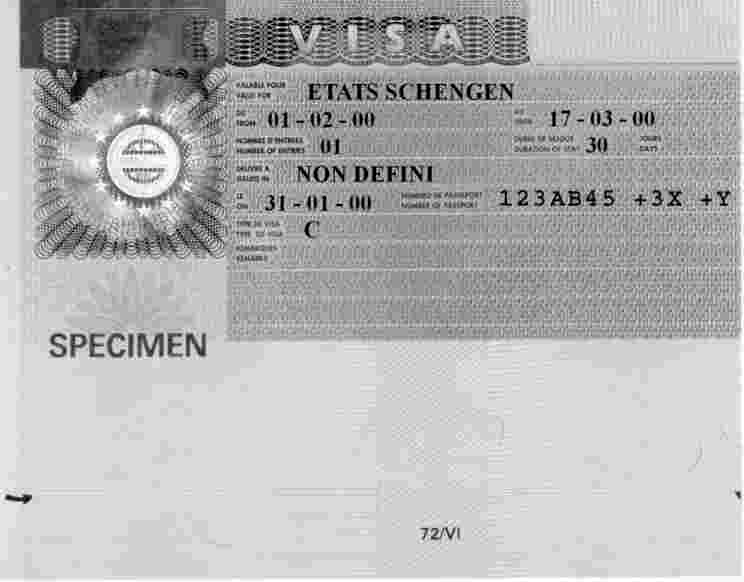
|
— |
In this case, one or more children and, in exceptional circumstances, a spouse travel on one passport. |
|
— |
If one or more children entered in the travel document are covered by a visa, under the heading ‘number of passport’ + nX is added after the passport number (n indicating the number of children), and if a spouse is travelling on the passport + Y is added. In the example shown here (single-entry, short-stay visa, duration of stay 30 days) the visa is issued for the passport holder, three children and the holder's spouse. |
VISA ISSUED BY A REPRESENTATION
Example 14

The above visa was issued by a consular post of a Schengen State representing another Schengen State.
In this case, under the heading ‘remarks’, the letter ‘R’ must be entered, followed by the country code of the country on whose behalf the visa was issued.
The country codes to be used are as follows (7):
|
Belgium |
: |
B |
|
Denmark |
: |
DK |
|
Germany |
: |
D |
|
Greece |
: |
GR |
|
Spain |
: |
E |
|
France |
: |
F |
|
Italy |
: |
I |
|
Luxembourg |
: |
L |
|
Netherlands |
: |
NL |
|
Austria |
: |
A |
|
Portugal |
: |
P |
|
Finland |
: |
FIN |
|
Sweden |
: |
S |
|
Iceland |
: |
IS |
|
Norway |
: |
N. |
In the above example, the Belgian Embassy in Brazzaville issued a visa on behalf of Spain.
NATIONAL LONG-STAY VISA VALID CONCURRENTLY AS A SHORT-STAY VISA (8)
Example 15
|
— |
In this case the heading ‘valid for’ is to be filled in with the code of the country which issued the long-stay visa + the words ‘Schengen States’. |
|
— |
This example shows a national long-stay visa issued by France and valid concurrently as a uniform short-stay visa. |
|
— |
A long-stay visa valid concurrently as a short-stay visa bears the identification code D + C. |
SUMMARY
|
|
‘VALID FOR’ |
‘TYPE’ |
‘NUMBER OF ENTRIES’ |
‘FROM … UNTIL’ |
‘MAXIMUM DURATION OF EACH STAY’ (in days) |
|
|
Airport transit visas (ATVs) |
FRANCE (for example) or SCHENGEN STATES |
A |
01 |
Date of departure |
Date of departure + seven days |
XXX |
|
02 |
Date of departure |
Date of return + seven days |
||||
|
MULT (9) |
Date of first departure |
Date of first departure + number of months authorised (maximum three months) |
||||
|
Transit visas |
SCHENGEN STATES or FRANCE (for example) |
B |
01 |
Date of departure |
Date of departure + duration of stay + seven days |
XXX or 1 to 5 |
|
02 |
Date of first departure |
Date of first departure + number of months authorised (maximum six months) |
||||
|
MULT (9) |
Date of first departure |
|||||
|
Short-stay visas |
SCHENGEN STATES or FRANCE (for example) |
C |
01 |
Date of departure |
Date of departure + duration of stay + 15 days |
one to 90 |
|
MULT (10) |
Date of first departure |
Date of first departure + number of months authorised (maximum five years) |
||||
|
Long-stay visas valid concurrently as short-stay visas |
FRANCE (for example) + SCHENGEN STATES |
D + C |
|
|
|
|
(1) Text inserted by Council Decision 2001/420/EC (OJ L 150, 6.6.2001, p. 47). Applicable sine 15 June 2001.
(2) In the case of transit visas, the length of transit shall not exceed five days.
(3) Text inserted by Council Decision (EC) 2002/586/EC (OJ L 187, 16.7.2002, p. 48). Applicable since 16 July 2002.
(4) Text inserted by Council Decision 2001/420/EC (OJ 150, 6.6.2001, p. 47). Applicable since 15 June 2001.
(5) Text inserted by Council Decision 2002/586/EC (OJ L 187, 16.7.2002, p. 48). Applicable since 16 July 2002.
(6) Text inserted by Council Decision 2001/329/EC (OJ L 116, 26.4.2001, p. 32). Applicable since 27 April 2001.
(7) Text concerning Denmark, Finland, Sweden, Iceland and Norway inserted by Council Decision 2001/329/EC (OJ L 116, 26.4.2001, p. 32). Applicable since 27 April 2001.
(8) Text inserted by Council Decision 2001/420/EC (OJ L 150, 6.6.2001, p. 47). Applicable since 15 June 2001.
(9) MULT indicates multiple journeys, i.e. more than two entries.
(10) MULT indicates multiple journeys, i.e. more than one entry.
ANNEX 6b
Entries which the Contracting Parties shall write, where necessary, in the ‘REMARKS’ section
CONFIDENTIAL
ANNEX 6c
Instructions on writing entries in the section to be electronically scanned
CONFIDENTIAL
ANNEX 7
Specimen visa stickers
(point 3.1.3)
INDEX
| BENELUX | page 192 |
| DENMARK | page 193 |
| GERMANY | page 193 |
| GREECE | page 194 |
| SPAIN | page 194 |
| FRANCE | page 195 |
| ITALY | page 195 |
| AUSTRIA | page 196 |
| PORTUGAL | page 196 |
| FINLAND | page 197 |
| SWEDEN | page 197 |
| ICELAND | page 198 |
| NORWAY | page 198 |
BENELUX COUNTRIES

Joh. Enschedé
SECURITY CARDS AND DOCUMENTS
Schengen
Visumsticker
Benelux-landen

DENMARK

FEDERAL REPUBLIC OF GERMANY

GREECE

SPAIN
FABRICA NACIONAL DE MONEDA Y TIMBRE
![]()
ETIQUETA ESPANOLA DEL
VISADO SCHENGEN

MODELO ELABORADO EN PROCESO DE PRODUCCION INDUSTRIAL
FRANCE
MINISTERE DES AFFAIRES ETRANGERES
VIGNETTE VISA SCHENGEN

ITALY

AUSTRIA

PORTUGAL
S. — R.
MINISTÉRIO DOS NEGOCIOS ESTRANGEIROS
DIRECÇAO-GERAL DOS ASSUNTOS CONSULARES
E DA
ADMINISTRAÇAO FINANCEIRA E PATRIMONIAL

FINLAND
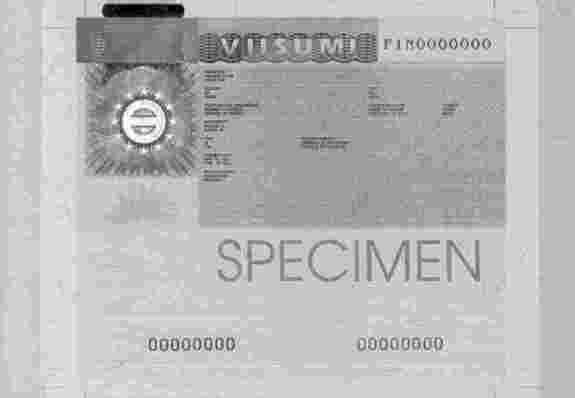
SWEDEN
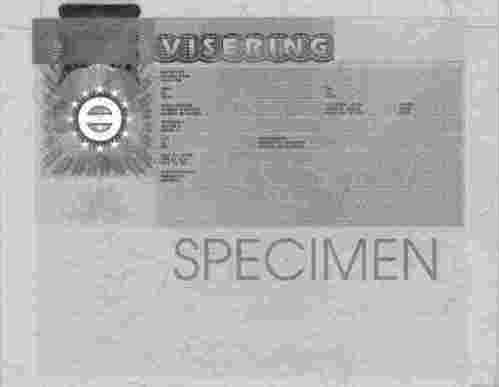
ICELAND

NORWAY

ANNEX 8
Specimen visas with limited territorial validity
(point 3.2.3)
This document corresponds to examples 10 to 12 in Annex 13 to the Common Consular Instructions on Visas.
VISAS WITH LIMITED TERRITORIAL VALIDITY (LTV VISAS)
An LTV visa can be either a short-stay visa or a transit visa.
The limitation of validity may apply to one or more States
Example 1
SHORT-STAY LTV VISA, ONE COUNTRY ONLY

|
— |
In this example, the territorial validity is limited to one country only, i.e. France |
|
— |
A short-stay LTV visa bears the identification code C (as in Example 7 in Annex 6a). |
Example 2 (1)
SHORT-STAY LTV VISA, VALIDITY LIMITED TO MORE THAN ONE COUNTRY
In this case, the ‘valid for’ heading shall be filled in:
|
— |
either by the codes indicating the countries for which the visa is valid (Belgium: B, Denmark: DK, Germany: D, Greece: GR, Spain: E, France: F, Italy: I, Luxembourg: L, Netherlands: NL, Austria: A, Portugal: P, Finland: FIN, Sweden: S, Iceland: IS, Norway: N. In the case of the Benelux countries: BNL). In the example shown, the territorial validity is limited to France and Spain.
|
|
— |
or by the words ‘Schengen States’ followed in brackets by a minus sign and the codes of the Member States for the territories of which the visa is not valid. In the example shown, the visa is valid for the territory of all the Member States applying the Schengen acquis except France and Spain.
|
Example 3
TRANSIT LTV VISAS, ONE COUNTRY
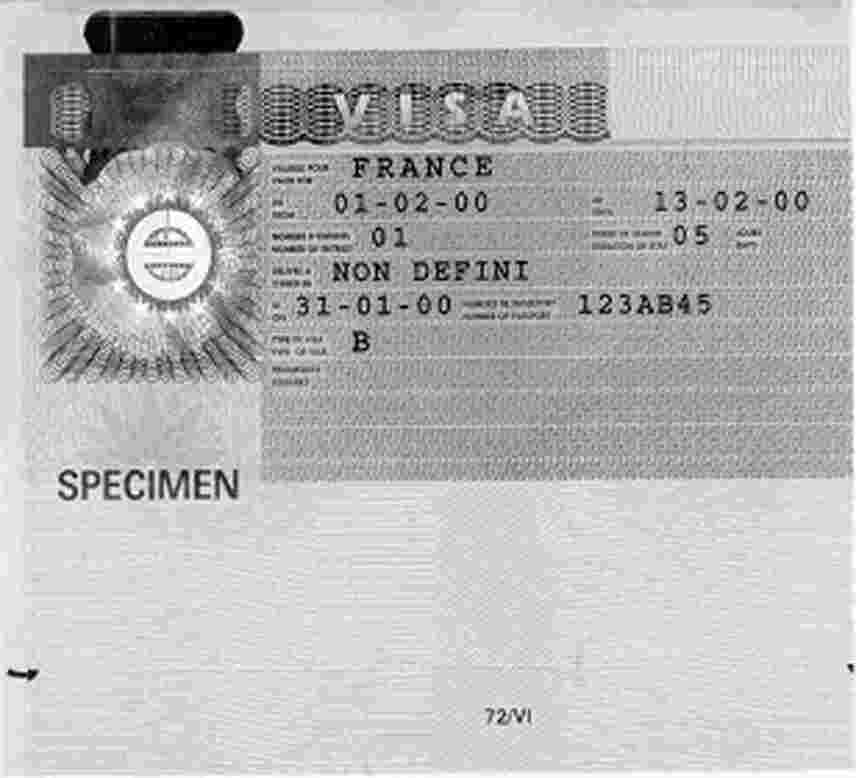
|
— |
A transit visa bears the identification code B under the heading for the type of visa |
|
— |
In the example shown, the visa is limited to France. |
(1) Text inserted by Council Decision 2001/329/EC (OJ L 116, 26.4.2001, p. 32). Applicable since 27 April 2001.
ANNEX 8a
Rules and procedures governing information to be sent by Contracting Parties when issuing visas with limited territorial validity, when cancelling, revoking and reducing the duration of validity of uniform visas and when issuing national residence permits
(point 3.2.4)
This document corresponds to Annex 14 to the Common Consular Instructions on Visas.
1. INFORMATION WHEN ISSUING VISAS WITH LIMITED TERRITORIAL VALIDITY
1.1. General conditions
In order that authorisation to enter the national territory of Schengen Contracting Parties can be granted, nationals from a third country should generally fulfil the conditions laid down in Article 5(1) of the Schengen Convention.
If a national from a third country does not fulfil all these conditions, entry or the issue of a visa shall be refused except if a Contracting Party considers it necessary to derogate from this rule on humanitarian grounds, on grounds of national interest, or due to international obligations. In such cases, the Contracting Party concerned may only issue a visa with limited territorial validity (LTV) and must inform the other Contracting Parties (Article 5(2) and Article 16 of the Schengen Convention).
The issue of short-stay LTVs in accordance with the Schengen Convention and the Common Consular Instructions on Visas (SCH/II-Visa (93) 11, 6 Rev., 4 corr., Chapter V, point 3) is generally subject to the following conditions:
|
(a) |
LTVs are issued by way of exception. The conditions under which this type of visa is issued shall be carefully examined on a case-by-case basis; |
|
(b) |
this does not mean that the Schengen Contracting Parties will use and abuse the possibility of issuing LTVs; this would not be in keeping with the principles and objectives of Schengen. Given that the number of LTVs being issued will most probably be small, it is not necessary to envisage an automated procedure for informing the other Contracting Parties. |
1.2. Rules of procedure
When defining rules of procedure governing the information to be sent to Contracting Parties when LTVs are issued, a distinction shall be made between visas issued by diplomatic and consular representations and visas issued by the border authorities. The rules of procedure in use are as follows:
1.2.1. Issue of visas by diplomatic and consular representations
In general, the rules laid down for the provisional arrangements for consultation with the central authorities (Article 17(2) of the Schengen Convention shall apply mutatis mutandis to the procedure for informing the other Contracting Parties (see doc. SCH/II-Visa (94) 7). Where different rules are used, these shall be notified by the Contracting Parties concerned. In general, information shall be sent within 72 hours.
1.2.2. Issue of visas by the border authorities
In this case, information shall generally be sent within 72 hours to the central authorities of the other Contracting Parties.
|
1.2.3. |
The Contracting Parties must designate contact points which will receive this information. |
|
1.2.4. |
In the context of an automated procedure for consultation of the central authorities (Article 17(2) of the Schengen Convention), a procedure must be included to ensure that other Contracting Parties are informed of the issue of an LTV where the LTV is issued as a result of an objection to the issue of a Schengen visa on the part of one (or more) Contracting Party/Parties), in the framework of consultation. Where LTVs are issued in other circumstances, this procedure cannot be used for sending information between States. |
|
1.2.5. |
The following information shall be sent to the Contracting Parties:
|
2. CANCELLING, REVOKING AND REDUCING THE DURATION OF VALIDITY OF A UNIFORM VISA
In accordance with the principles adopted by the Executive Committee for cancelling, revoking and reducing the duration of a uniform visa's validity (SCH/Com-ex (93) 24), the information must be sent to the other Contracting Parties.
2.1. Cancelling visas
Cancelling a Schengen visa aims to prevent persons entering the territory of the Contracting Parties when it transpires after a visa has been issued that these persons do not fulfil the conditions warranting the issue of a visa.
Contracting Parties who cancel a visa issued by another Contracting Party shall generally inform the central authorities of the issuing State within 72 hours.
This notification shall contain the following information:
|
|
Surname, first name, and date of birth of visa holder |
|
|
Nationality of visa holder |
|
|
Type and number of travel document |
|
|
Number of the visa sticker |
|
|
Category of visa |
|
|
Date and place of visa issue |
|
|
Date and reasons for cancellation. |
2.2. Revoking visas
Revoking a visa permits cancellation, even after entry to the territory, of the remaining duration of a visa's validity.
A Contracting Party which revokes a uniform visa shall generally inform the issuing Contracting Party within 72 hours. This notification shall contain the same information as mentioned under point 2.1.
2.3. Reducing the duration of a visa's validity
When a Schengen State reduces the duration of validity of a visa issued by another Contracting Party, it shall generally inform that Contracting Party's central authorities within 72 hours. This notification shall contain the same information as mentioned under point 2.1.
2.4. Procedure
The information sent to the Contracting Party which issued the visa when a visa is cancelled or revoked, or the duration of its validity is reduced, shall generally be sent to the central authority designated by that Contracting Party.
3. INFORMATION ON NATIONAL RESIDENCE PERMITS (ARTICLE 25)
Article 25(1) lays down that where a Contracting Party considers issuing a residence permit to an alien for whom an alert has been issued for the purposes of refusing entry, it shall first consult the Contracting Party issuing the alert and shall take account of its interests: the residence permit shall be issued only for serious reasons, in particular of a humanitarian nature or arising from international obligations.
The second subparagraph in Article 25(1) provides that the Contracting Party issuing the alert shall withdraw the alert, but may still put the alien concerned on its national list of alerts.
The application of the provisions mentioned above involves two instances of information transmission between the Contracting Party intending to issue the residence permit and the Contracting Party issuing the alert:
|
— |
prior consultation with the Contracting Party issuing the alert in order to take account of its interests, and |
|
— |
information about the issue of the residence permit, so that the Contracting Party issuing the alert can withdraw it. |
In accordance with the provisions of Article 25(2) of the Schengen Convention, consultation by the Contracting Party issuing the alert is also necessary if it only transpires a posteriori, i.e. after the residence permit has been issued, that an alert has been issued for the purposes of refusing entry to the holder of the residence permit.
In view of the underlying principles of the Schengen Convention, the issue of a residence permit to nationals from a third country for whom an alert has been issued for the purposes of refusing entry by one of the Contracting Parties shall also be limited to exceptional circumstances.
With regard to the consultation referred to in Article 25 of the Convention, this action is highly dependent on the functioning of the Schengen Information System (SIS). Consideration should be given to sending this information via the future Sirene procedure if possible.
The rules of procedure outlined in this note shall be re-examined from the point of view of their practical applicability at the latest twelve months after the Schengen Convention has been brought into force.
ANNEX 9
Specimen long-stay visa
(point 3.3.2)
LONG-STAY VISA
|
— |
Long-stay visas give entitlement to stays of over 90 days in any six-month period. These are national visas, but entitle the holder to transit through the territory of other Schengen States to enter, for the first time, the territory of the State which issued the visa. |
|
— |
Long-stay visas are identifiable by Code D, which appears in the heading ‘type of visa’. |
|
— |
The heading ‘valid for’ indicates the country which issued the visa. This indication is followed by ‘(+ 1 transit Schengen)’ to draw attention to the fact that the visa gives entitlement to transit through the rest of the Schengen area to reach the issuing State. |
|
— |
The duration of stay indicated may not exceed 90 days. |

ANNEX 10
Reference amounts required for crossing borders fixed annually by the national authorities
(point 4.1.2)
INDEX
| BELGIUM | page 208 |
| DENMARK | page 208 |
| GERMANY | page 208 |
| GREECE | page 209 |
| SPAIN | page 209 |
| FRANCE | page 209 |
| ITALY | page 210 |
| LUXEMBOURG | page 210 |
| NETHERLANDS | page 211 |
| AUSTRIA | page 211 |
| PORTUGAL | page 211 |
| FINLAND | page 211 |
| SWEDEN | page 211 |
| ICELAND | page 211 |
| NORWAY | page 211 |
This document corresponds to Annex 7 to the Common Consular Instructions on Visas.
BELGIUM
Belgian law lays down general provisions for the verification of adequate means of subsistence, without stipulating any mandatory rules.
The administrative practice is as follows:
|
— |
Aliens staying with a private person Proof of means of subsistence may be furnished by means of a letter of guarantee signed by the person accommodating the alien in Belgium and authenticated by the local administrative authority of his place of residence. The declaration of liability covers the costs of the alien's stay, health care, accommodation and repatriation, should the alien be unable to pay, so as to rule out payment by the public authorities. The declaration must be signed by a person who is solvent and, if this person is an alien, is in possession of a residence permit or settlement permit. If necessary, the alien may also be required to furnish proof of personal resources. If he has no financial credit whatsoever, he must be able to access at least EUR 38 for each day of the planned stay. |
|
— |
Aliens staying at a hotel If the alien is unable to furnish proof of any credit whatsoever, he must be able to access at least approximately EUR 50 for each day of the planned stay. Furthermore, in most cases, the person concerned must produce a ticket (air ticket) enabling him to return to his country of origin or residence. |
DENMARK
Under the Danish Aliens Law, an alien entering Danish territory must have adequate means for subsistence and for the return journey.
In practice it is for the border control authorities at the point of entry to assess whether this is the case on the basis of the economic situation of the alien, taking account of information on his possibilities with regard to accommodation and the return journey.
The administration has set a figure for adequate means of subsistence of, in principle, Danish Kroner 300 per 24 hours.
In addition, the alien must be able to prove that he has adequate means for the return journey, for example in the form of a return ticket.
GERMANY
Pursuant to Article 60(2) of the Aliens Act of 9 July 1990 (AuslG), an alien may be refused entry at the border if there are grounds for expulsion.
This is the case if an alien is forced to claim or claims social welfare benefit from the German State for himself, for members of his family staying in German territory or for his dependants (Article 46(6) of the Aliens Act).
Reference amounts have not been fixed for the use of border control officials. In practice, an amount of EUR 25 per day is generally used as a basic reference. The alien must also have a return ticket or equivalent financial means.
Nevertheless, before the decision not to admit the alien is made, he must be granted the opportunity to produce, in good time and by legal means, the financial means necessary to secure his stay in German territory, namely by presenting:
|
— |
a legal guarantee from a German bank, |
|
— |
a letter of guarantee from the host, |
|
— |
a telegraphic money order, or |
|
— |
a guarantee deposited with the immigration authorities dealing with his visit. |
GREECE
Ministerial decree No 3011/2/1f of 11 January 1992 fixes the amount of the means of subsistence which foreign nationals, with the exception of nationals of the Member States of the European Community, must have at their disposal if they wish to enter Greek territory.
Pursuant to the abovementioned ministerial decree, the amount of foreign currency enabling foreign nationals of States other than Member States of the European Community to enter Greece is fixed at the equivalent of EUR 20 in foreign currency per person per day, and a minimum total amount of EUR 100.
The amount of foreign currency required per day is reduced by 50 % for minors who are members of the alien's family.
Nationals of non-Community countries which oblige Greek nationals to change currency at their borders are subject to the same obligation in accordance with the principle of reciprocity.
SPAIN
Aliens must prove that they have adequate means of subsistence. The minimum amount is given below:
|
(a) |
for the costs of their stay in Spain: EUR 30, or the equivalent in foreign currency, multiplied by the planned number of days of the stay in Spain and by the number of family members travelling with the person concerned. Regardless of the planned duration of the stay, the minimum amount for which he must provide proof must always be EUR 300 per person; |
|
(b) |
for their return to the State of provenance or for transit via third States: the personal, non-transferable and fixed-date ticket or tickets for the planned means of transport. |
Aliens must prove that they have the above means of subsistence either by producing them if they are in cash, or by producing certified cheques, traveller's cheques, receipts, letters of credit or a bank certificate confirming the existence of these means. Failing these documents, any other supporting documents recognised by the Spanish border police authorities may be produced.
FRANCE
The reference amount for the adequate means of subsistence for the planned duration of an alien's stay or for his transit via France to a destination in a third State is equal to the amount of the guaranteed minimum wage in France (SMIC) calculated daily on the basis of the rate fixed on 1 January of the current year.
This amount is regularly reassessed on the basis of the French cost of living index:
|
— |
automatically whenever the retail price index rises more than 2 %, |
|
— |
by a governmental decision, after consultation with the national commission for collective bargaining, to grant a rise higher than the rise in the retail price index. |
As of 1 July 2002, the daily amount of the SMIC (minimum wage) is EUR 47,80.
Holders of an accommodation certificate must possess a minimum amount of money, equivalent to half the SMIC, in order to stay in France. This amount is therefore EUR 23,90 per day.
ITALY
Article 4(3) of the ‘Consolidated text of provisions governing immigration and the status of aliens’ No 286 of 28 July 1998 states that Italy, in accordance with the obligations assumed through membership of specific international agreements, shall allow entry into its territory to aliens who prove themselves to be in possession of suitable documentation to confirm the purpose and conditions of their residence and sufficient means of support for the duration of their residence as well as, except in the case of residence permits for work purposes, for their return to the country they came from. Means of support are defined in the relevant directive issued by the Minister for the Interior. Aliens not satisfying these requirements or who are considered a threat to the national security or public policy of the State or of one of the countries with which Italy has signed agreements for the abolition of internal border controls and the free movement of persons may not enter Italy, subject to the limits and derogations laid down in those agreements.
The directive in question, which was issued on 1 March 2000 and has the title ‘Definition of means of support for entry and residence of aliens in the national territory’, lays down that:
|
— |
the availability of means of support may be demonstrated by producing currency or equivalent bills of exchange or bank guarantees or insurance policies guaranteeing payment, by means of documents attesting to prepaid services or documents proving the availability of funds from income in the national territory, |
|
— |
the monetary amounts established in the directive are to be revised annually, after application of the parameters relating to average annual variation produced by ISTAT and calculated on the basis of the general consumer price index for foodstuffs, drinks, transport and accommodation services, |
|
— |
the alien must indicate the availability of suitable accommodation in Italian territory and possession of the sum needed for repatriation, which may also be demonstrated by showing a return ticket, |
|
— |
the minimum means of support needed per person for the issue of a visa and for entry to Italian territory for the purposes of tourism are defined in accordance with the following table. |
Table A
Table for determining the means of support required for entry to Italian territory for the purposes of tourism
|
(in EUR) |
||
|
Duration of trip |
Number of participants in trip |
|
|
One participant |
Two or more participants |
|
|
1 to 5 days overall fixed sum |
269,60 |
212,81 |
|
6 to 10 days daily sum per person |
44,93 |
26,33 |
|
11 to 20 days fixed sum |
51,64 |
25,82 |
|
+ daily sum per person |
36,67 |
22,21 |
|
more than 20 days fixed sum |
206,58 |
118,79 |
|
+ daily sum per person |
27,89 |
17,04 |
LUXEMBOURG
The law of Luxembourg does not provide for any reference amount for border controls. The official carrying out the control decides on a case-by-case basis whether an alien who presents himself at the border has adequate means of subsistence. To this end, the official takes into account the purpose of the stay and the type of accommodation.
NETHERLANDS
The amount which border control officials take as a basis when verifying means of subsistence is currently EUR 34 per person per day.
The application of this criterion is flexible since the required amount of the means of subsistence is determined on the basis of the planned duration of the stay, the reason for the visit and the personal circumstances of the person concerned.
AUSTRIA
Pursuant to subparagraph 4 of Article 52(2) of the Law on Aliens, aliens shall be turned away at the border if they have no place of residence in Austria and do not have sufficient means of subsistence to meet the costs of their stay and return.
However, there are no reference amounts for the above. Decisions are made on a case-by-case basis depending on the purpose, type and duration of the stay. Cash and, depending on the circumstances of the individual case, traveller's cheques, credit cards, bank guarantees or letters of guarantee from solvent persons living in Austria may be accepted as proof.
PORTUGAL
Aliens must be in possession of the following amounts if they wish to enter or stay in Portugal:
|
— |
75 EUR for each entry, |
|
— |
40 EUR for each day spent in the territory. |
Aliens who are able to prove that their board and lodging are guaranteed for the duration of their stay may be exempted from paying the above amounts.
FINLAND
The amount which border control officials take as a basis for means of subsistence is at present EUR 40 per person per day.
SWEDEN
Swedish law does not stipulate a reference amount for the crossing of borders. The border control officer decides on a case-by-case basis whether the alien has adequate means of subsistence.
ICELAND
Under Icelandic law, aliens must prove that they are in possession of enough money to meet their needs in Iceland and to make the return journey. In practice, the reference amount is Icelandic krónur 4 000 per person. If subsistence expenses are borne by a third party, the amount is halved. The total minimum amount is Icelandic krónur 20 000 for each entry.
NORWAY
Under Article 27(d) of the Norwegian Immigration Law, any foreign national who is unable to prove that he has adequate funds for his stay in the Kingdom and for the return journey, or that he can count on such funds, may be turned back at the border.
The amounts deemed necessary are fixed individually and decisions are taken on a case-by-case basis. Account is taken of the length of stay, whether the foreign national will be staying with family or friends, whether he has a ticket for the return journey and whether a guarantee has been given for the stay (as an indication, an amount of Norwegian Kroner 500 per day is deemed to be adequate for visitors who are not staying with relations or friends).
ANNEX 11
List of documents giving entitlement to entry without a visa
INDEX
| BELGIUM | page 213 |
| DENMARK | page 214 |
| GERMANY | page 215 |
| GREECE | page 217 |
| SPAIN | page 218 |
| FRANCE | page 220 |
| ITALY | page 222 |
| LUXEMBOURG | page 223 |
| NETHERLANDS | page 224 |
| AUSTRIA | page 225 |
| PORTUGAL | page 226 |
| FINLAND | page 227 |
| SWEDEN | page 227 |
| ICELAND | page 227 |
| NORWAY | page 228 |
This document corresponds to Annex 4 to the Common Consular Instructions on Visas.
BELGIUM
|
— |
Carte d'identité d'étranger Identiteitskaart voor vreemdelingen Personalausweis für Ausländer (Identity card for foreigners) |
|
— |
Certificat d'inscription au régistre des étrangers Bewijs van inschrijving in het vreemdelingenregister Bescheinigung der Eintragung im Ausländerregister (Certificate attesting to entry in foreigners' register) |
|
— |
Special residence permits issued by the Ministry of Foreign Affairs:
|
|
— |
Certificat d'identité avec photographie délivré par une administration communale belge à un enfant de moins de douze ans Door een Belgisch gemeentebestuur aan een kind beneden de twaalf jaar afgegeven identiteitsbewijs met foto Von einer belgischen Gemeindeverwaltung einem Kind unter dem 12. Lebensjahr ausgestellter Personalausweis mit Lichtbild (Certificate of identity with photograph issued by Belgian communes to children under twelve) |
|
— |
List of persons participating in a school trip within the European Union. |
DENMARK
Residence cards
EF/EØS — opholdskort (EU/EEA residence card) (title on card)
|
— |
Kort A. Tidsbegrænset EF/EØS-opholdsbevis (anvendes til EF/EØS-statsborgere) (Card A. Temporary EU/EEA residence permit used for EU/EEA citizens) |
|
— |
Kort B. Tidsubegrænset EF/EØS-opholdsbevis (anvendes til EF/EØS-statsborgere) (Card B. EU/EEA residence permit of unlimited duration used for EU/EEA citizens) |
|
— |
Kort Karte K. Tidsbegrænset opholdstilladelse til tredjelandsstatsborgere, der meddeles opholdstilladelse efter EF/EØS-reglerne) (Card K. Temporary residence permit for citizens of third countries who have been granted a residence permit under EU/EEA rules) |
|
— |
Kort L. Tidsubegrænset opholdstilladelse til tredjelandsstatsborgere, der meddeles opholdstilladelse efter EF/EØS-reglerne) (Card L. Residence permit of unlimited duration for citizens of third countries who have been granted a residence permit under EU/EEA rules). |
Residence permits (title on card)
|
— |
Kort C. Tidsbegrænset opholdstilladelse til udlændinge, der er fritaget for arbejdstilladelse (Card C. Temporary residence permit for aliens who are not required to have a work permit) |
|
— |
Kort D. Tidsubegrænset opholdstilladelse til udlændinge, der er fritaget for arbejdstilladelse (Card D. Residence permit of unlimited duration for aliens who are not required to have a work permit) |
|
— |
Kort E. Tidsbegrænset opholdstilladelse til udlændinge, der ikke har ret til arbejde (Card E. Temporary residence permit for aliens who do not have the right to work) |
|
— |
Kort F. Tidsbegrænset opholdstilladelse til flygtninge — er fritaget for arbejdstilladelse (Card F. Temporary residence permit for refugees — not required to have a work permit) |
|
— |
Kort G. Tidsbegrænset opholdstilladelse til EF/EØS — statsborgere, som har andet opholdsgrundlag end efter EF-reglerne — er fritaget for arbejdstilladelse (Card G. Temporary residence permit for EU/EEA citizens who have a basis for residence other than that deriving from the EU rules — not required to have a work permit) |
|
— |
Kort H. Tidsubegrænset opholdstilladelse til EF/EØS — statsborgere, som har andet opholdsgrundlag end efter EF-reglerne — er fritaget for arbejdstilladelse (Card H. Residence permit of unlimited duration for EU/EEA citizens who have a basis for residence other than that deriving from the EU rules — not required to have a work permit) |
|
— |
Kort J. Tidsbegrænset opholds- og arbejdstilladelse til udlændinge (Card J. Temporary residence and work permit for aliens). |
Since 14 September 1998 Denmark has issued new residence permits in credit-card format.
There are still some valid residence permits of types B, D and H in circulation which were issued in another format. These cards are made of laminated paper, measure approximately 9 cm × 13 cm and bear a pattern of the Danish coat of arms in white. For Card B, the background colour is beige, for Card D it is light pink and for Card H light mauve.
Stickers to be affixed to passports, bearing the following wording:
|
— |
Sticker B. — Tidsbegrænset opholdstilladelse til udlændinge, der ikke har ret til arbejde (Sticker B. Temporary residence permit for aliens who do not have the right to work) |
|
— |
Sticker C. — Tidsbegrænset opholds- og arbejdstilladelse (Sticker C. Temporary residence and work permit) |
|
— |
Sticker D. — Medfølgende slægtninge (opholdstilladelse til børn, der er optaget i forældres pas) (Sticker D. Accompanying relatives (residence permit for children who are included in their parents' passport)) |
|
— |
Sticker H. — Tidsbegrænset opholdstilladelse til udlændinge, der er fritaget for arbejdstilladelse (Sticker H. Temporary residence permit for aliens who are not required to have a work permit). |
Stickers issued by the Ministry of Foreign Affairs:
|
— |
Sticker E — Diplomatisk visering (Sticker E — diplomatic visa) Issued to diplomats and the members of their family who appear on the diplomatic lists, and to staff of equivalent rank in international organisations in Denmark. Valid for residence and for multiple entry for as long as the person concerned is on the diplomatic lists in Copenhagen. |
|
— |
Sticker F — Opholdstilladelse (Sticker F — residence permit) Issued to seconded technical or administrative staff and members of their family and to domestic servants of diplomats on secondment from the Ministry of Foreign Affairs of the State of origin with a service passport. Also issued to staff of equivalent rank in international organisations in Denmark. Valid for residence and multiple entry for the duration of the mission. |
|
— |
Sticker S (i kombination med sticker E eller F) (Sticker S (in combination with Sticker E or F)) Residence permit for accompanying close relatives, where they are included in the passport. |
It should be noted that identity cards for foreign diplomats, technical or administrative staff, domestic servants etc. issued by the Ministry of Foreign Affairs do not give the holder the right to enter the territory without a visa, since such identity cards are not proof of permission to reside in Denmark.
Other documents:
|
— |
List of persons participating in a school trip within the European Union |
|
— |
Readmission permit in the form of a visa sticker with national code DK. |
GERMANY
|
— |
Aufenthaltserlaubnis für die Bundesrepublik Deutschland (Residence permit for the Federal Republic of Germany) |
|
— |
Aufenthaltserlaubnis für Angehörige eines Mitgliedstaates der EWG (Residence permit for EC nationals) |
|
— |
Aufenthaltsberechtigung für die Bundesrepublik Deutschland (Residence permit for the Federal Republic of Germany) |
|
— |
Aufenthaltsbewilligung für die Bundesrepublik Deutschland (Residence authorisation for the Federal Republic of Germany) |
|
— |
Aufenthaltsbefugnis für die Bundesrepublik Deutschland (Residence permit for the Federal Republic of Germany). These residence permits only entitle entry without a visa when they are inserted in a passport or issued in connection with a passport as an authorisation replacing a visa. They do not give entitlement to entry without a visa if they are issued instead of a national identity document. The document for a deferred expulsion measure ‘Aussetzung der Abschiebung (Duldung)’ and the temporary residence authorisation for asylum seekers ‘Aufenthaltsgestattung für Asylbewerber’ do not give entitlement to entry without a visa either. |
|
— |
Special residence permits issued by the Ministry of Foreign Affairs
|
|
— |
Special residence permits issued by the Länder
|
|
— |
New residence permits in card format (ID card format) issued by the Ministry of Foreign Affairs:
The respective privileges are indicated on the back of the pass. |
|
— |
List of persons participating in a school trip within the European Union. |
GREECE
|
— |
Άδεια παραμονής αλλοδαπού για εργασία (Work permit) |
|
— |
Άδεια παραμονής μελών οικογενείας αλλοδαπού (Residence permit issued for family reunion) |
|
— |
Άδεια παραμονής αλλοδαπού για σπουδές (Residence permit for study purposes) |
|
— |
Άδεια παραμονής αλλοδαπού (Alien's residence permit) (white) (This document is issued to aliens who are married to Greek nationals; it is valid for one year and can be extended for as long as the marriage lasts) |
|
— |
Άδεια παραμονής αλλοδαπού (Alien's residence permit) (beige-yellow) (This document is issued to all aliens who are legally resident in Greece. It is valid for between one and five years) |
|
— |
Άδεια παραμονής αλλοδαπού (Alien's residence permit) (white) (This document is issued to persons recognised as refugees under the 1951 Geneva Convention) |
|
— |
Δελτίο ταυτότητας αλλοδαπού (Alien's identity card) (green) (This document is issued only to aliens of Greek descent; it may be valid for either two or five years) |
|
— |
Ειδικό δελτίο ταυτότητας ομογενούς (Special identity card for aliens of Greek descent) (beige) (This document is issued to Albanian nationals of Greek descent; it is valid for three years. The card is also issued to their spouses and descendants of Greek origin, regardless of nationality, provided there is official documentation of some kind to prove their family ties) |
|
— |
Ειδικό δελτίο ταυτότητας ομογενούς (Special identity card for aliens of Greek descent) (pink) (This document is issued to aliens of Greek descent from the former USSR. It is valid indefinitely) |
|
— |
Δελτίο ταυτότητας διπλωματικού υπαλλήλου (Identity card for diplomatic officials) (white) Δελτίο ταυτότητας προξενικού υπαλλήλου (Identity card for consular officials) (white) Δελτίο ταυτότητας υπαλλήλου διεθνούς οργανισμού (Identity card for officials of international organisations) (white) Δελτίο ταυτότητας διοικητικού υπαλλήλου διπλωματικής αρχής (Identity card for administrative officials of diplomatic authorities) (blue) |
|
— |
List of persons participating in a school trip within the European Union. |
Note: The first four categories of document will remain valid until their expiry date. They ceased to be issued on 2 June 2001.
SPAIN
Holders of a valid re-entry authorisation will be allowed entry without a visa.
Residence permits entitling aliens, who for reasons of nationality would normally be subject to a visa requirement, to enter Spanish territory without a visa are as follows:
|
— |
Permiso de residencia inicial (Initial Residence Permit) |
|
— |
Permiso de residencia ordinario (Ordinary Residence Permit) |
|
— |
Permiso de residencia especial (Special Residence Permit) |
|
— |
Tarjeta de estudiante (Student Card) |
|
— |
Permiso de residencia tipo A (Residence Permit type A) |
|
— |
Permiso de residencia tipo B (Residence Permit type B) |
|
— |
Permiso de trabajo y de residencia tipo B (Work and Residence Permit type B) |
|
— |
Permiso de trabajo y de residencia tipo C (Work and Residence Permit type C) |
|
— |
Permiso de trabajo y de residencia tipo D (Work and Residence Permit type D) |
|
— |
Permiso de Trabajo y de Residencia tipo D (Work and residence permit type D) |
|
— |
Permiso de Trabajo y de Residencia tipo E (Work and residence permit type E) |
|
— |
Permiso de Trabajo Fronterizo tipo F (Border work permit type F) |
|
— |
Permiso de Trabajo y Residencia tipo P (Work and residence permit type P) |
|
— |
Permiso de Trabajo y Residencia tipo Ex (Work and residence permit type Ex) |
|
— |
Tarjeta de reconocimiento de la excepción a la necesidad de obtener Permiso de Trabajo y permiso de residencia (articulo de la 16 Ley 7/85) (Pass recognising exemption from the need to obtain a work permit and a residence permit — Article 16 Law 7/85) |
|
— |
Permiso de residencia para refugiados (Residence permit for refugees) |
|
— |
Lista de personas que participan en un viaje escolar dentro de la Unión Europea (List of persons participating in a school trip within the European Union) |
|
— |
Tarjeta de familiar residente comunitario (Pass for relatives of a Community resident) |
|
— |
Tarjeta temporal de familiar de residente comunitario (Temporary pass for relatives of a Community resident) |
The holders of the following valid accreditation cards issued by the Ministry of Foreign Affairs may enter without a visa:
|
— |
Tarjeta especial (Special pass — red) entitled ‘Cuerpo diplomático. Embajador. Documento de identidad’ (Diplomatic corps. Ambassador. Identity document), issued to accredited ambassadors |
|
— |
Tarjeta especial (Special pass — red) entitled ‘Cuerpo diplomático. Documento de identidad’ (Diplomatic corps. Identity document), issued to staff accredited to diplomatic missions who have diplomatic status. An F is added to the document when issued to spouses or children |
|
— |
Tarjeta especial (Special pass — yellow) entitled ‘Misiones diplomáticas. Personal administrativo y técnico. Documento de identidad’ (Diplomatic missions. Administrative and technical staff. Identity document), issued to administrative officials at accredited diplomatic missions. An F is added to the document when issued to spouses or children |
|
— |
Tarjeta especial (Special pass — yellow) entitled ‘Tarjeta diplomática de identidad’ (Diplomatic identity card), issued to staff with diplomatic status at the Office of the League of Arab Nations and to staff accredited to the Office of the Palestinian General Mission (Oficina de la Delegación General). An F is added to the document when issued to spouses or children |
|
— |
Tarjeta especial (Special pass — red) entitled ‘Organismos internacionales. Estatuto diplomático. Documento de identidad’ (International organisations. Diplomatic status. Identity document), issued to Bureau de la Ligue des Etats Arabes. An F is added to the document when issued to spouses or children |
|
— |
Tarjeta especial (Special pass — blue) entitled ‘Organismos internacionales. Personal administrativo y técnico. Documento de identidad’ (International organisations. Administrative and technical staff. Identity document), issued to administrative officials accredited to international organisations. An F is added to the document when issued to spouses or children |
|
— |
Tarjeta especial (Special pass — green) entitled ‘Funcionario consular de carrera. Documento de identidad’ (Career consular official. Identity document), issued to career consular officials accredited in Spain. An F is added to the document when issued to spouses or children |
|
— |
Tarjeta especial (Special pass — green) entitled ‘Empleado consular. Expedida a favour de ... Documento de identidad’ (Consular employee. Issued to ... Identity document), issued to consular administrative officials accredited in Spain. An F is added to the document when issued to spouses or children |
|
— |
Tarjeta especial (Special pass — grey) entitled ‘Personal de servicio. Missiones diplomáticas, oficinas consulares y organismos internacionales. Expedida a favour de ... Documento de identidad’ (Service duty staff. Diplomatic missions, Consular posts and International organisations. Issued to ... Identity document). This is issued to staff working in the domestic service of diplomatic missions, consular posts and international organisations (service duty staff) and staff with career diplomatic or consular status (private domestic staff). An F is added to the document when issued to spouses or children. |
FRANCE
|
1. |
Adult aliens should be in possession of the following documents:
|
|
2. |
Aliens who are minors should be in possession of the following documents:
|
|
3. |
List of persons participating in a school trip within the European Union. |
Note 1:
It should be noted that acknowledgements of first-time applications for residence permits do not give entitlement to entry without a visa. In contrast, acknowledgements of requests to renew residence permits, or to amend permits are considered valid, when these are accompanied by the old permit.
Note 2:
The ‘certificate of duty’ issued at the discretion of the Ministry of Foreign Affairs does not constitute a replacement for a residence permit. Holders must also be in possession of one of the ordinary law residence permits.
ITALY
|
— |
Carta di soggiorno (validità illimitata) (Residence permit) (unlimited validity) |
|
— |
Permesso di soggiorno con esclusione delle sottoelencate tipologie: (Residence permit with the exception of the following:)
|
|
— |
Carta d'identità MAE — Corpo diplomatico (Identity card issued by the Ministry of Foreign Affairs)
Note: Models 6 (orange) and 9 (green) for, respectively, staff of international organisations who have no immunity and foreign honorary consuls, are no longer issued and have been replaced by model 11. However, these documents remain valid until the expiry date stated on them. |
|
— |
List of persons participating in a school trip within the European Union. |
LUXEMBOURG
|
— |
Carte d'identité d'étranger (Alien's identity card) |
|
— |
Autorisation de séjour provisoire apposée dans le passeport national (Provisional residence authorisation affixed in national passports) |
|
— |
Carte diplomatique délivrée par le ministère des affaires etrangères (Diplomat's pass issued by the Ministry of Foreign Affairs) |
|
— |
Titre de légitimation délivré par le ministère des affaires etrangères au personnel administratif et technique des Ambassades (Identity document issued by the Ministry of Foreign Affairs to embassy administrative and technical staff) |
|
— |
Titre de légitimation délivré par le Ministère de la Justice au personnel des institutions et organisations internationales établies au Luxembourg (Identity document issued by the Ministry of Justice to the staff of international institutions and organisations based in Luxembourg) |
|
— |
List of persons participating in a school trip within the European Union. |
NETHERLANDS
|
— |
Documents take the following forms:
|
|
— |
Vergunning tot verblijf (in de vorm van een stempel in het paspoort) (Residence authorisation (in the form of a stamp in a passport)) |
|
— |
Vreemdelingendocument with the code ‘A’, ‘B’, ‘C’, ‘D’, ‘E’, ‘F1’, ‘F2’ or ‘F3’ (Document for aliens) |
|
— |
Legitimatiebewijs voor leden van diplomatieke of consulaire posten (Identity document for members of diplomatic missions and consular posts) |
|
— |
Legitimatiebewijs voor ambtenaren met een bijzondere status (Identity document for officials with a special status) |
|
— |
Legitimatiebewijs voor ambtenaren van internationale organisaties (Identity document for officials of international organisations) |
|
— |
Identiteitskaart voor leden van internationale organisaties waarvan de zetel in Nederland is gevestigd (Identity card for members of international organisations with which the Netherlands has concluded a headquarters agreement) |
|
— |
Visum voor terugkeer (Return visa) |
|
— |
List of persons participating in a school trip within the European Union. |
Comment on indents 1 and 2
The issue of residence documents mentioned under indents 1 and 2 has ceased since 1 March 1994 (the issue of Model ‘D’ and the affixing of stamps in passports came to an end on 1 June 1994). Documents already in circulation will remain valid until 1 January 1997 at the latest.
Comment on indent 3
Issue of the document for aliens has been effective since 1 March 1994. This document in the form of a credit card will gradually replace the residence authorisations mentioned in indents 1 and 2. The code corresponding to the category of residence will be retained.
The document for aliens marked with code E will be issued both to EC nationals and to nationals of Contracting States to the European Economic Area Agreement.
Conditional residence authorisations are marked with codes F1, F2 or F3.
Comment on indent 7
List of international organisations with an office in the Netherlands whose members (including family members) hold identity papers not issued by the Ministry of Foreign Affairs
|
1. |
European Space Agency (ESA) |
|
2. |
European Patent Office (EPO) |
|
3. |
International Tea Promotion Association (ITPA) |
|
4. |
International Service for National Agricultural Research (ISNAR) |
|
5. |
Technical Centre for Agricultural and Rural Cooperation (CTA) |
|
6. |
United Nations University Institute for New Technologies (UNU-INTECH) |
|
7. |
African Management Services Company (AMSCO) |
AUSTRIA
|
— |
Aufenthaltstitel in Form der Vignette entsprechend der Gemeinsamen Maßnahme der Europäischen Union vom 16. Dezember 1996 zur einheitlichen Gestaltung der Aufenthaltstitel (Residence permit in the form of a sticker in accordance with the EU Joint Action of 16 December 1996 concerning a uniform format for residence permits) (As from 1 January 1998 residence permits have been issued and extended in this form only. The following entries are made under ‘Type of Permit’: Niederlassungsbewilligung (Permanent residence permit); Aufenthaltserlaubnis (Residence permit) and Befr. Aufenthaltsrecht (Temporary residence permit). |
|
— |
Residence permits issued before 1 January 1998 on the basis of the validity indicated, including unlimited validity: (Wiedereinreise — Sichtvermerk (Re-entry visa) or Einreise — Sichtvermerk (Entry visa) issued by the Austrian authorities until 31 December 1997, and by the Representations abroad in the form of a stamp Gewöhnlicher Sichtvermerk (Ordinary visa) issued between 1 January 1993 and 31 December 1997 in the form of a sticker, as from 1 September 1996 in accordance with Regulation (EC) No 1683/95 Aufenthaltsbewilligung (Residence permit) issued between 1 January 1993 and 31 December 1997, in the form of a special sticker |
|
— |
Konventionsreisepass (Convention travel document) issued as of 1 January 1993 |
|
— |
Legitimationskarte für Träger von Privilegien und Immunitäten in den Farben rot, gelb und blau, ausgestellt vom Bundesministerium für auswärtige Angelegenheiten (Accreditation pass for holders of privileges and immunities in red, yellow and blue issued by the Ministry for Foreign Affairs) |
|
— |
List of pupils participating in school trips within the European Union. |
The following are not valid as residence permits and therefore do not entitle the holder to visa-free entry into Austria:
|
— |
Lichtbildausweis für Fremde gemäß § 85 Fremdengesetz 1997 (Alien's identity card with photograph pursuant to paragraph 85 of the 1997 Aliens Act) |
|
— |
Durchsetzungsaufschub und Abschiebungsaufschub nach Aufenthaltsverbot oder Ausweisung (Stay of execution and stay of deportation following an exclusion order or expulsion order) |
|
— |
Bewilligung zur Wiedereinreise trotz bestehenden Aufenthaltsverbots, in Form eines Visums erteilt, jedoch als eine solche Bewilligung gekennzeichnet (Authorisation of re-entry, despite existing exclusion order, issued in the form of a visa indicating that it is an authorisation of this kind) |
|
— |
Vorläufige Aufenthaltsberechtigung gemäß § 19 Asylgesetz 1997 bzw. § 7 AsylG 1991 (Provisional residence permit pursuant to paragraph 19 of the 1997 Asylum Act or paragraph 7 of the 1991 Asylum Act) |
|
— |
Befristete Aufenthaltsberechtigung gemäß § 15 Asylgesetz 1997 bzw. § 8 AsylG 1991, als Duldung des Aufenthalts trotz abgelehntem Asylantrag (Temporary residence permit pursuant to paragraph 15 of the 1997 Asylum Act or paragraph 8 of the 1991 Asylum Act, tolerating the stay despite the rejection of the application for asylum) |
PORTUGAL
|
— |
Cartão de identidade (emitido pelo Ministério dos Negócios Estrangeiros) (Identity card issued by the Ministry of Foreign Affairs) Corpo Consular, chefe de missão (Consular corps, Head of mission) |
|
— |
Cartão de identidade (emitido pelo Ministério dos Negócios Estrangeiros) (Identity card issued by the Ministry of Foreign Affairs) Corpo Consular, funcionário de missão (Consular corps, mission official) |
|
— |
Cartão de identidade (emitido pelo Ministério dos Negócios Estrangeiros) (Identity card issued by the Ministry of Foreign Affairs) Pessoal auxiliar de missão estrangeira (Auxiliary staff working in a foreign mission) |
|
— |
Cartão de identidade (emitido pelo Ministério dos Negócios Estrangeiros) (Identity card issued by the Ministry of Foreign Affairs) Funcionário administrativo de missão estrangeira (Administrative officer working in a foreign mission) |
|
— |
Cartão de identidade (emitido pelo Ministério dos Negócios Estrangeiros) Corpo Diplomático, chefe de missão (Diplomatic Corps, Head of mission) |
|
— |
Cartão de Identidade, (emitido pelo Ministério dos Negócios Estrangeiros) (Identity card issued by the Ministry of Foreign Affairs) Corpo Diplomático, funcionário de missão (Diplomatic Corps, mission official) |
|
— |
Título de residência (1 ano) (Residence permit — 1 year) |
|
— |
Título de residência anual (1 ano) (Annual residence permit — 1 year) |
|
— |
Título de residência anual (cor de laranja) (Annual residence permit — orange) |
|
— |
Título de residência temporário (5 anos) (Temporary residence permit — 5 years) |
|
— |
Título de residência vitalício (Residence permit valid for life) |
|
— |
Cartão de residência de nacional de um Estado-membro da Comunidade Europeia (National residence permit of an EC Member State) |
|
— |
Cartão de residência temporário (Temporary residence permit) |
|
— |
Cartão de residência (Residence permit) |
|
— |
Autorização de residência provisório (Provisional residence authorisation) |
|
— |
Título de identidade de refugiado (Refugee identity document) |
FINLAND
|
— |
Pysyvä oleskelulupa (Permanent residence permit) in the form of a sticker |
|
— |
Oleskelulupa tai oleskelulupa ja työlupa (Temporary residence permit or temporary residence and work permit) in the form of a sticker clearly indicating the expiry date and bearing one of the following codes:
|
|
— |
Oleskelulupa/Uppehållstillstånd (Residence permit) in the form of a card issued to citizens of the Member States of the EU or the EEA and to members of their families |
|
— |
Henkilökortti A, B, C and D (Identity card) issued by the Ministry of Foreign Affairs to diplomatic, administrative and technical staff, including members of their families |
|
— |
Oleskelulupa diplomaattileimaus tai oleskelulupa virkaleimaus (Residence permit) in the form of a sticker issued by the Ministry of Foreign Affairs, bearing the indication ‘diplomatic’ (diplomaattileimaus) or ‘service’ (virkaleimaus) |
|
— |
List of persons participating in a school trip within the European Union. |
SWEDEN
|
— |
Permanent residence permit in the form of a sticker bearing the words ‘Sverige bevis om permanent uppehållstillstånd’ (Sweden certificate of permanent residence) affixed to the passport |
|
— |
Temporary residence permit in the form of a sticker bearing the words ‘Sverige uppehållstillstånd’ (Sweden temporary residence permit) affixed to the passport |
Sweden does not issue cards/documents for diplomats, but places a stamp in their passport (see 6693/01 VISA 25 COMIX 178).
ICELAND
|
— |
Tímabundið atvinnu- og dvalarleyfi (Temporary work and residence permit) |
|
— |
Dvalarleyfi með rétti til atvinnuÞátttöku (Residence permit giving the right to work) |
|
— |
Óbundið dvalarleyfi (Permanent residence permit) |
|
— |
Leyfi til vistráðningar (Aupair's permit) |
|
— |
Atvinnu- og dvalarleyfi námsmanns (Student's work and residence permit) |
|
— |
Óbundið atvinnu- og dvalarleyfi (Permanent work and residence permit) |
|
— |
Takmarkað dvalarleyfi fyrir varnarliðsmann, sbr. lög nr. 110/1951 og lög nr. 82/2000 (Temporary residence permit for civilian or military members of the armed forces of the United States and their dependants, pursuant to Law No 110/1951 and Law No 82/2000) |
|
— |
Takmarkað dvalarleyfi (Temporary residence permit) |
|
— |
Special residence permits issued by the Ministry of Foreign Affairs:
|
NORWAY
|
— |
Oppholdstillatelse (Residence permit) |
|
— |
Arbeidstillatelse (Work permit) |
|
— |
Bosettingstillatelse (Settlement permit/Permanent work and residence permit). |
Residence permits issued before 25 March 2000 are distinguished by the presence of stamps (not stickers) in the holders' travel documents. For foreign nationals subject to a visa requirement, these stamps are accompanied by a Norwegian visa sticker for the period of validity of the residence permit. Residence permits issued after the implementation of Schengen on 25 March 2001 will have a sticker. If a foreign national's travel document has an old stamp in it, this will remain valid until the Norwegian authorities replace the stamps with the new sticker to be affixed to the residence permit.
The above permits are not regarded as travel documents. Where a foreign national requires a travel document, one of the two documents below may be used together with the work, residence or settlement permit:
|
— |
refugee's travel document (‘Reisebevis’) (blue), |
|
— |
immigrant's passport (‘Utlendingspass’) (green). |
The holder of one of these travel documents is assured of authorisation to re-enter Norwegian territory during the period of validity of the document.
|
— |
EEA card issued to nationals of EEA Member States and members of their families who are third-country nationals. These cards are always laminated. |
|
— |
Identitetskort for diplomater (Identity card for diplomats — red) |
|
— |
Identitetskort for hjelpepersonale ved diplomatisk stasjon (Identity card for auxiliary staff — brown) |
|
— |
Identitetskort for administrativt og teknisk personale ved diplomatisk stasjon (Identity card for administrative and technical staff — blue) |
|
— |
Identitetskort for utsendte konsuler (Identity card for consuls — green) |
|
— |
Residence/visa sticker issued to holders of diplomatic, service and official passports who are subject to the visa requirement and staff of foreign missions who hold a national passport |
ANNEX 12
Specimen separate sheets
INDEX
| BELGIUM | page 231 |
| DENMARK | page 233 |
| GERMANY | page 233 |
| GREECE | page 234 |
| SPAIN | page 234 |
| FRANCE | page 235 |
| ITALY | page 236 |
| LUXEMBOURG | page 237 |
| NETHERLANDS | page 239 |
| AUSTRIA | page 242 |
| PORTUGAL | page 242 |
| FINLAND | page 243 |
| SWEDEN | page 243 |
| ICELAND | page 243 |
| NORWAY | page 243 |
BELGIUM
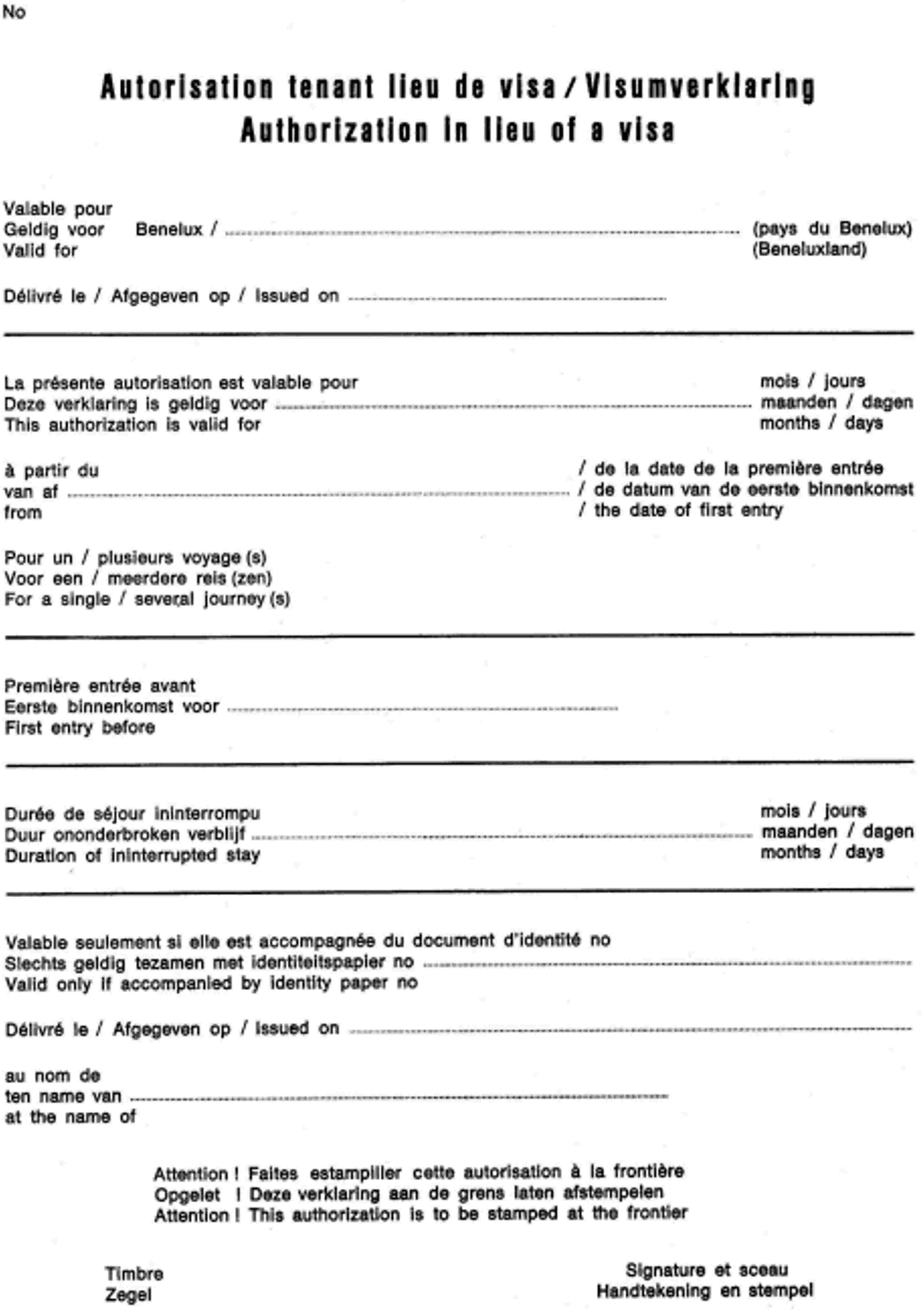

DENMARK
Denmark does not use separate sheets when issuing visas. If there is not enough space to affix a visa sticker on a travel document, the applicant is asked to apply for a new passport.
GERMANY

GREECE
|
1. |
AIRPORT SECURITY SERVICE PASSPORT OFFICE No… TRANSIT/NORMAL VALID FOR …DAYS Affixation of stamp to the value of GDR... to enter the territory without a visa Head of National Security… DUTY OFFICER |
|
2. |
AIRPORT SECURITY SERVICE PASSPORT OFFICE No… TRANSIT/NORMAL VALID FOR … DAYS Affixation of stamp to the value of GDR.……. to enter the territory without a visa Head of National Security… DUTY OFFICER |
SPAIN
If there is insufficient space in the travel document, the following may be used: either a laissez passer (as is the case in France) or a blank page of a passport from the issuing State, given the uniform nature of the Community passport.
FRANCE
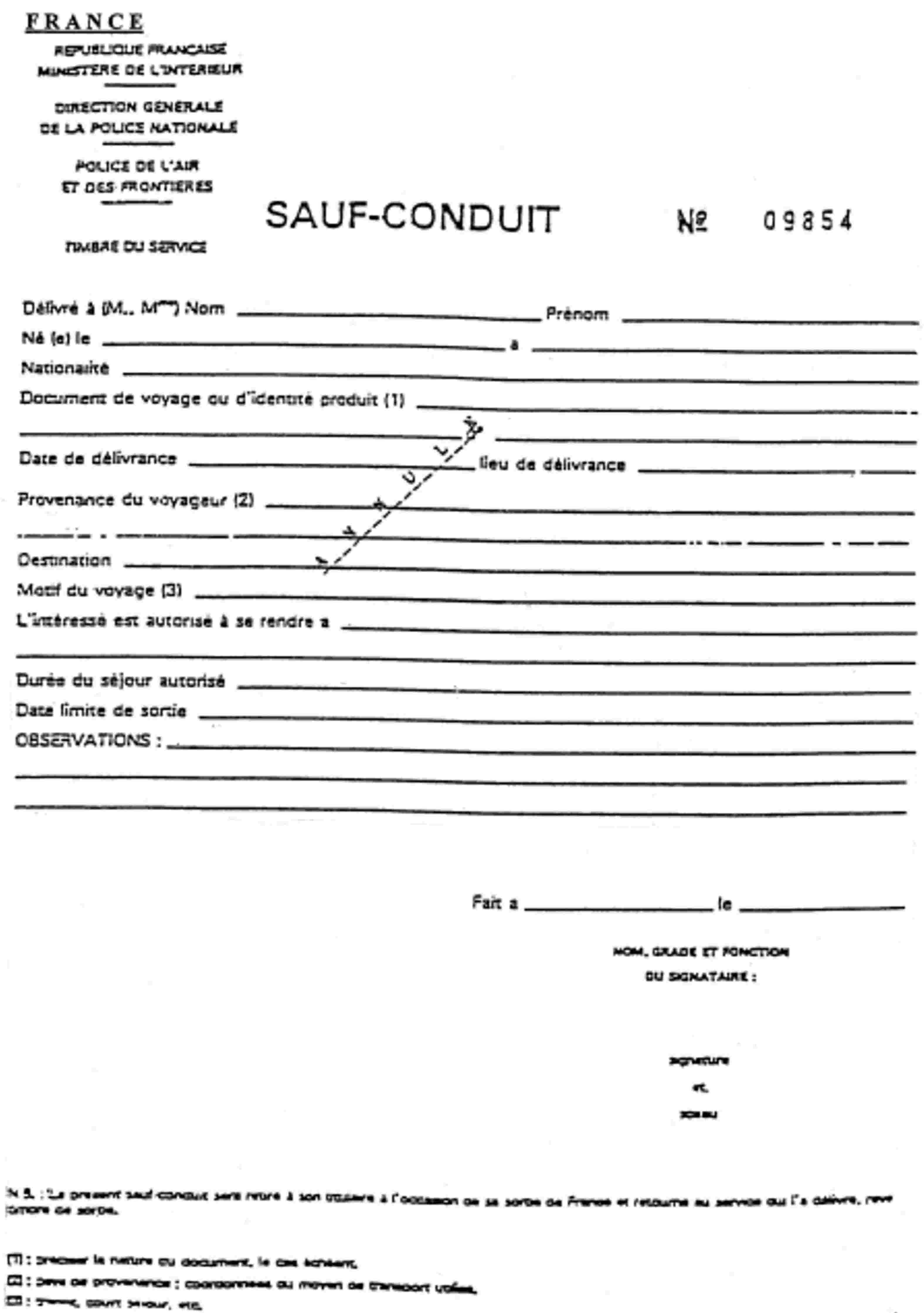
ITALY

LUXEMBOURG


NETHERLANDS



AUSTRIA
Such documents do not exist in Austria.
PORTUGAL

FINLAND
Such documents do not exist in Finland.
SWEDEN
Sweden does not use separate sheets for affixing visa stickers.
ICELAND
Such documents are not used in Iceland.
NORWAY
Such documents are not used in Norway.
ANNEX 13
Specimen cards issued by the Ministry of Foreign Affairs
INDEX
| BELGIUM | page 245 |
| DENMARK | page 258 |
| GERMANY | page 262 |
| GREECE | page 274 |
| SPAIN | page 276 |
| FRANCE | page 296 |
| ITALY | page 306 |
| LUXEMBOURG | page 309 |
| NETHERLANDS | page 312 |
| AUSTRIA | page 314 |
| PORTUGAL | page 316 |
| FINLAND | page 320 |
| SWEDEN | page 324 |
| ICELAND | page 325 |
| NORWAY | page 327 |
BELGIUM
Specimen I — colour: yellow
Front

Back
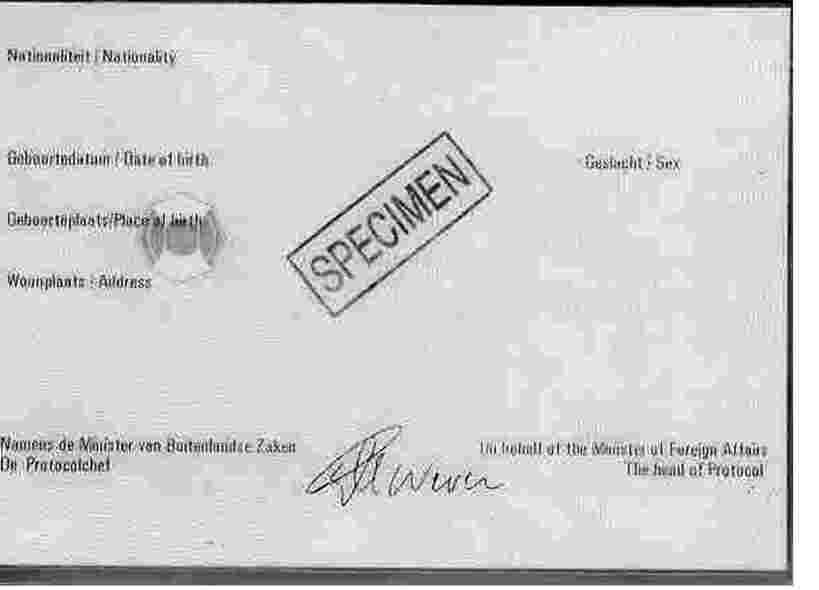




Specimen II — colour: green
Front

Back


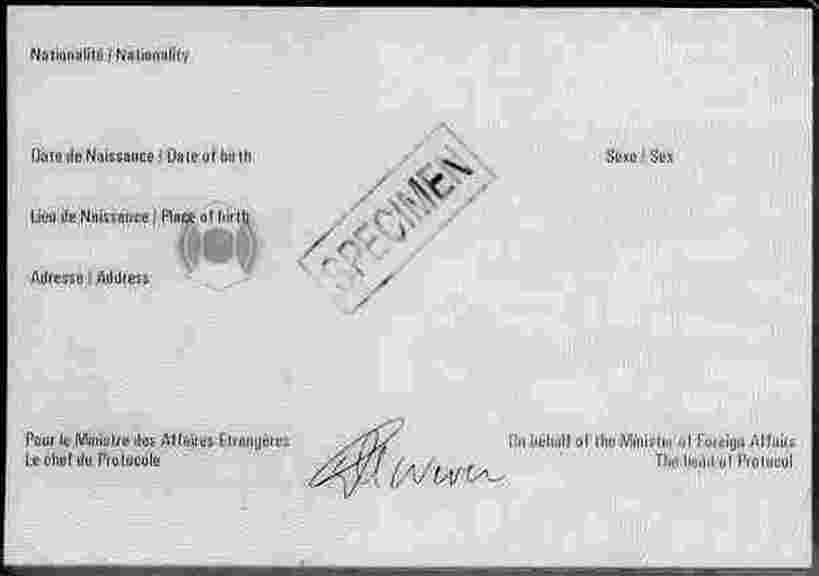
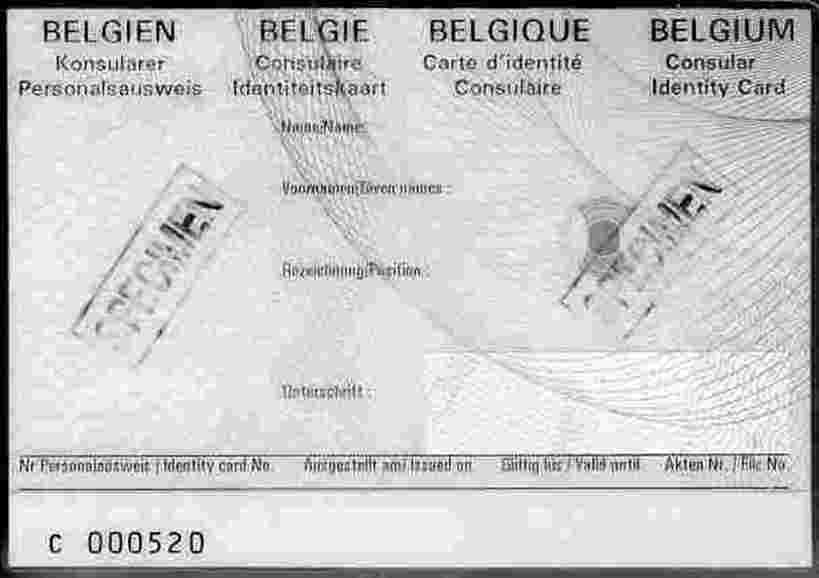

Specimen III — colour: blue
Front

Back





Specimen IV — colour: red
Front

Back

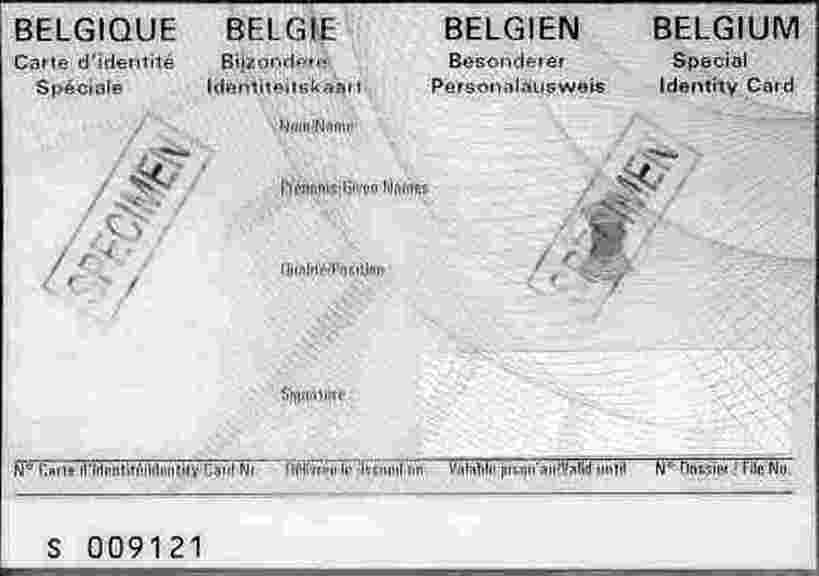




DENMARK
Stickers
|
— |
Sticker E (pink/white sticker) Diplomatisk visering/Diplomatic residence permit - issued to accredited diplomats and their family members, and to staff of international organisations in Denmark of equivalent rank. Valid for stay and multiple entries, so long as the individual remains diplomatically accredited in Copenhagen.
|
|
— |
Sticker F (pink/white sticker). Opholdstilladelse/Residence permit — issued to technical/administrative staff in post and to their family members, and to diplomats' household staff holding service passports from the Ministry of Foreign Affairs of the country of origin. Also issued to staff of international organisations in Denmark of equivalent rank. Valid for stay and multiple entries, for as long as the posting lasts.
|
|
— |
Sticker S (pink/white sticker)(combined with sticker E or F). Residence permit for accompanying close relatives if included in the passport.
|
Identity cards
|
— |
Red cards
|
|
— |
Green cards
|
|
— |
White cards
|
It should be noted that the identity cards issued by the Ministry of Foreign Affairs to foreign diplomats, technical/administrative staff, domestic staff, etc., do not give entitlement to entry without a visa, since these identity cards are not proof of possession of a Danish residence permit.
GERMANY
Identity cards issued to members of diplomatic and consular authorities and international organisations
|
1. |
The Ministry of Foreign Affairs (protocol section) issues the following identity cards to diplomatic staff on request:
|
|
2. |
The Ministry of Foreign Affairs (protocol section) also issues the following documents on request:
|
|
3. |
The competent authorities at Länder level issue the following documents on request:
|
New residence permits in card format (identity card format) issued by the Ministry of Foreign Affairs:
|
— |
Diplomatenausweis (diplomatic identity card) and - Diplomatenausweis Art. 38 WÜD (diplomatic identity card pursuant to Article 38 of the Vienna Convention on Diplomatic Relations)
|
|
— |
Protokollausweis für Verwaltungspersonal (protocol pass for administrative staff)
|
|
— |
Protokollausweis für dienstliches Hauspersonal (protocol pass for service staff)
|
|
— |
Protokollausweis für Ortskräfte (protocol pass for local staff)
|
|
— |
Protokollausweis für privates Hauspersonal (protocol pass for private domestic staff)
|
|
— |
Sonderausweis für Mitarbeiter internationaler Organisationen (Special card issued to members of staff of international organisations)
|
The respective privileges are indicated on the back of the pass.
GREECE
Administrative staff

Consular staff

Diplomatic staff

Staff of international organisations

Service staff

SPAIN
Passes issued by the Ministry of Foreign Affairs to persons accredited in Spain to embassies and consulates
Pass 1 (red)
Special pass with the following inscription
|
‘Cuerpo diplomático’ |
‘ Diplomatic Corps ’ |
|
‘Embajador’ |
‘ Ambassador ’ |
|
‘Documento de identidad’ |
‘ Identity Document ’ |
issued by the Ministry of Foreign Affairs to all ambassadors accredited to the Kingdom of Spain.

Passes 2 and 3 (red)
Special passes with the following inscription
|
‘Cuerpo diplomático’ |
( Diplomatic Corps ) |
|
‘Documento de identidad’ |
( Identity Document ) |
issued by the Ministry of Foreign Affairs to staff accredited to all diplomatic missions who have diplomatic status.

The indication ‘F’ is included on the pass of the spouse and children aged between 12 and 23.

Passes 4 and 5 (yellow)
Special passes with the following inscription
|
‘Misiones diplomáticas’ |
( Diplomatic Missions ) |
|
‘Personal administrativo y técnico’ |
( Administrative and Technical Staff ) |
|
‘Documento de identidad’ |
( Identity Document ) |
issued by the Ministry of Foreign Affairs to administrative officials in all accredited diplomatic missions, excluding Spanish nationals and ordinary residents.
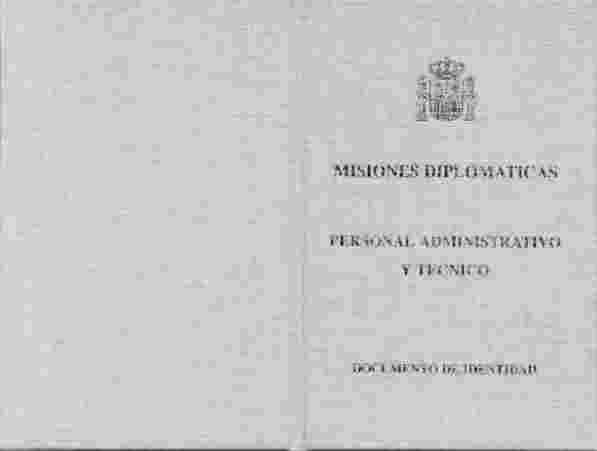
The indication ‘F’ is included on the pass of the spouse and children aged between 12 and 23.

Passes 6 and 7 (red)
Special passes with the following inscription
|
‘Tarjeta de identidad’ |
( Identity Document ) |
issued by the Ministry of Foreign Affairs to accredited staff with certain privileges in the Office of the Palestinian General Mission.
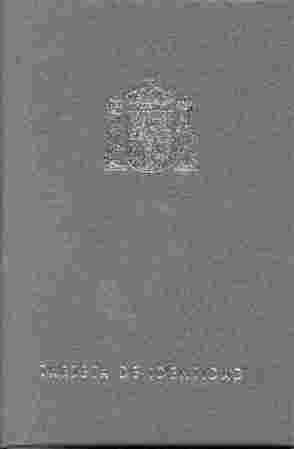
The indication ‘F’ is included on the pass of the spouse and children aged between 12 and 23.

Passes 8 and 9 (red)
Special passes with the following inscription
|
‘Tarjeta diplomática de identidad’ |
( Diplomatic Identity Pass ) |
issued by the Ministry of Foreign Affairs to staff who have diplomatic status at the Office of the League of Arab Nations.

The indication ‘F’ is included on the pass of the spouse and children aged between 12 and 23.

Passes 10 and 11 (red)
Special passes with the following inscription
|
‘Organismos internacionales’ |
( International Organisations ) |
|
‘Estatuto diplomático’ |
( Diplomatic Status ) |
|
‘Documento de identidad’ |
( Identity Document ) |
issued by the Ministry of Foreign Affairs to staff who have diplomatic status accredited to international organisations.

The indication ‘F’ is included on the pass of the spouse and children aged between 12 and 23.
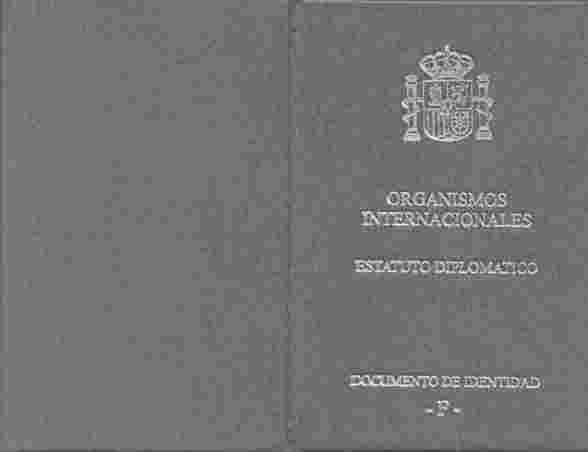
Passes 12 and 13 (blue)
Special passes with the following inscription
|
‘Organismos internacionales’ |
( International Organisations ) |
|
‘Personal administrativo y técnico’ |
( Administrative and Technical Staff ) |
|
‘Documento de identidad’ |
( Identity Document ) |
issued by the Ministry of Foreign Affairs to administrative officials accredited to international organisations.

The indication ‘F’ is included on the pass of the spouse and children aged between 12 and 23.
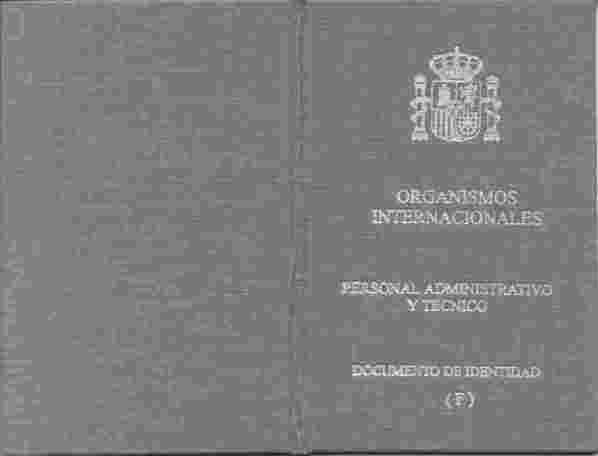
Passes 14 and 15 (green)
Special passes with the following inscription
|
‘Funcionario consular de carrera’ |
( Career Consular Official ) |
|
‘Documento de identidad’ |
( Identity Document ) |
issued by the Ministry of Foreign Affairs to career consular officials accredited in Spain.

The indication ‘F’ is included on the pass of the spouse and children aged between 12 and 23.

Passes 16 and 17 (green)
Special passes with the following inscription
|
‘Empleado consular’ |
( Consular Employee ) |
|
‘Expedido a favor de …’ |
( Issued to … ) |
|
‘Documento de identidad’ |
( Identity Document ) |
issued by the Ministry of Foreign Affairs to consular administrative officials accredited in Spain.

The indication ‘F’ is included on the pass of the spouse and children aged between 12 and 23.

Passes 18 and 19 (grey)
Special passes with the following inscription
|
‘Personal de servicio’ |
( Service Staff ) |
|
‘Misiones diplomáticas, oficinas consulares y organismos internacionales’ |
( Diplomatic Missions, Consular Posts and International Organisations ) |
|
‘Expedido a favor de …’ |
( Issued to … ) |
|
‘Documento de identidad’ |
( Identity Document ) |
issued by the Ministry of Foreign Affairs to service staff in diplomatic missions, consular posts and international organisations and career diplomatic or consular staff (private domestic staff).
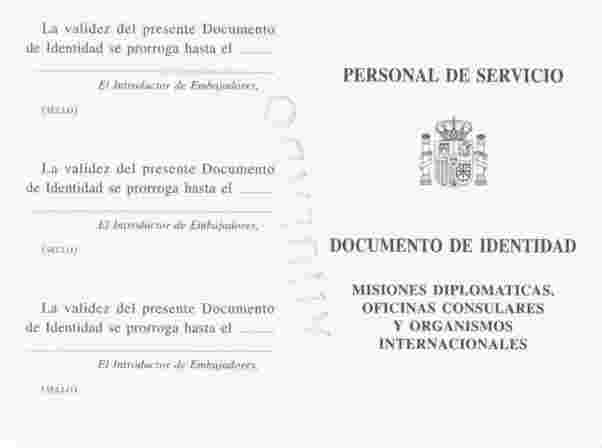
The indication ‘F’ is included on the pass of the spouse and children aged between 12 and 23.
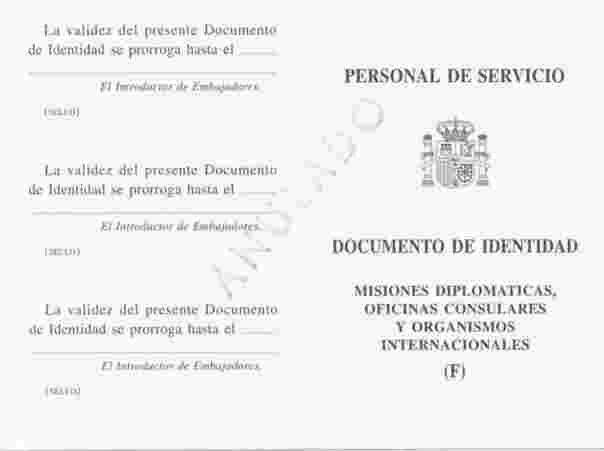
General features
|
1. |
Documents 1 to 15
|
|
2. |
Documents 16 to 19
|
FRANCE
white
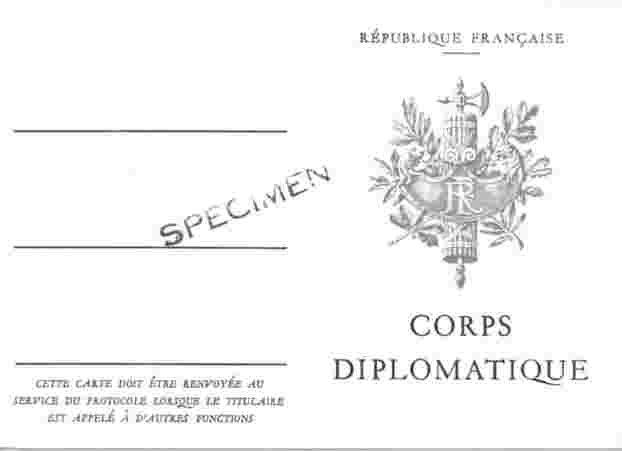

orange


white

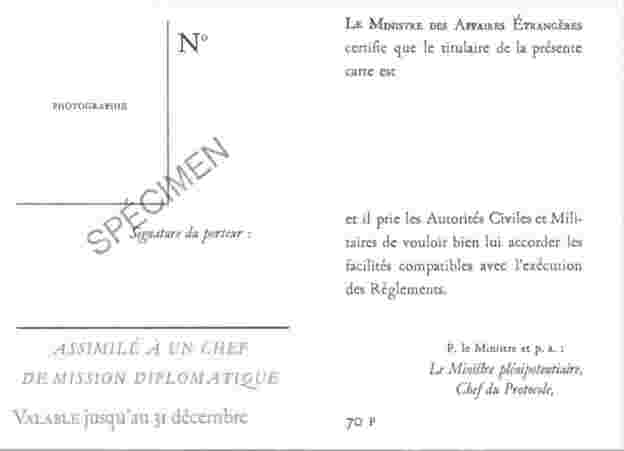
blue


green


green
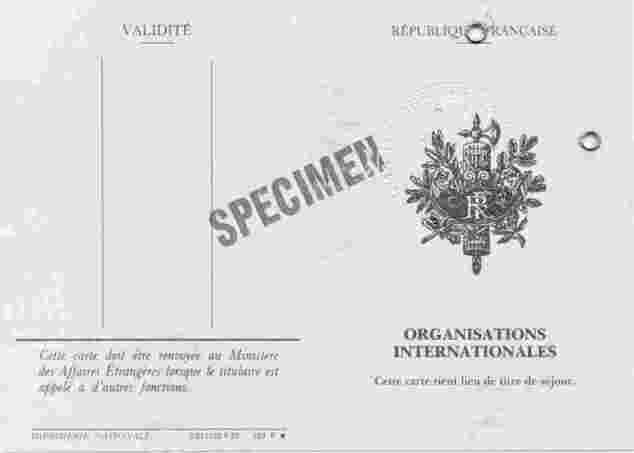
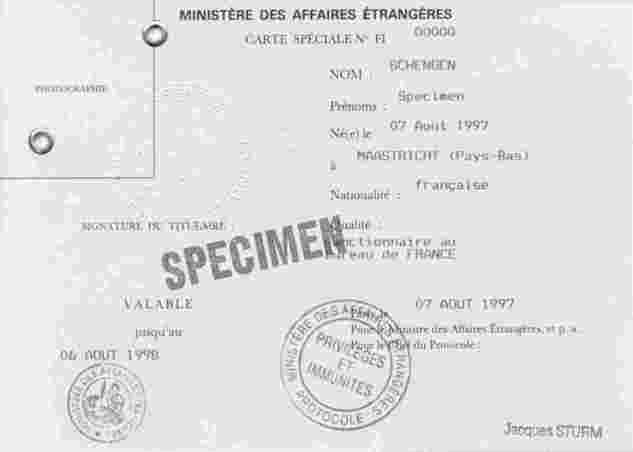
beige
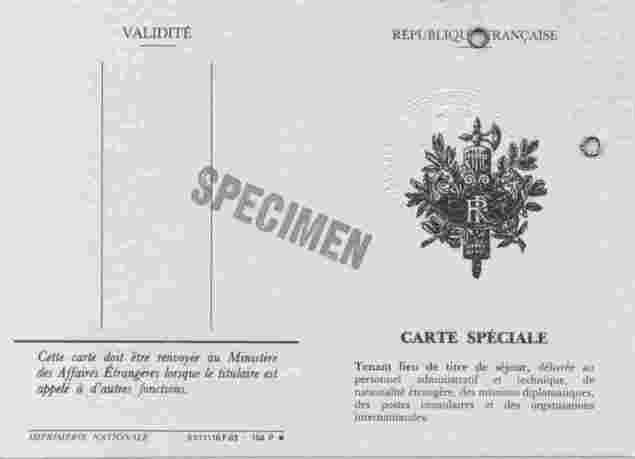

grey

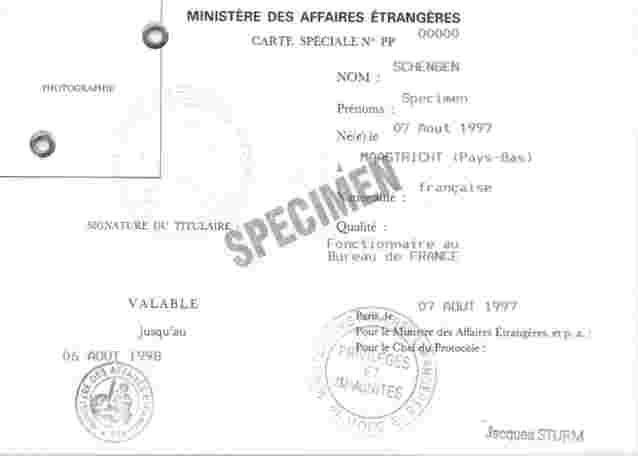
grey
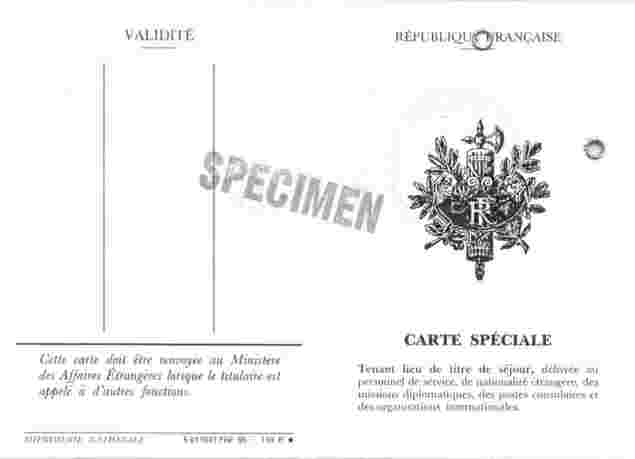

blue-grey


ITALY
Identity card No 1
Identity card — Diplomatic Corps
This is the identity card issued by the Ministry of Foreign Affairs (Protocol Section) to members of the diplomatic corps.
This identity card, which bears a photograph of the holder and states its validity on the back, is a document providing identification in all the situations laid down by law and exempts the holder from the compulsory registration of residence with the authorities.

Identity card No 2
Identity card — international organisations and special foreign missions
This is the identity card issued by the Ministry of Foreign Affairs (Protocol Section) to staff of international organisations and special foreign missions.
This identity card, which bears a photograph of the holder and states its validity on the back, covers the duration of the assignment and is issued for a maximum period of five years; it is a document providing identification in all the situations laid down by law and exempts the holder from the compulsory registration of residence with the authorities.

Identity card No 3
Identity card — diplomatic representations
This is the identity card issued by the Ministry of Foreign Affairs (Protocol Section) to staff of diplomatic representations.
This identity card, which bears a photograph of the holder and states its validity on the back, covers the duration of the assignment and is issued for a maximum period of two years; it is a document providing identification in all the situations laid down by law and exempts the holder from compulsory registration of residence with the authorities.

Identity card No 4
Identity card — consular corps
This is the identity card issued by the Ministry of Foreign Affairs (Protocol Section) to staff of the consular corps.
This identity card, which bears a photograph of the holder and states its validity on the back, covers the duration of the assignment and is issued for a maximum period of five years; it is a document providing identification in all the situations laid down by law and exempts the holder from compulsory registration of residence with the authorities.

Identity card No 5
Identity card — Consulates (consular staff)
This is the identity card issued by the Ministry of Foreign Affairs (Protocol Section) to staff working at consulates abroad.
This identity card, which bears a photograph of the holder and states its validity on the back, is a document providing identification in all the situations laid down by law and exempts the holder from the compulsory registration of residence with the authorities.

Carta d'identità M.A.E. — Corpo diplomatico (Identity card issued by the Ministry of Foreign Affairs)
|
— |
Mod. 1 (blu) Corpo diplomatico accreditato e consorti titolari di passaporto diplomatico (Model 1 (blue) Accredited members of the diplomatic corps and their spouses who hold a diplomatic passport) |
|
— |
Mod. 2 (verde) Corpo consolare titolare di passaporto diplomatico (Model 2 (green) Members of the consular corps who hold a diplomatic passport) |
|
— |
Mod. 3 (arancione) Funzionari II FAO titolari di passaporto diplomatico, di servizio o ordinario (Model 3 (orange) Category II FAO officials who hold a diplomatic, service or ordinary passport) |
|
— |
Mod. 4 (arancione) Impiegati tecnico-amministrativi presso Rappresentanze diplomatiche titolari di passaporto di servizio (Model 4 (orange) Technical and administrative staff of diplomatic representations who hold a service passport) |
|
— |
Mod. 5 (arancione) Impiegati consolari titolari di passaporto di servizio (Model 5 (orange) Consular staff who hold a service passport) |
|
— |
Mod. 7 (grigio) Personale di servizio presso Rappresentanze diplomatiche titolare di passaporto di servizio (Model 7 (grey) Domestic staff of diplomatic representations who hold a service passport) |
|
— |
Mod. 8 (grigio) Personale di servizio presso Rappresentanze Consolari titolare di passaporto di servizio (Model 8 (grey) Domestic staff of consular representations who hold a service passport) |
|
— |
Mod. 11 (beige) Funzionari delle organizzazioni internazionali, consoli onorari, impiegati locali, personale di servizio assunto all'estero e venuto al seguito, familiari corpo diplomatico e organizzazioni internazionali titolari di passaporto ordinario (Model 11 (beige) Officials of international organisations, honorary consuls, local employees, domestic staff recruited abroad who have followed their employer, families of members of the diplomatic corps and international organisations who hold an ordinary passport) |
Note: Models 6 (orange) and 9 (green) for, respectively, staff of international organisations who have no immunity and for foreign honorary consuls, are no longer issued and have been replaced by specimen 11. However, these documents remain valid until the expiry date stated on them.
LUXEMBOURG
yellow
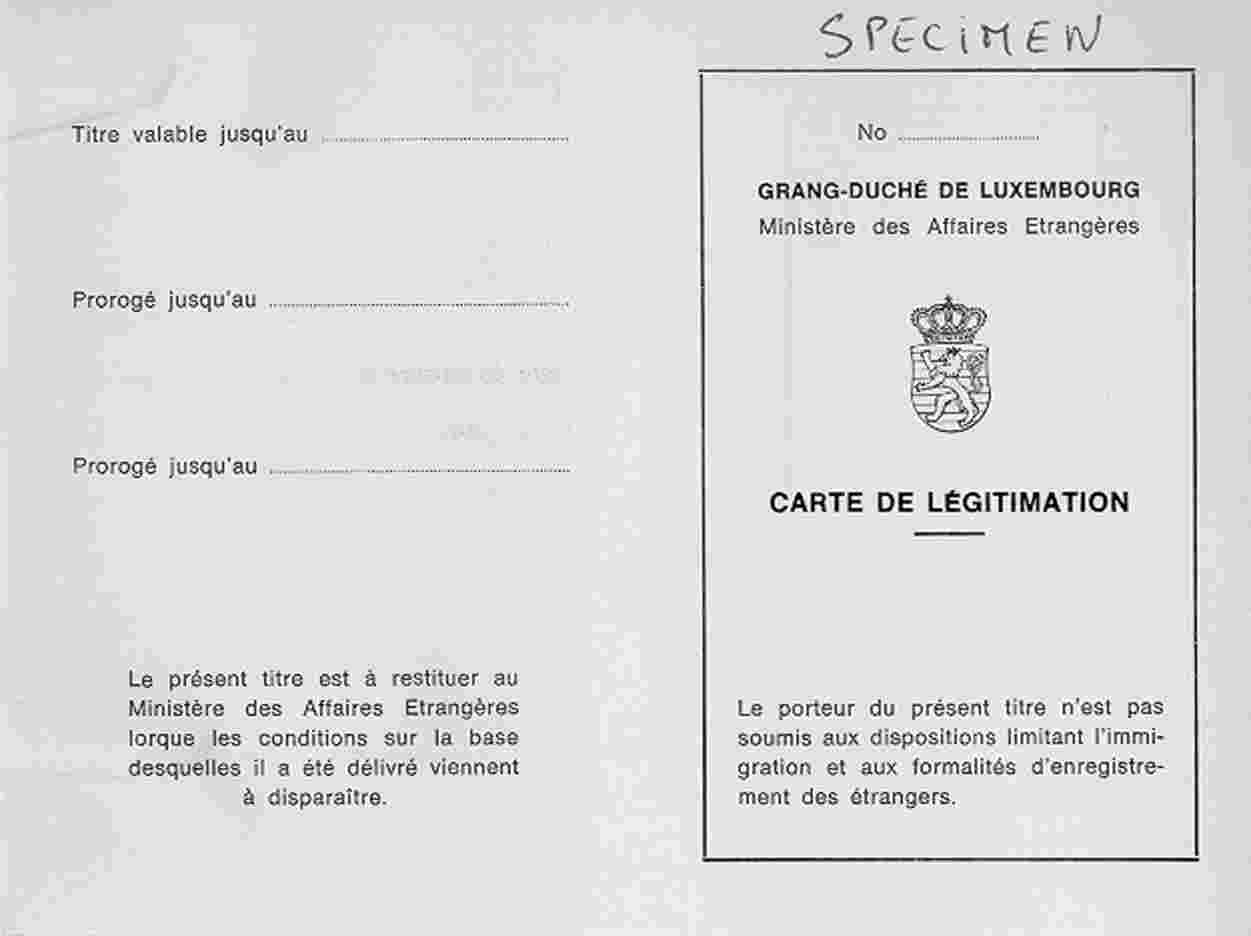

blue
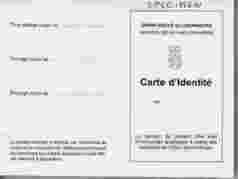

blue
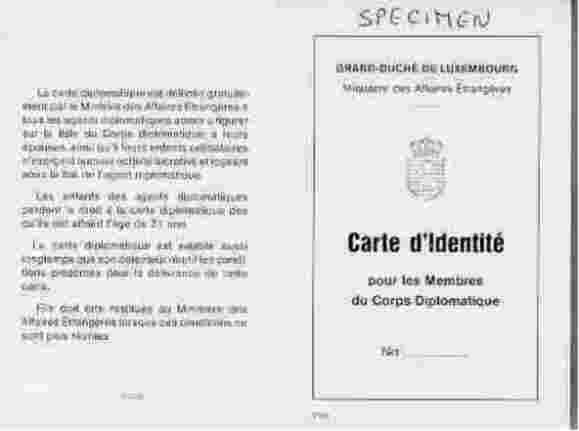
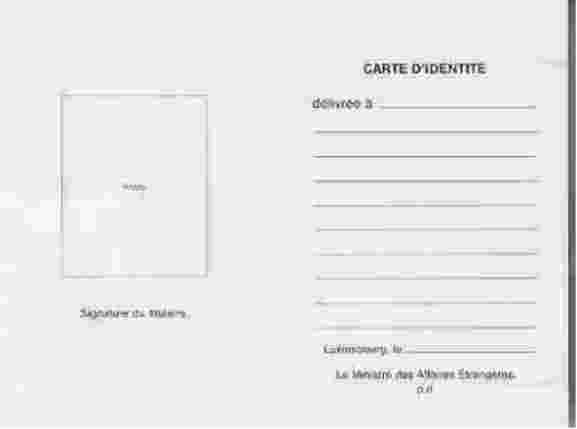
NETHERLANDS
Statuses
Each privileged person is assigned a status indicating to which category of privileged persons he or she belongs. This status is shown on the Privileged Persons document by means of a code.
The following codes are used:
Embassies
|
STATUS |
CODE |
|
diplomatic staff |
AD |
|
technical and administrative staff |
BD |
|
service staff |
ED |
|
rivate domestic staff |
PD |
Consulates
|
STATUS |
CODE |
|
consular staff |
AC |
|
technical and administrative staff |
BC |
|
service staff |
EC |
|
private domestic staff |
PC |
International organisations in the Netherlands
|
STATUS |
CODE |
|
staff treated as diplomatic staff |
AO |
|
technical and administrative staff |
BO |
|
service staff |
EO |
|
private domestic staff |
PO |
Special cases
Where identity documents are issued to Dutch nationals or aliens permanently resident in the Netherlands, the following codes are added to the indication of residence status:
|
— |
NL for Dutch nationals, |
|
— |
DV for permanent residents. |


AUSTRIA
Specimen cards Issued by the Ministry of Foreign Affairs
Identity cards for persons who enjoy special privileges and immunities
The Federal Ministry of Foreign Affairs issues identity cards, specimens of which are set out in the Annex, in the following colours:
|
— |
red identity cards for persons who have diplomatic status in Austria and their family members, |
|
— |
yellow identity cards for consuls and their family members, |
|
— |
blue identity cards for all other persons who enjoy special privileges and immunities in Austria and their family members. |
Red identity card for persons who have diplomatic status in Austria and their family members

Yellow identity card for consuls and their family members

Blue identity card for all other persons who enjoy special privileges and immunities in Austria and their family members
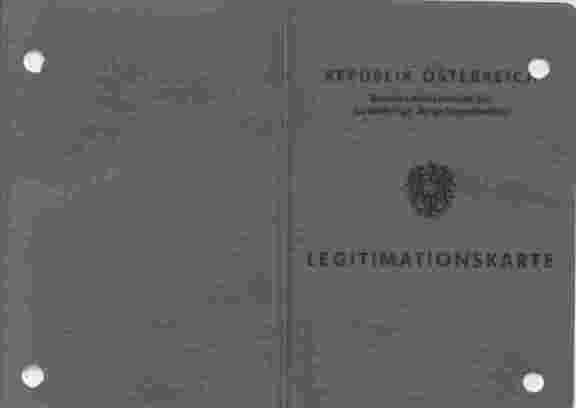
PORTUGAL






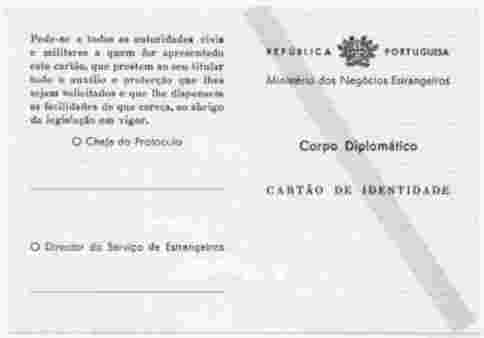
FINLAND
A. Members of the diplomatic staff and their family members (blue)
Front
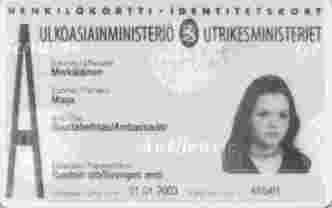
Back
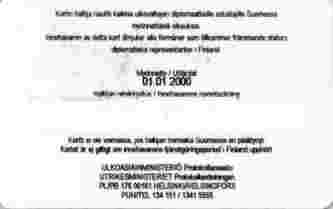
B. Members of the administrative and technical staff of missions and their family members (red)
Front

Back

C. Members of the service staff of missions (drivers, housekeepers, cooks, etc.) (yellow)
Front

Back

D. Others (brown)
Front
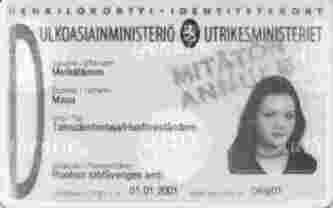
Back
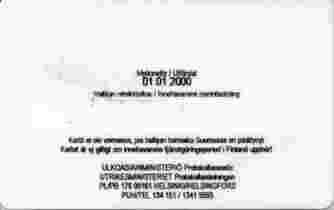
SWEDEN
Colour: blue and pink
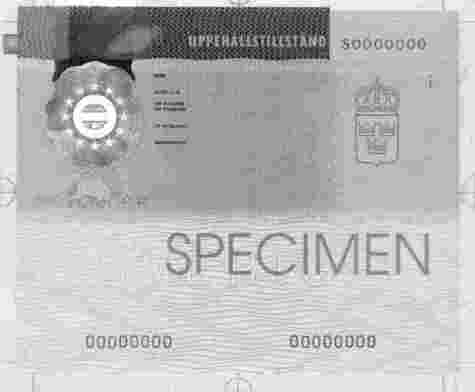
Colour: blue and brown

ICELAND
The Ministry of Foreign Affairs issues the following identity cards to members of diplomatic and consular authorities:
|
|
Blue identity card (see specimen)
Front
Back
|
|
|
Yellow diplomatic identity card (see specimen)
Front
Back
|
NORWAY
Diplomatic identity card (orange)
Front

Back

Identity card for honorary consuls (pink)
Front

Back

Identity card for administrative and technical staff of diplomatic representations (blue)
Front

Back

Identity card for consular officials (green)
Front

Back
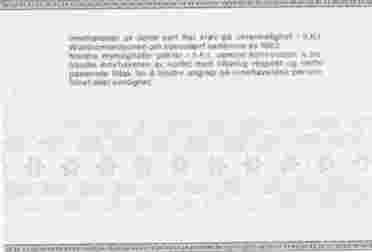
Identity card for diplomatic representations (brown)
Front

Back

Residence/Visa sticker

ANNEX 14
Issue of uniform visas at borders
This document corresponds to the Decision adopted by the Executive Committee on 26 April 1994 (SCH/Com-ex (94) 2)
ANNEX ON THE ISSUE OF UNIFORM VISAS AT BORDERS
|
1. |
Article 12(1) of the Schengen Convention provides for uniform visas to be issued by the diplomatic and consular authorities of the Contracting Parties and, where appropriate, by the authorities designated under Article 17. Article 17(3)(c) provides in particular for the Executive Committee to take decisions relating to the issue of visas at borders. Furthermore, the Common Manual (part II, point 5) stipulates that if ‘for lack of time and for imperative reasons an alien has not been able to apply for a visa, the competent authorities may, in exceptional cases, issue him with a visa at the border for a short stay’. The issue of visas in such cases is subject to a series of conditions in the Common Manual:
|
|
2. |
It clearly ensues from the above that visas are usually issued by the diplomatic posts and consular missions and that the issue of visas at borders therefore constitutes an exception for specific and duly justified cases. |
|
3. |
Visas issued at borders may, on a case to case basis, depending on national rules and provided the abovementioned conditions are respected, be:
In both of the above cases, the visa issued must not be valid for more than one entry. The validity of short-stay visas must not exceed 15 days. |
|
4. |
An alien in a category of persons subject to consultation of the central authorities of one or more than one other Contracting Party shall not, in principle, be issued with a visa at the border, particularly taking into account the requirement for a minimum deadline for a reply of seven days. Nevertheless a visa may be issued at the border for these categories of persons in exceptional cases. A visa of this kind may only be issued with territorial validity restricted to the State of issue. This visa may only be issued in the cases provided for under Article 5(2) of the Schengen Convention, namely on humanitarian grounds, in the national interest or on account of international obligations. The central authorities of the other Contracting Parties must be notified forthwith of the issue thereof. |
|
5. |
The border control authorities shall issue the visas in accordance with national provisions. In practice, the visa may take the form of a Schengen visa sticker or a special stamp may be affixed. |
|
6. |
Visas issued at borders must be recorded on a list. The Contracting Parties shall exchange these statistics once a month via the General Secretariat. |
ANNEX 14a
Fees to be charged in EUR corresponding to the administrative costs of processing the visa application
This document corresponds to Annex 12 to the Common Consular Instructions on Visas.
Fees to be charged in EUR corresponding to the administrative costs of processing the visa application (1)
|
A. |
Airport transit visas |
EUR 10 |
|
B. |
Transit visas (one, two or multiple entries) |
EUR 10 |
|
C1. |
Very short-stay visas (maximum 30 days) |
EUR 15 to EUR 25 |
|
C2. |
Short-stay visas (maximum 90 days) |
EUR 30 + EUR 5 from the second entry, where the visa is valid for multiple entries |
|
C3. |
Multiple entry visas, valid for one year |
EUR 50 |
|
C4. |
Multiple entry visas, valid for maximum five years |
EUR 50 + EUR 30 for each additional year |
|
D. |
National long-stay visas |
The amount shall be fixed by the Contracting Parties, who may decide to issue these visas free of charge. |
|
— |
Visa with limited territorial validity |
The amount shall be at least equal to 50 % of the amount fixed for category A, B and C visas |
|
— |
Visas issued at the border |
The amount shall be double that of the category of visa issued. These visas may be issued free of charge. |
|
— |
Group visas, categories A and B (5 to 50 persons) |
EUR 10 + EUR 1 per person |
|
— |
Group visas, category C1 (30 days), one or two entries (5 to 50 persons) |
EUR 30 + EUR 1 per person |
|
— |
Group visas, category C1 (30 days), more than two entries (5 to 50 persons) |
EUR 30 + EUR 3 per person |
These fees are to be charged in EUR, in US dollars or in the national currency of the third country where the application is made.
Rules
|
I. |
These fees shall be paid in a convertible currency or in the national currency on the basis of the official exchange rates in application. |
|
II. |
In individual cases, the amount of fees to be charged may be reduced or may be revoked in accordance with national law when this protects cultural interests, in the field of foreign policy, development policy or other areas of vital public interests. |
|
III. |
Group visas are issued in accordance with national law, for a maximum of 30 days. |
(1) Text modified by Council Decision 2002/44/EC (OJ L 20, 23.1.2002, p. 5), see Article 3.
ANNEX 14b
List of visa applications requiring prior consultation with the central authorities, in accordance with Article 17(2)
CONFIDENTIAL
